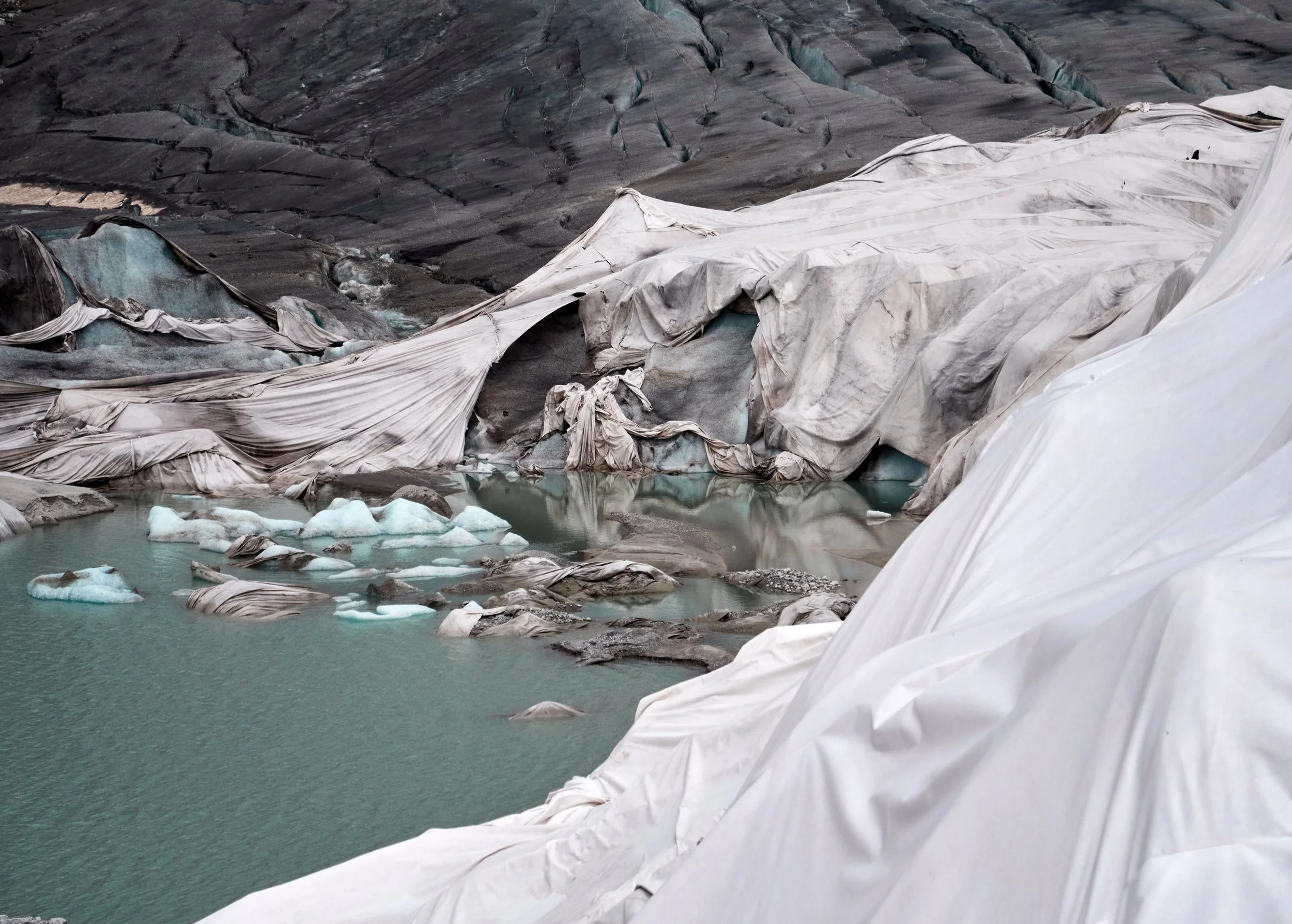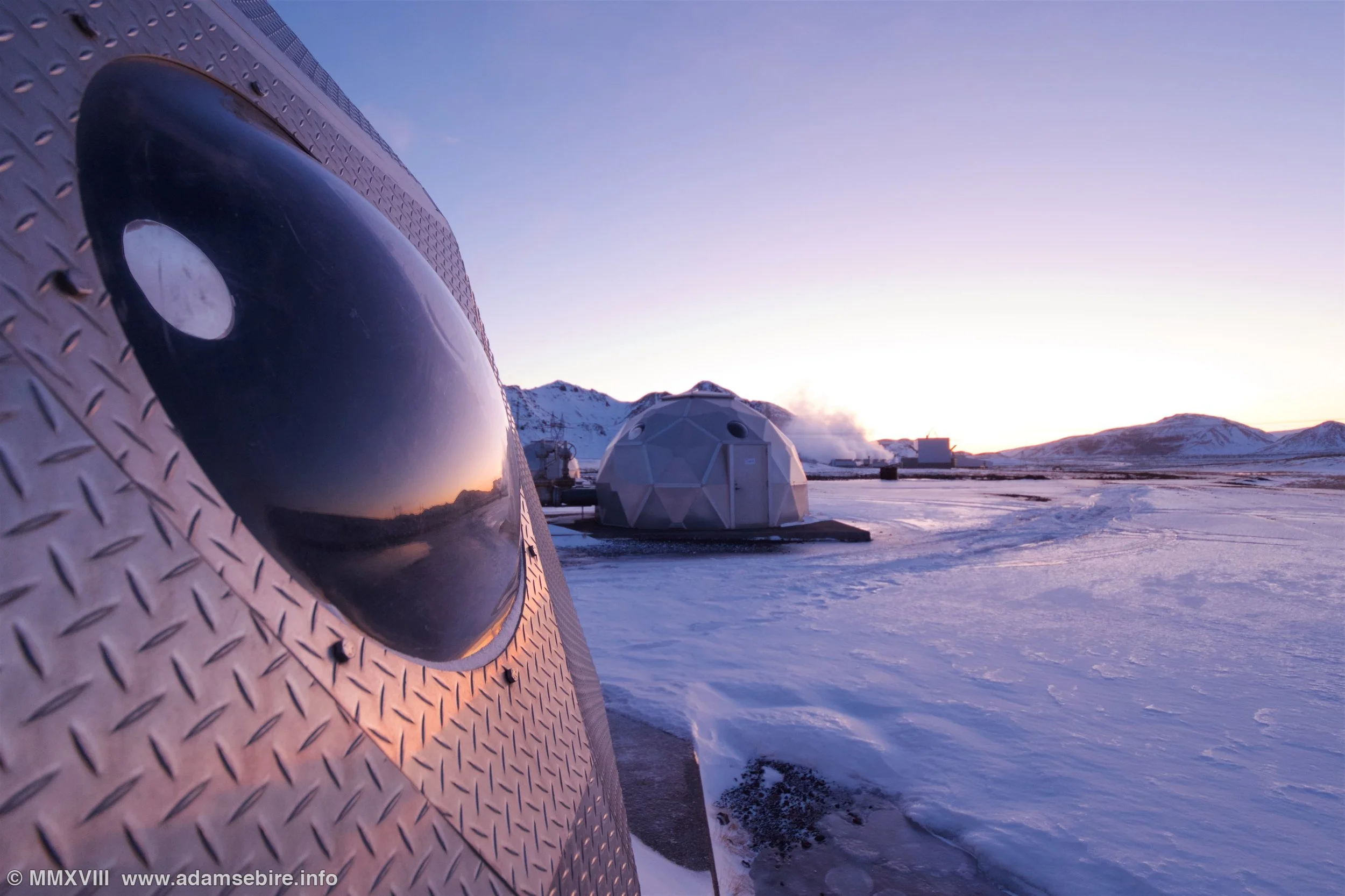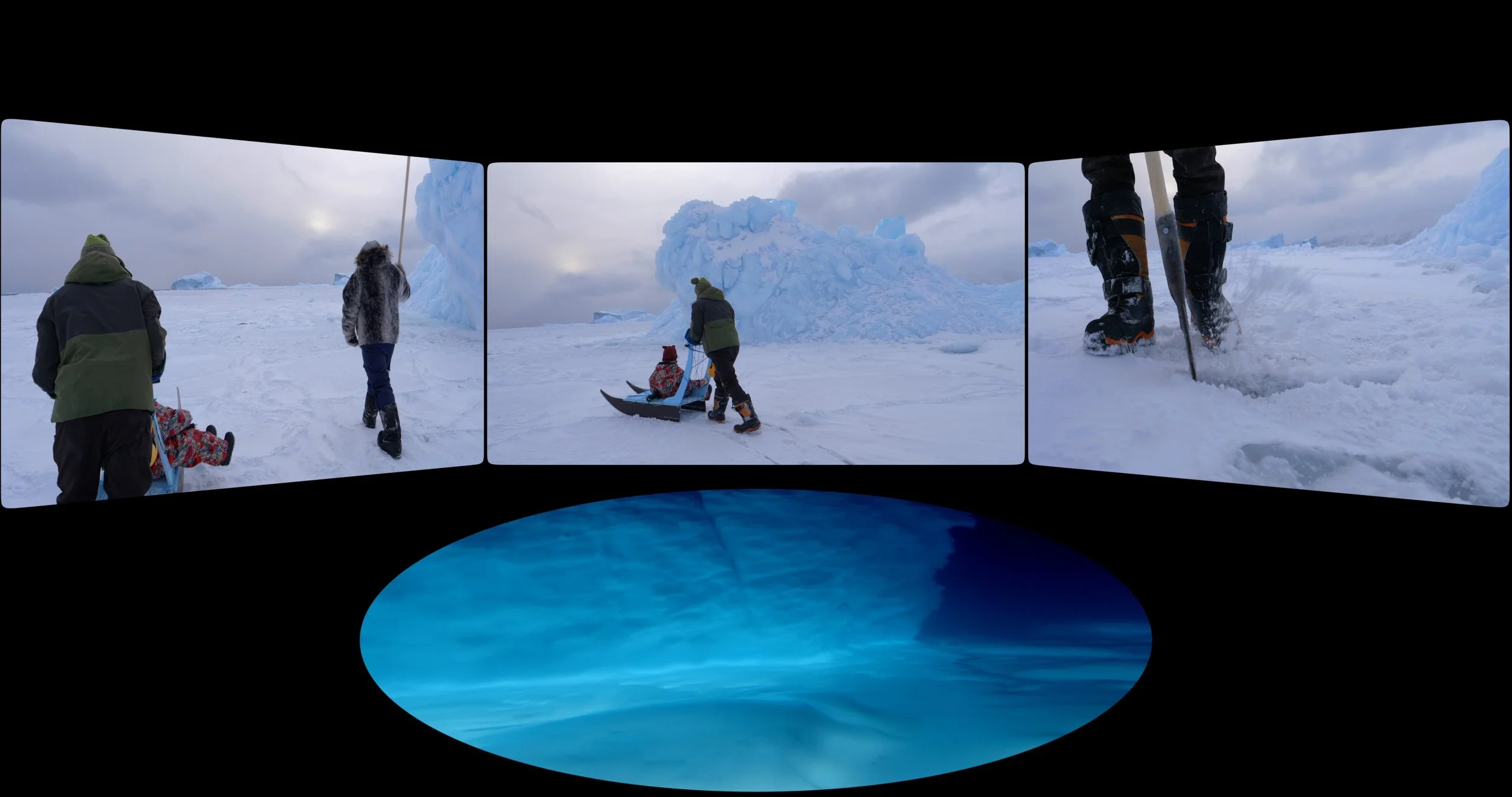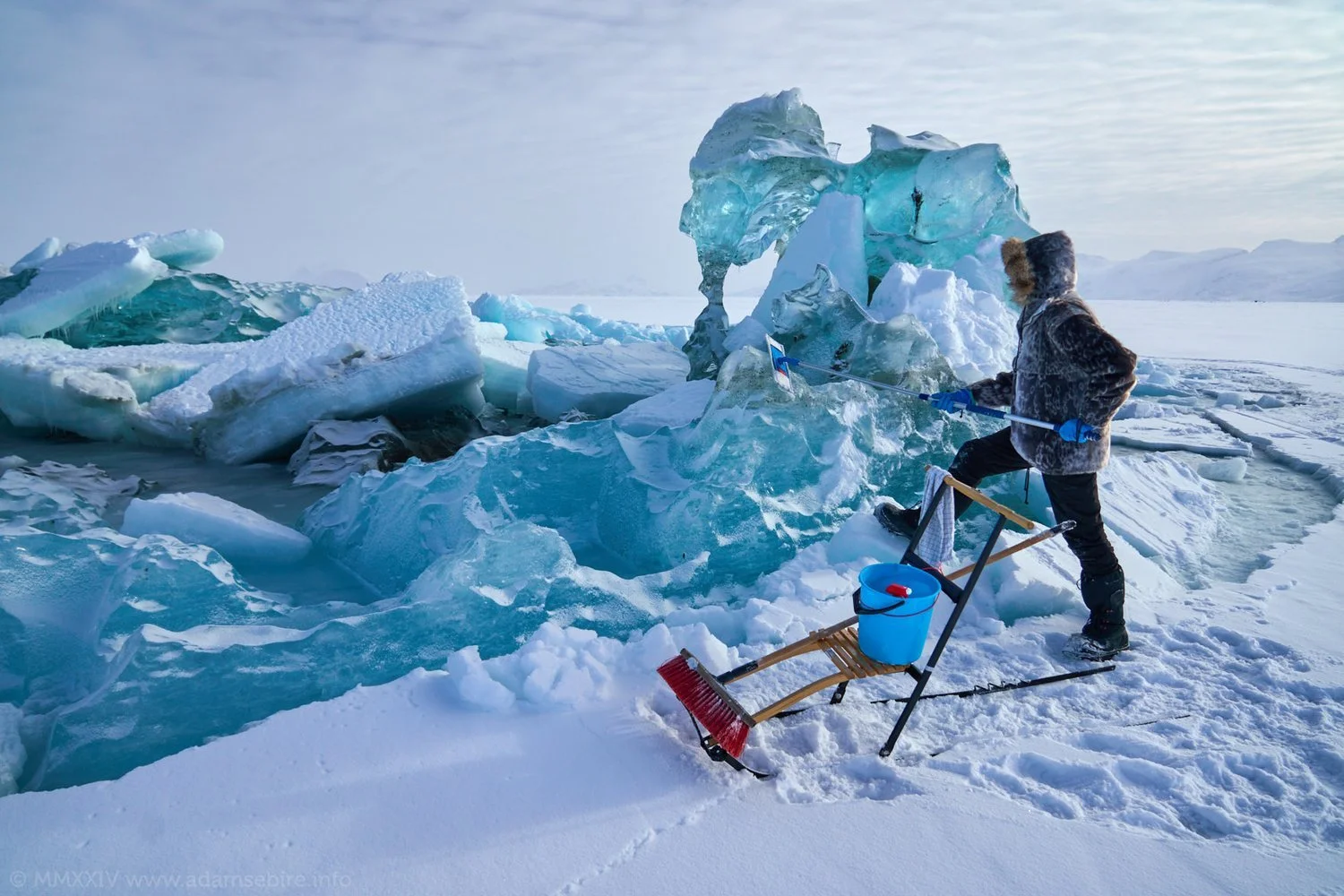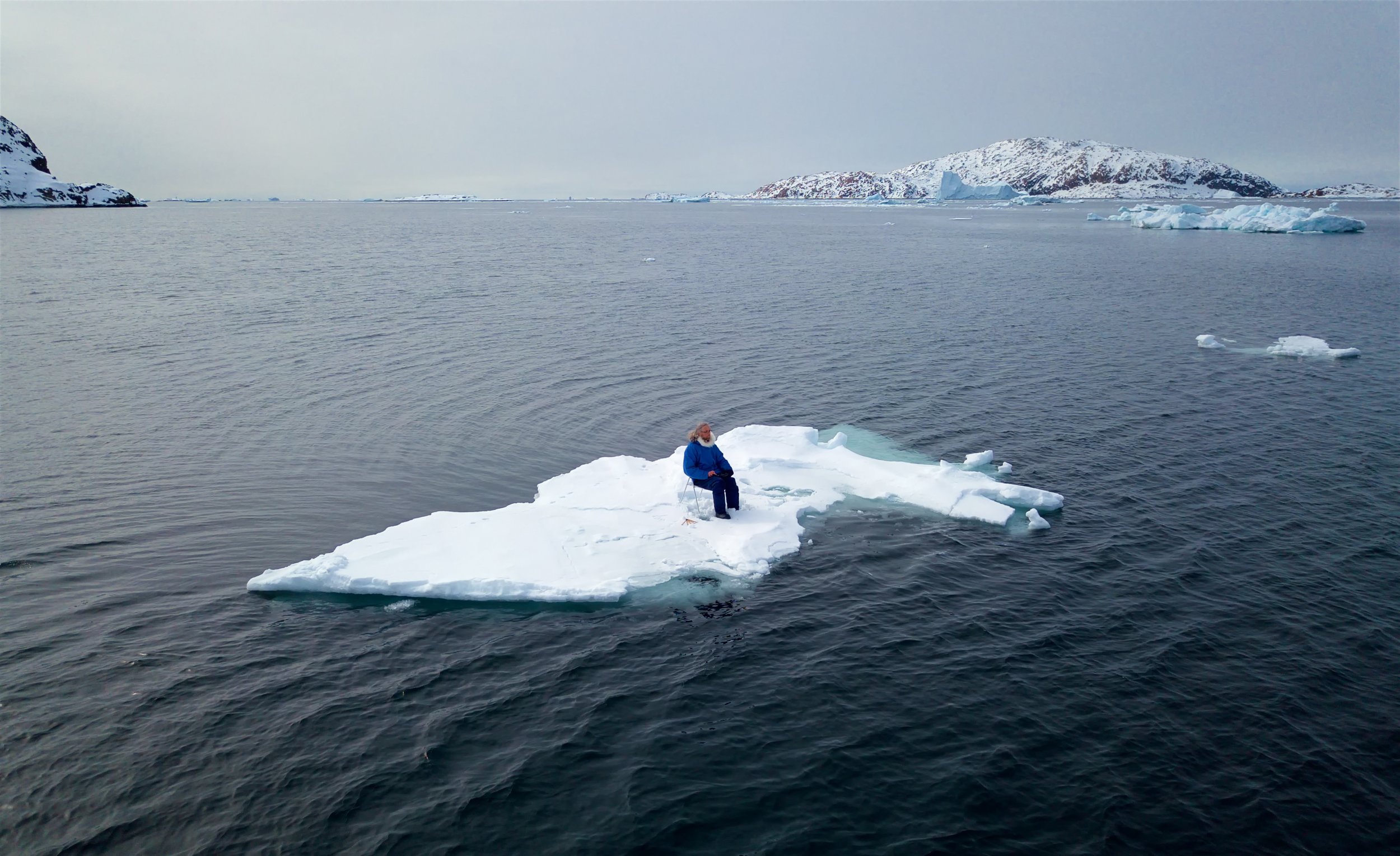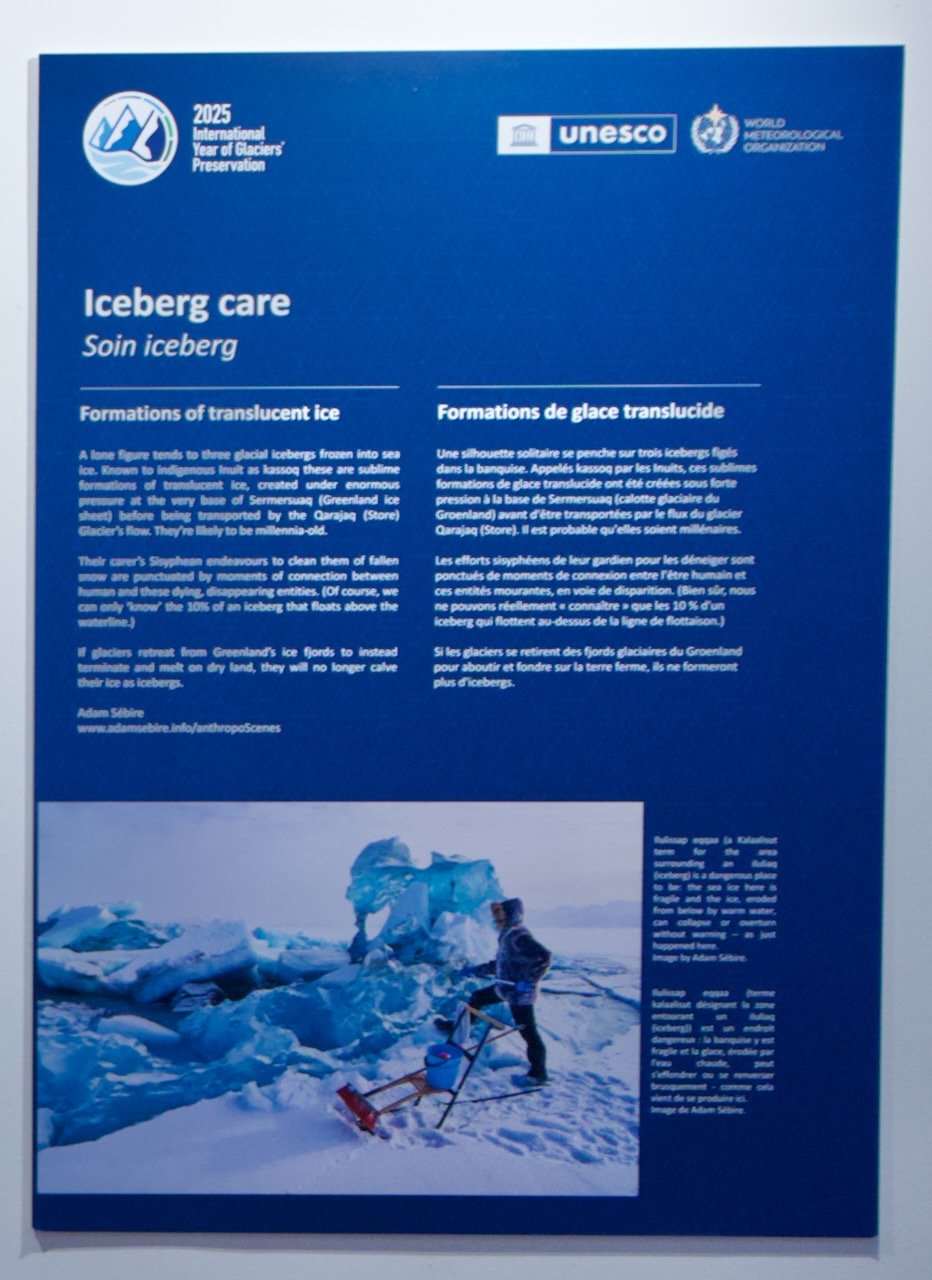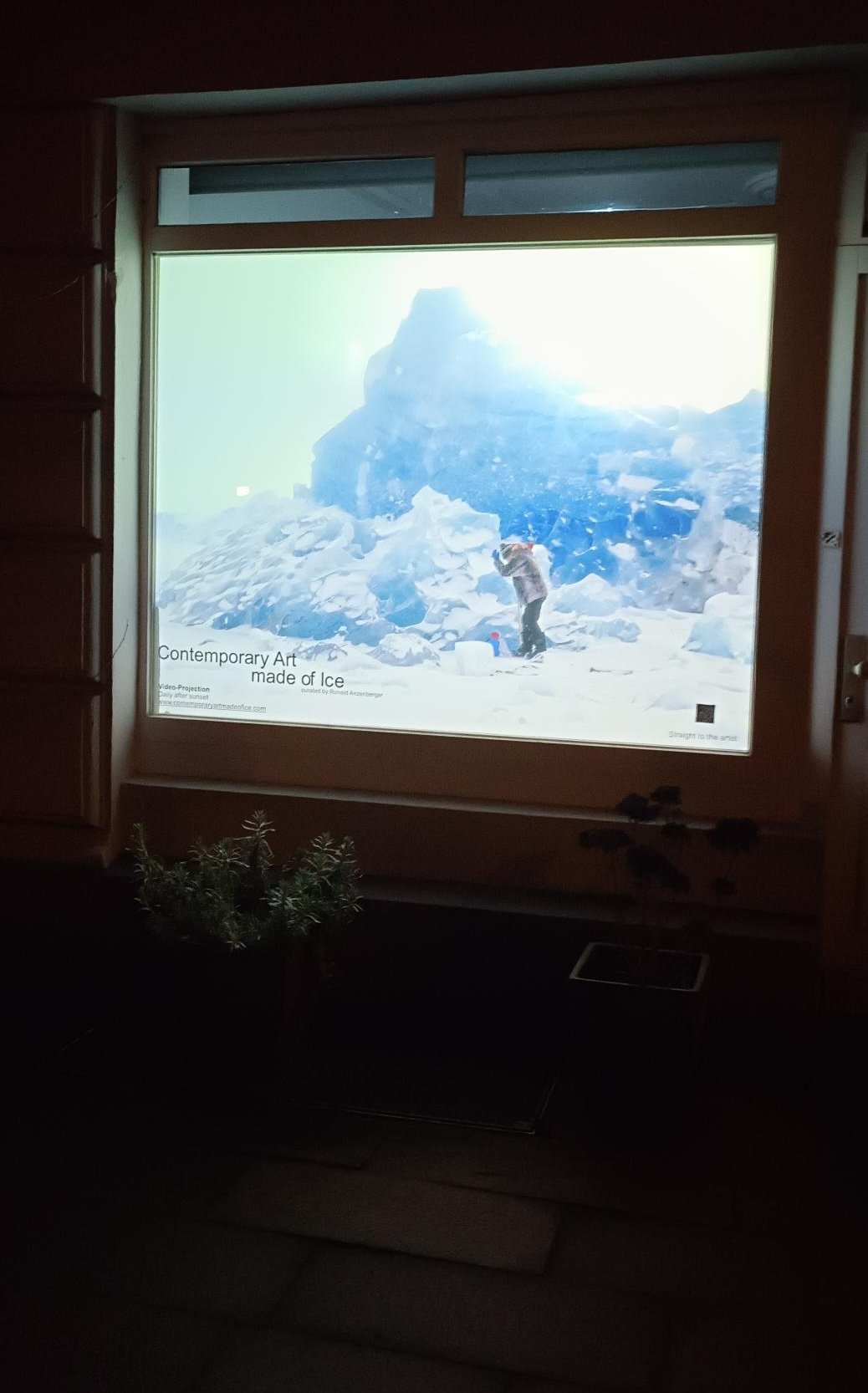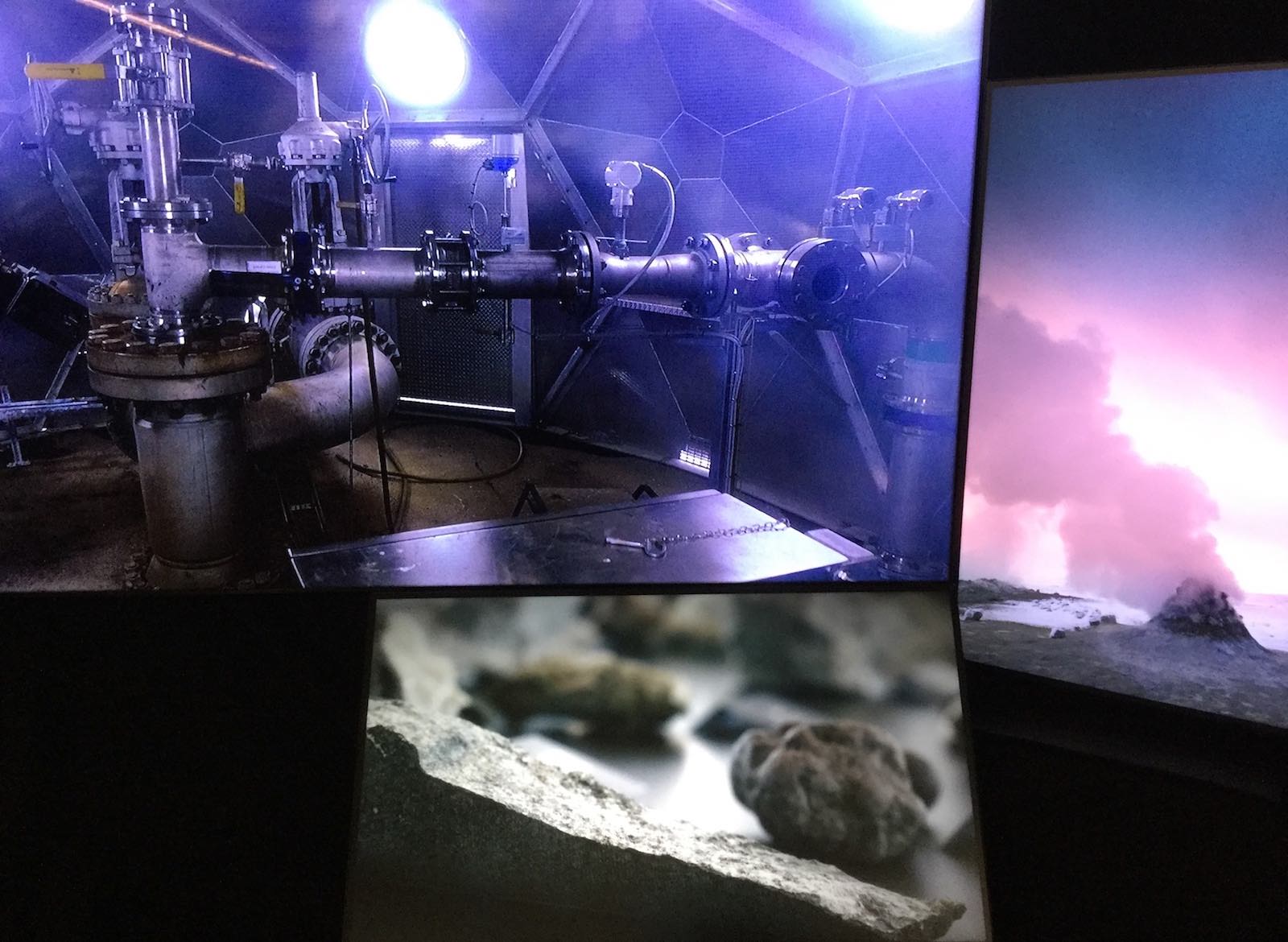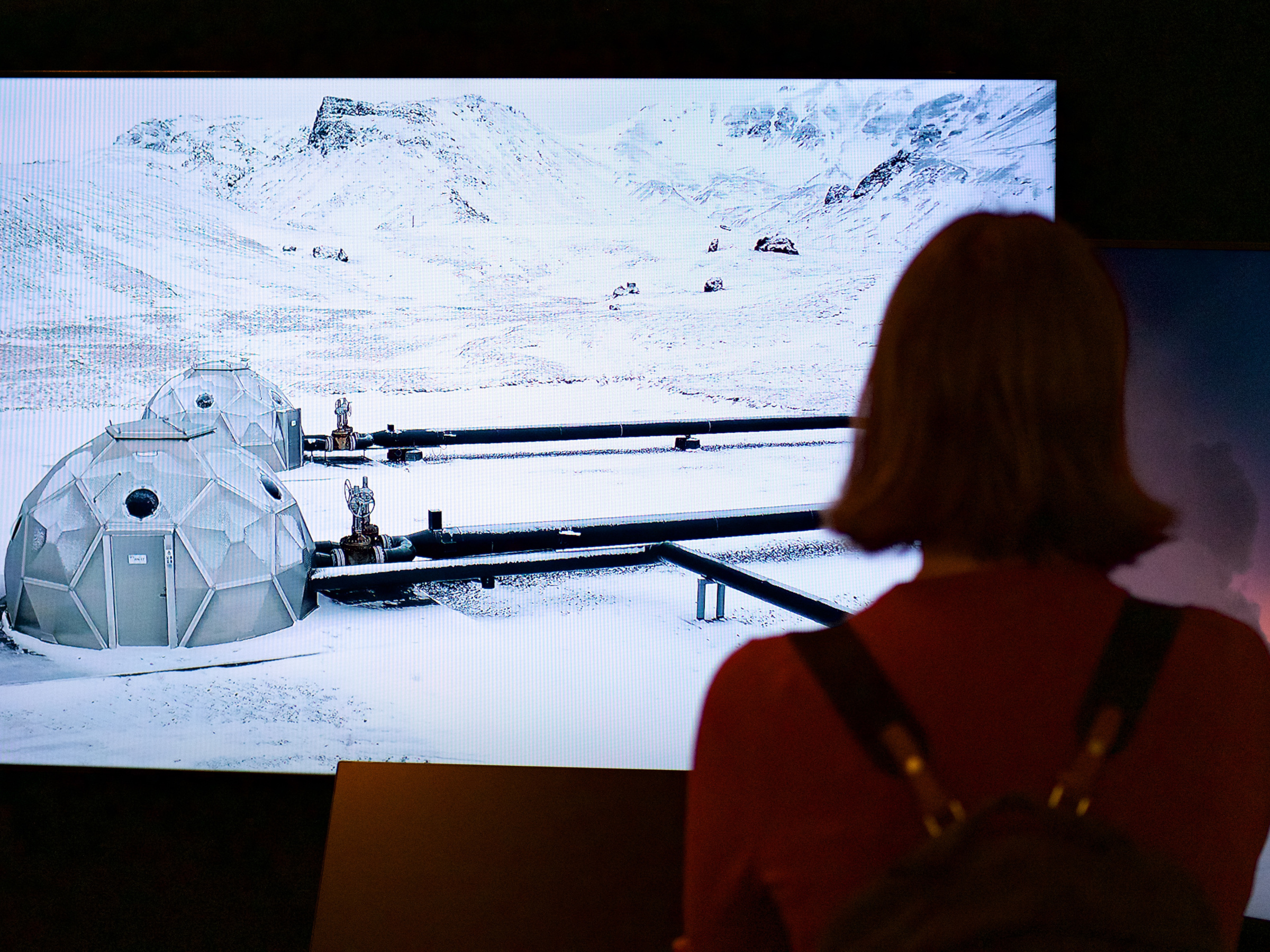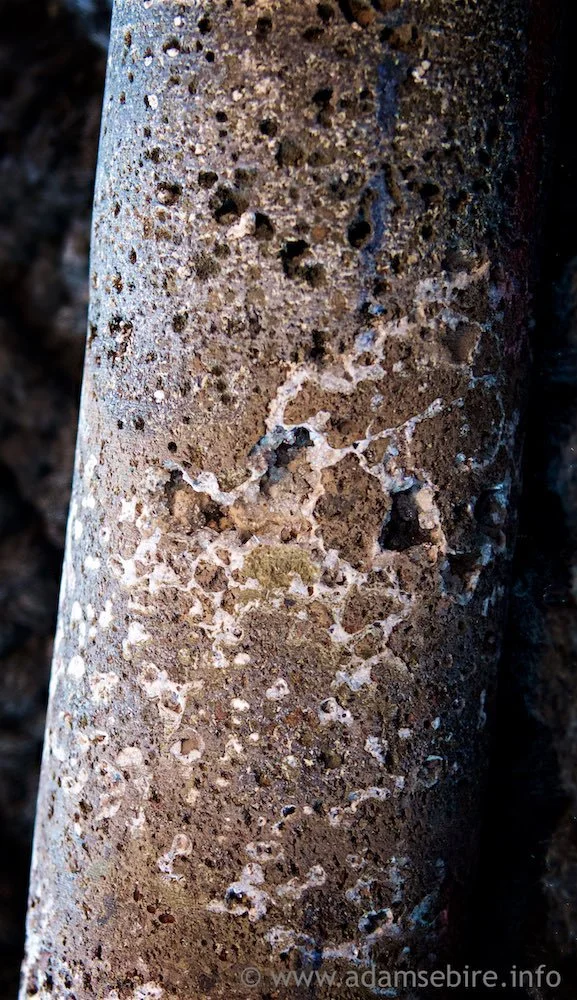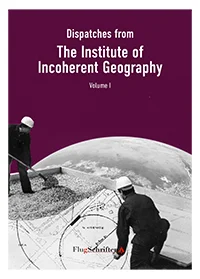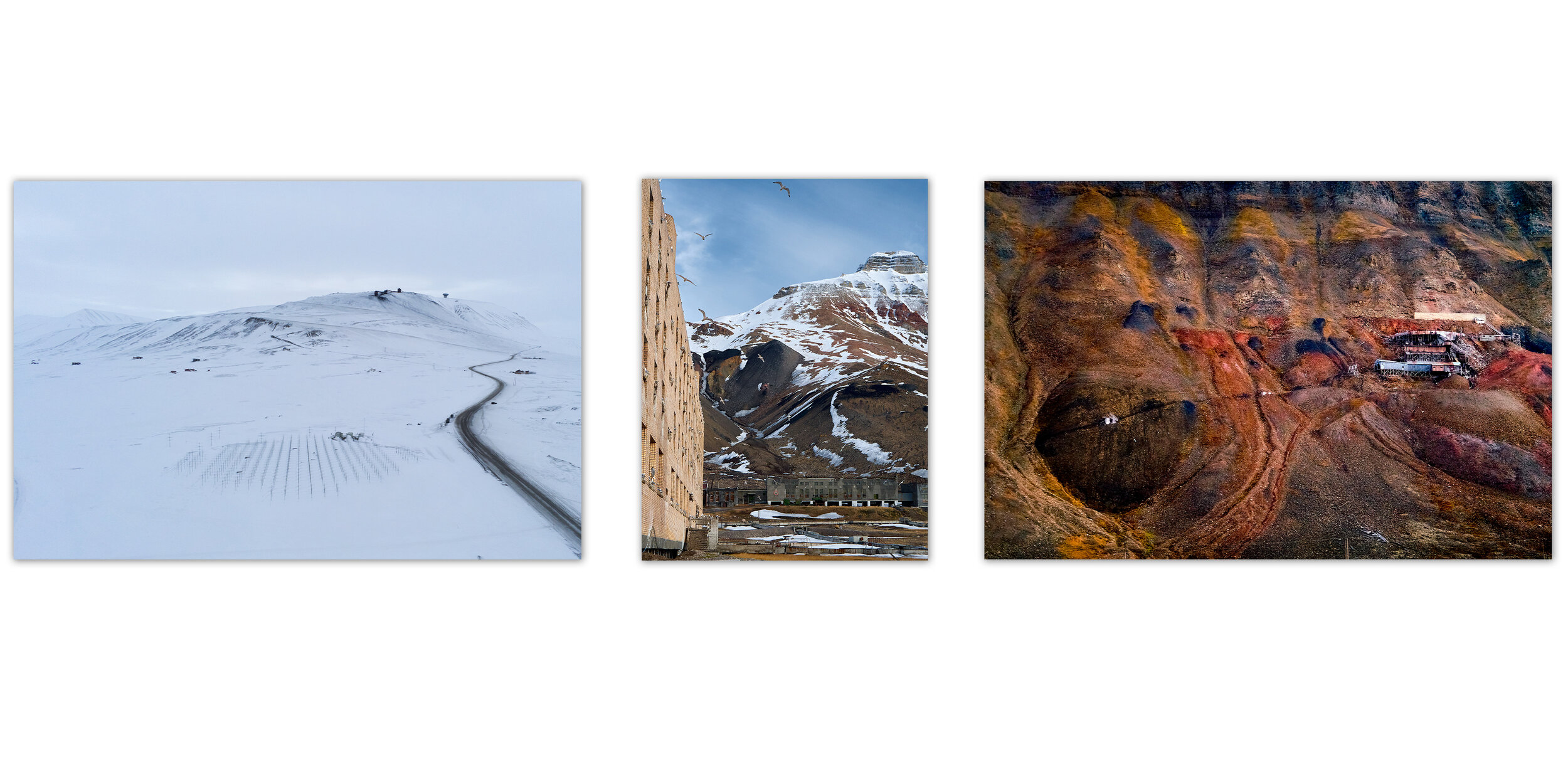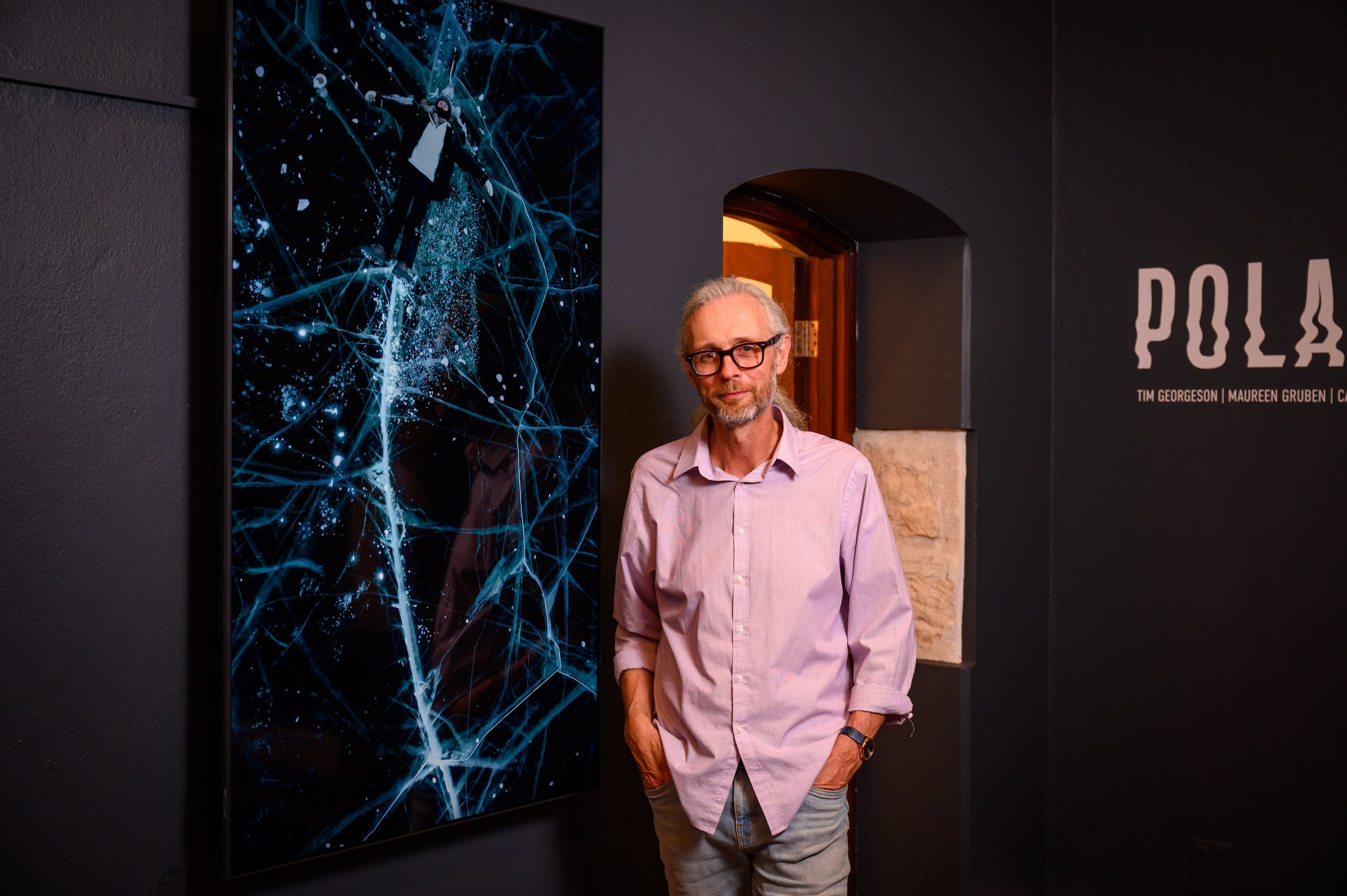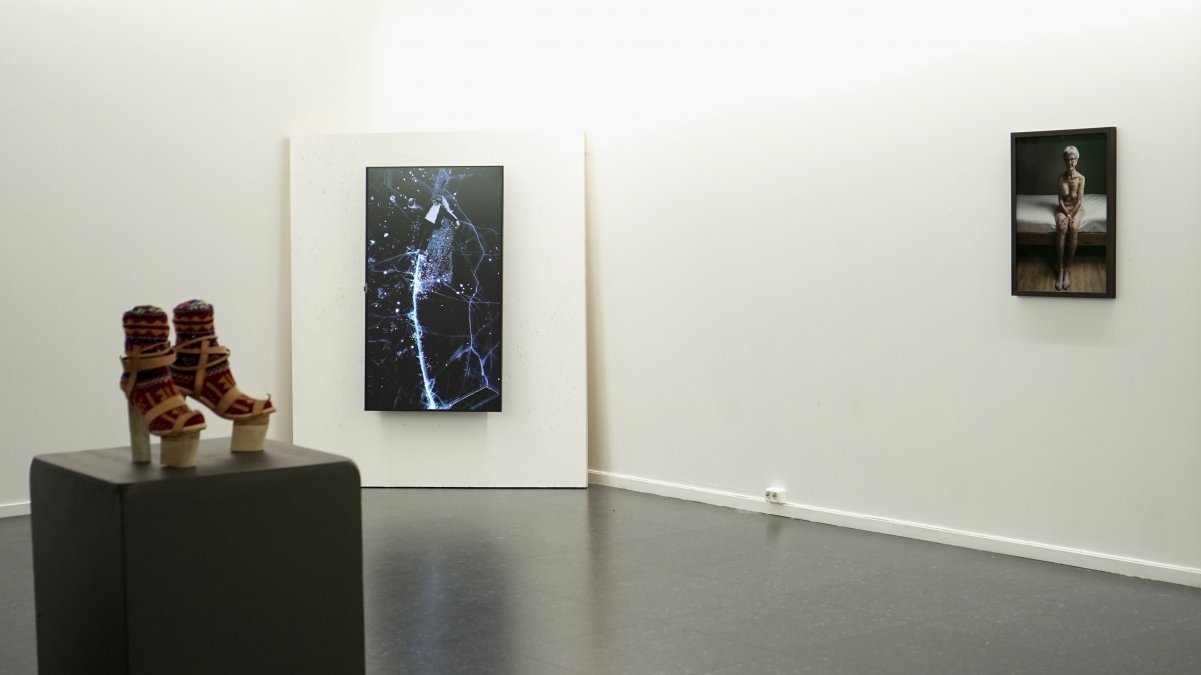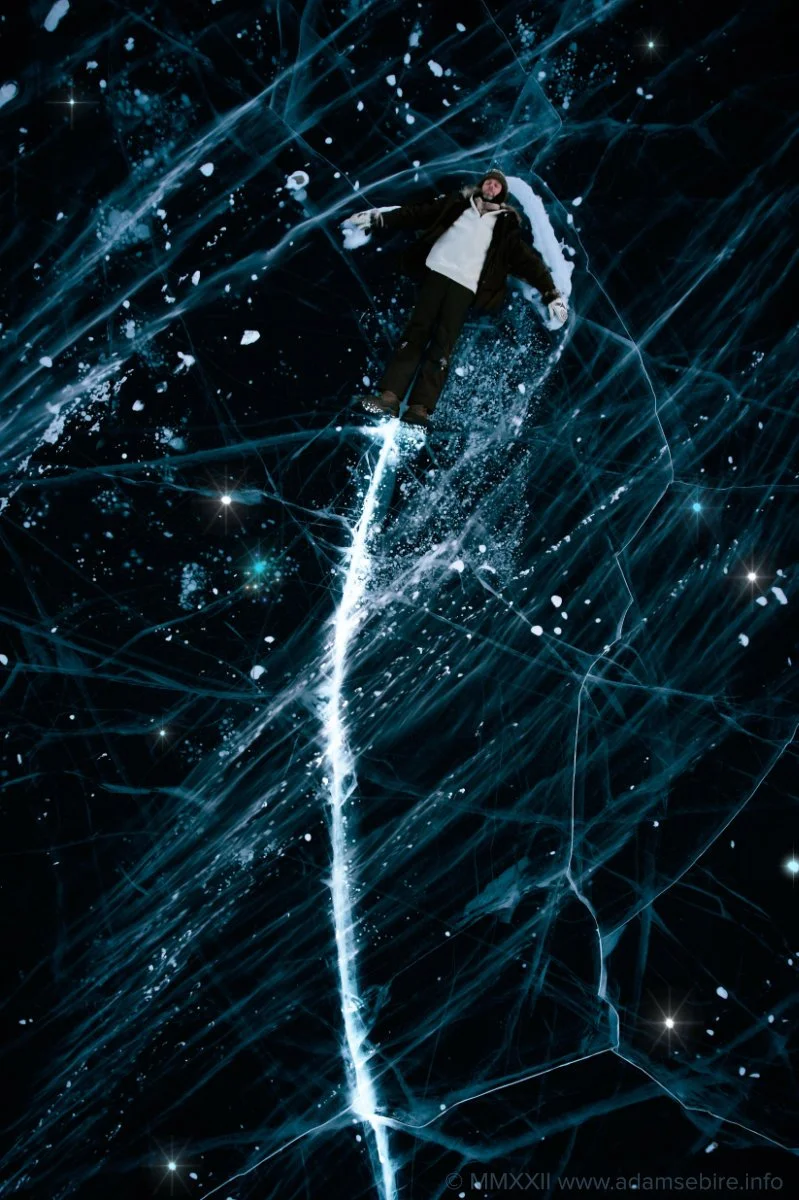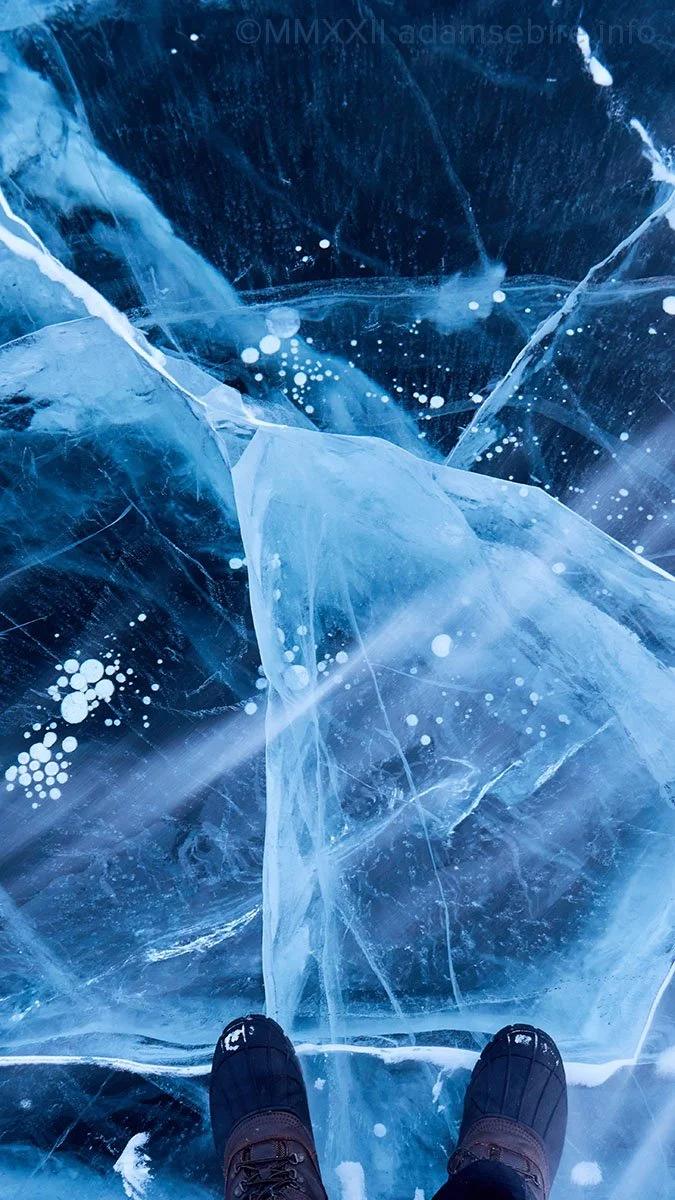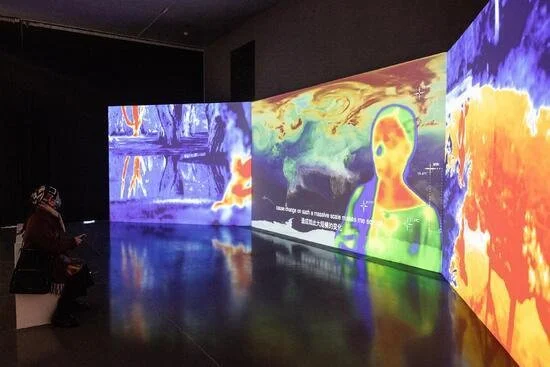NEWS: AnthropoScene XII (see below) will exhibit 20-21 March 2025 at UNESCO Headquarters in Paris as part of the 1st World Day for Glaciers.
Video art vignettes from The Anthropocene
Like water, wind or earthquake, humanity has unwittingly become a geological force in its own right: this is the premise underlying the anthrōpos in "Anthropocene". But it’s very specific societies & structures that now disrupt the Earth System on which all life depends; while the humans & non-humans who bear least responsibility stand to lose the most from its consequences.
Anthropogenic climate change, once set in motion, occupies spatiotemporal dimensions imperceptible to our senses. Its impacts & interconnections have little regard for borders; cause & effect are dislocated between here & elsewhere; now & elsewhen; between self & other.
Whilst some advocate doubling-down — taking control through geoengineering — others note that we already have the knowledge we need for a more symbiotic relationship within 'nature': to move from a mindset of consumption and exploitation towards an ethos of planetary stewardship instead.
Might art offer us a point of entry to these ruptures, transitions and interconnections? Firstly to perceive them at all; then to view them from another perspective?
Quick navigation ▼ Teaser video for anthropoScenes I-XII (1’50”) ▶︎
AnthropoScene I (2018)
Now Showing in Glasgow Science Centre, The Greenhouse.
🗝 geological time, glacier icebergs, global warming, peak oil
AnthropoScene II (2018)
Winner, Critics’ Award, Northern Norway Art Prize. Part of the Points of Return exhibition, online & Concord (USA) 2023 🗝sea level rise, weather, sublime
AnthropoScene III (2018)
1st prize,The Art of Energy exhibition (2021).
🗝 Climate engineering, carbon capture, homeostasis, geoengineering
AnthropoScene XII (2024)
New video triptych (3 screens) showing at UNESCO Paris March 2025 for IYGP.
🗝 Icebergs, care, stewardship, repair, Symbiocene, renewal, ecophilia, visual art, glacier ice
AnthropoScene IV (2019)
Taigh Chearsabhagh (UK) ‘21-22'; finalist, Waterhouse Science Art Prize (‘22) et al. 🗝 Climate attribution science, fossil fuel footprint, carbon emissions, sea ice
AnthropoScene VIII (2023)
Winner, Earth Photo/Video Prize 2023; Northern Norway Art Prize finalist touring 2023. 🗝 Nature, immanence & transcendence, trans-humanism, hubris
LATEST WORK:
anthropoScene XII : a work-in-progress
a.k.a. Iceberg care (2024)
DESCRIPTION
A lone figure tends to three sublime glacial icebergs frozen into sea ice.
Known to indigenous Inuit as kassoq these are exquisitely coloured formations of translucent glacier ice, created under enormous pressure at the base of the Greenland ice sheet (Sermersuaq) before being transported by the flow of the Qarajaq glacier. They’re likely to be millennia-old.
As the screens loop, bergy bits are repetitively mopped, swept and polished of fallen snow. Their carer’s Sisyphean endeavours are punctuated by moments of connection between him and the ice. (Of course, we can only really ‘know’ the 10% that floats above water…)
Ilulissap eqqaa (a Kalaalisut term for the area surrounding an iluliaq or iceberg) is a dangerous place to be since the sea ice here is fragile and the bergs, eroded from below by warm water, can overturn without warning. Belying their monolithic appearance, icebergs are in constant transformation – by wind, current, solar radiation, precipitation, and now, by manmade climate change.
ARTIST STATEMENT
How might we find ways of being & existing within the “Anthropocene”? Ratification of this contentious proposal — marking a geological epoch characterised by human disruption of the Earth System — was due in mid 2024. However it was unexpectedly 'put on ice' by scientists unable to agree on what event best marked its beginning. But could this administrative anomaly be a small part of some larger rupture in Western narratives that describe our relationship to the non-human world? As we move from mindsets of consumption & exploitation towards an ethos of cooperation & planetary stewardship?
Prising open conceptions of 'nature' sufficiently to accommodate more symbiotic and collaborative approaches with(in) it — as suggested by environmental philosopher Glenn Albrecht's Symbiocene proposal — is likely to be a long and, like my iceberg cleaning, clumsy and imperfect “work-in-progress”.
CURATORIAL DETAILS
Video specifications*: 3 or 4 screens (ideally 4K25p HLG HDR) via USB playback (asynchronous video triptych). 3 (or 4) channels, looping, dur. 10’56, 14’50”, 14’23”, (4’55”)
Audio: 2.1 stereo on ch.2 (recording of singing ice by Jonna Jinton) + fx on ch.1 & 3.
Exhibitions: Ilulissat Art Museum, Greenland 15 Sep-5 Nov 2024; CAC Sydney, Australia 26 Oct–6 Dec 2024; Taigh Chearsabhagh (North Uist) 9 Nov-25 Jan; Patriothall Gallery, Edinburgh Feb-Mar 2025; An Talla Solais (Ullapool, Scotland) 21 Mar-04 May 2025 (see catalogue PDF). Ronald Anzenberger’s The Value of Ice exhibition (main screen only), Hamburg, Nov’24 & Jan’25. UN International Year of Glaciers’ Preservation (IYGP) 2025 launch (UNESCO HQ, Paris 20-21 March & Plenary at WMO Geneva, 21 Jan 2025). Double Vision (Woollahra, Sydney, April 2025). Creative Climate Awards (350 W 42nd St, New York, USA) 8 Apr-6 May 2025.
Competitions: finalist in the Fisher’s Ghost Art Award, Sydney Australia, Nov 2024; winner of Climate ChanCe art prize (Venice, IT, Dec 2024).
Please email to enquire about exhibiting the work.
* Exhibition Installation options:
1. the same cleaning equipment as featured in the work — plus a “spark” (Scandinavian kicksledge) — may be positioned around/under the screens.
2. the circular 4th video of cleaning another iceberg, is optional, but can be supplied for floor projection (4K or HD), 4’55”, mute.
3. an iPad or similar might display the glaciologist interview (see preview, right).
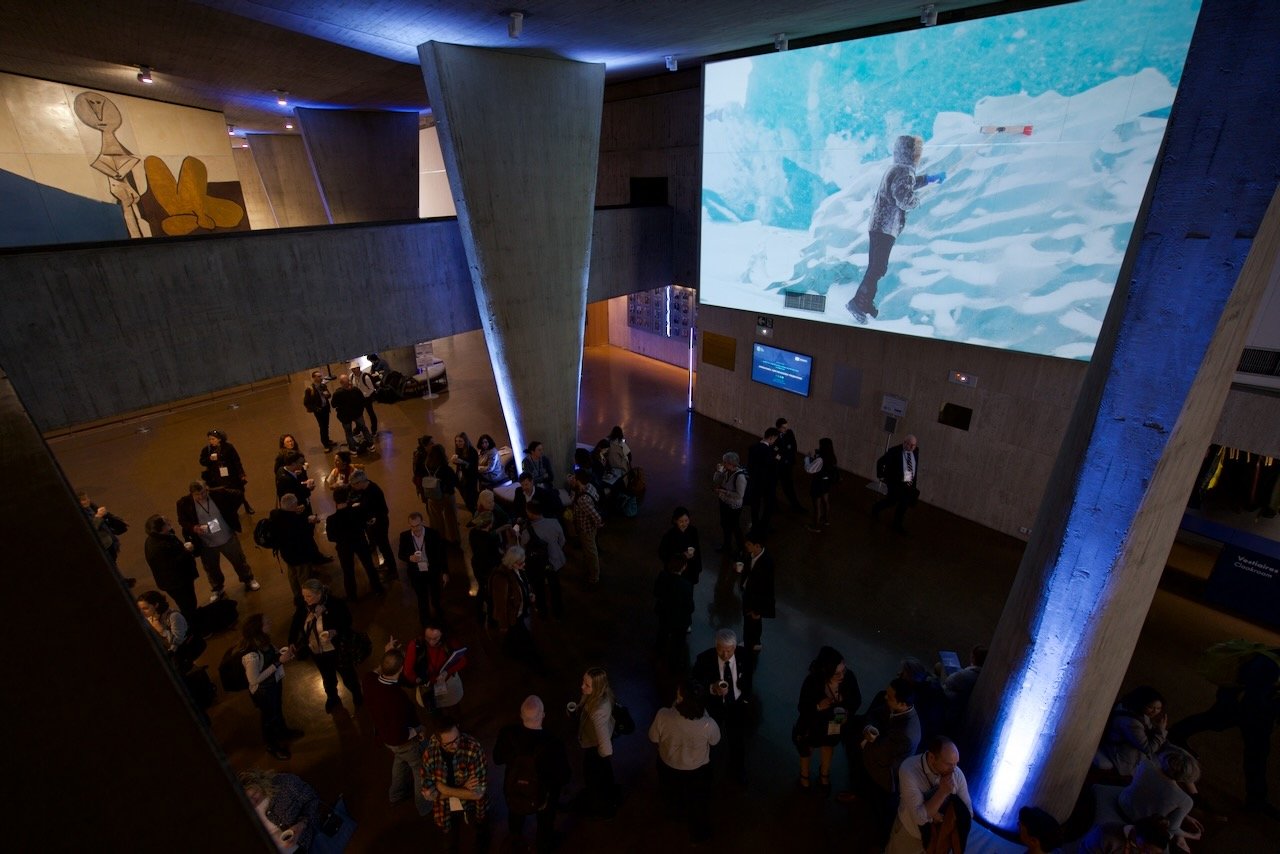


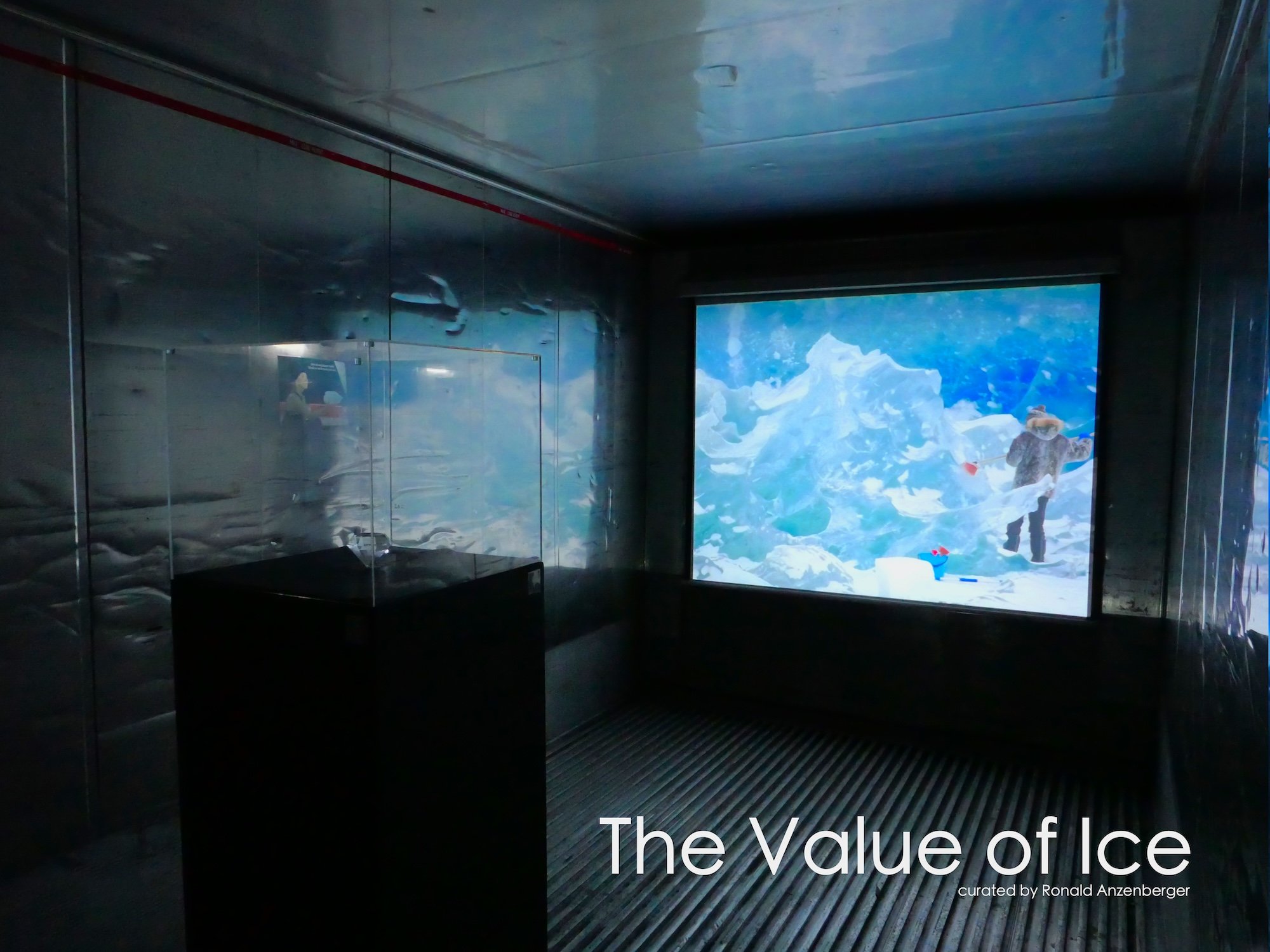


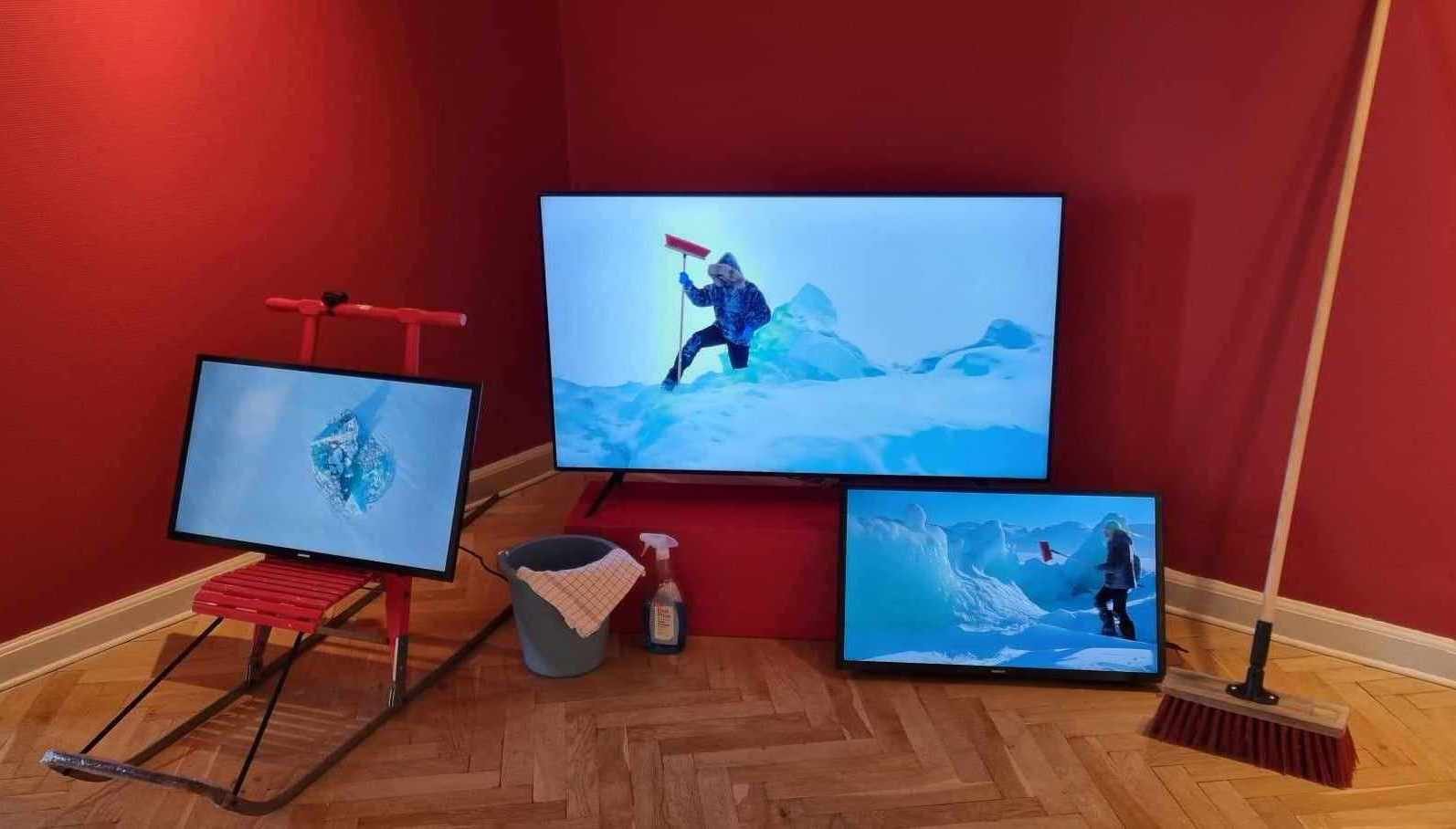
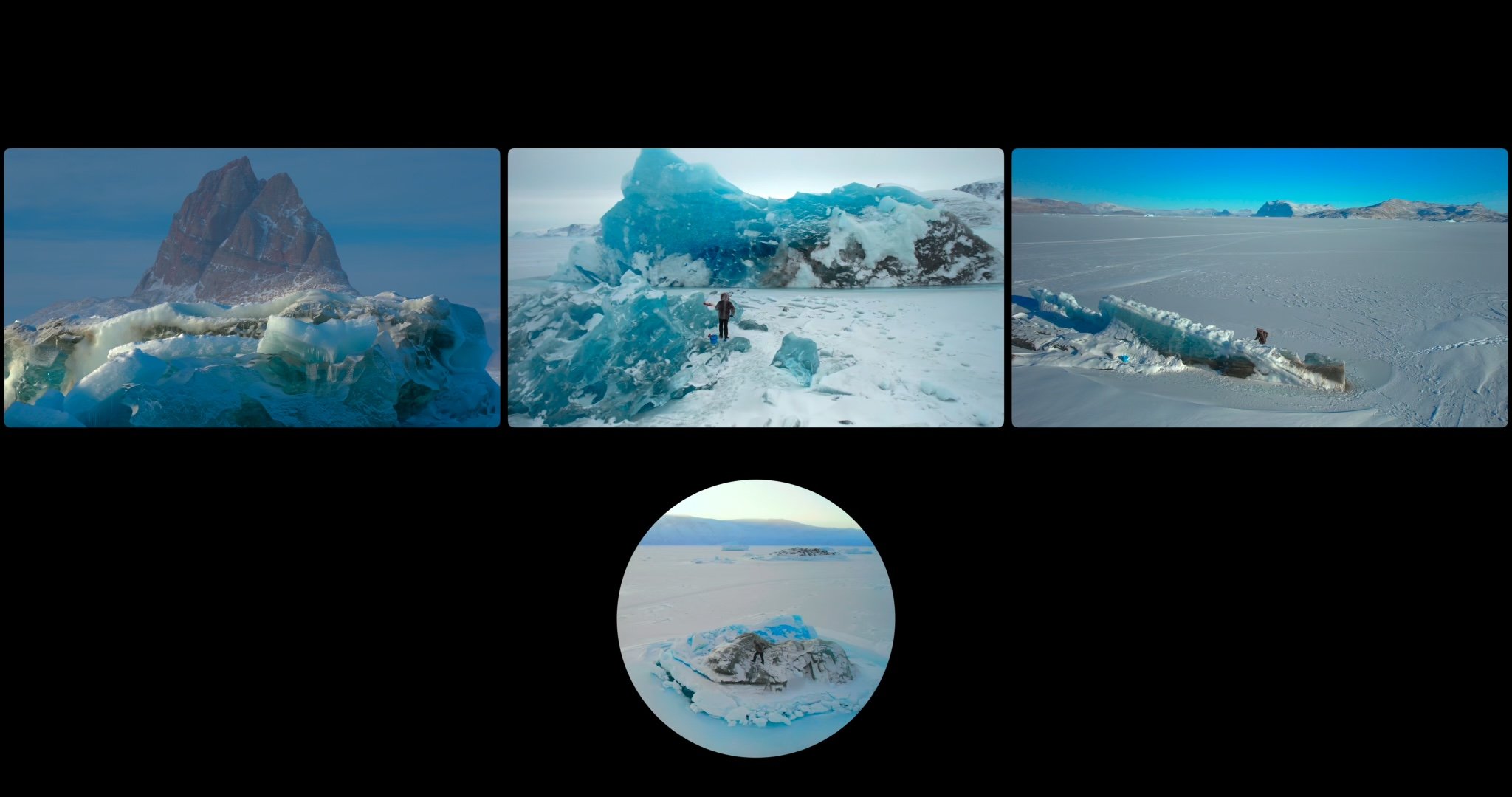
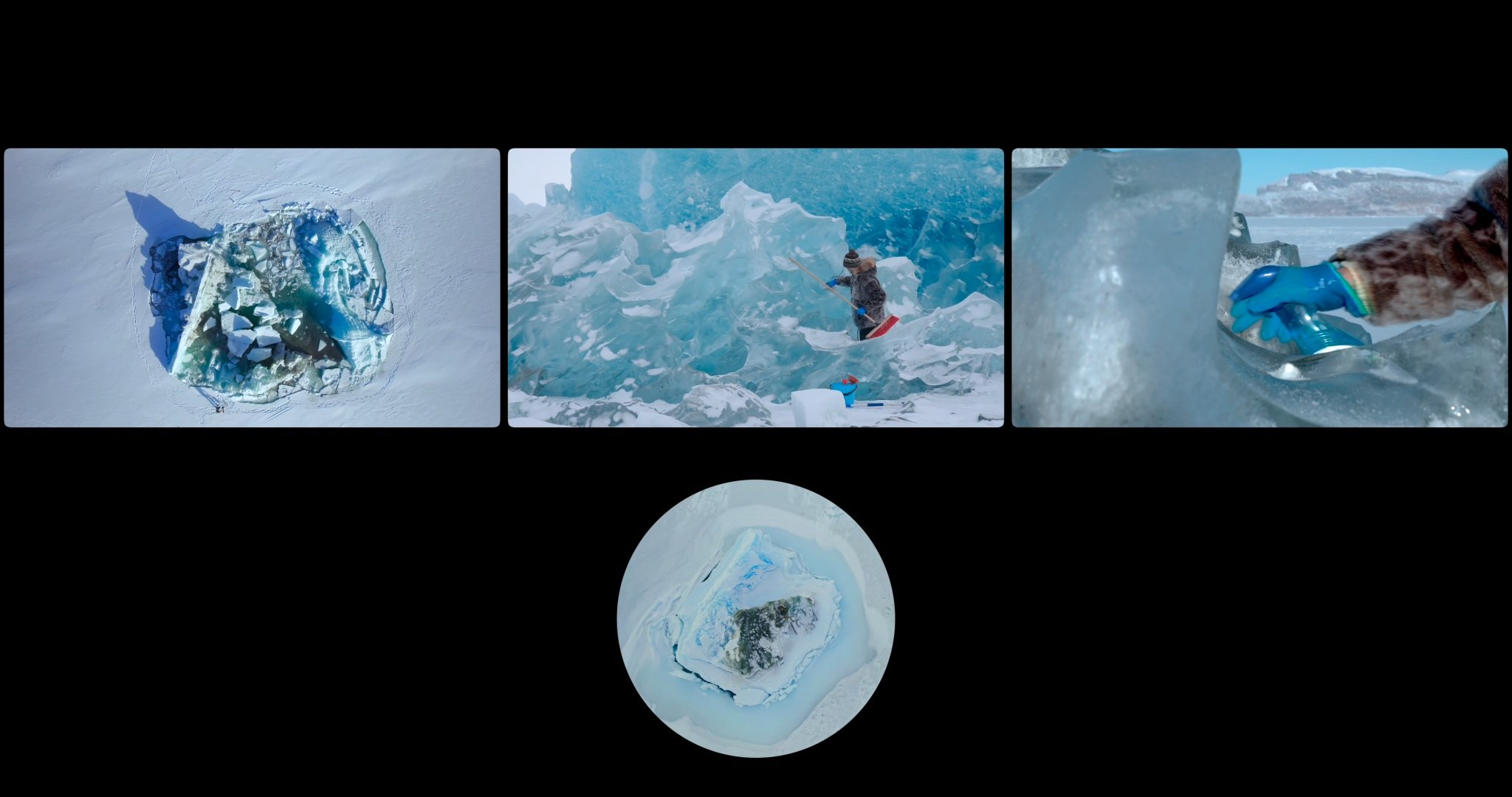

Above: video stills + installation views, UNESCO Paris, Ilulissat Art Museum (GL) 2024 and Ronald Anzenberger's Contemporary Art Made of Ice, Hamburg (DE), 2025.
Above: split-screen preview. Note that each channel loops independently.
EARLIER WORKS IN THE SERIES:
anthropoScene I : Breakdown (4 min version, 09.2018)
The traffic just seems to be getting worse every day at Iceland's iceberg lagoon, Jökulsárlón...
Dur: 4'08" / Cinema 4K video, stereo audio. Made in residency at SÍM Iceland.
• Shortened 1’00” version licensed by the United Nations during 2019 for the COP24 Framework Convention on Climate Change.
• Screening as part of the Life After Oil Film Festival, Sardinia, Sept 2020.
• Screening in Glasgow Science Centre’s ‘Greenhouse’ for Curious About: Our Planet from 16 Aug 2021 onwards, to coincide with the UN’s COP26 conference.
• Exhibited at National Natural History Museum, Beijing for China Climate Action Week (CCAW) (WWF / Chinese Ministry of Ecology & Environment) Oct 2023.
• Finalist in the CMCC Climate Change Communication Award, November 2023.
Australian artist-filmmaker Adam Sébire uses dark humour to approach the climate crisis at one of Iceland’s fast-disappearing glaciers, Breiðamerkurjökull.
Its astonishing iceberg procession is reimagined here as a traffic jam of cinematic proportions.
Breakdown shows in Adam Sébire’s AnthropoScenes solo show at Galleri Svalbard, March-August 2020, celebrating the 25th anniversary of the world’s northernmost art museum and inaugurating Longyearbyen’s Solfestuka or Sun Festival.
anthropoScene II : Tideline
On an island's black-sand beach the high water mark rises relentlessly.
Duration: 2'30" / 4K single-channel, stereo audio. (Watermarked HD preview above). For sales enquiries contact 80:20 Artist Agency, Sydney.
🏆 Winner, Critics’ Prize: Den 75. Nordnorske kunstutstilling (75th Northern Norway Art Prize). Touring throughout 2021. ☞ Details.
“In this awarded work of the North Norwegian Art Exhibition's Critics Award, 2021, there is a confusion about time. The confusion applies to both the material represented and the technique used. Although water is a volatile and liquid material, the water in this work appears as powerful rock chains, and heavy, dense formations, with a large physical presence. These waves are filmed from above, against a black sandy beach, and in the short video work the movements of the waves are played backwards, in slow motion. Thus, the water's foaming mountain ranges seem to collapse and fall backwards in time, as the video progresses.
This is how the extent of time appears to be unsynchronised, dislocated, and the work provides an opportunity to reflect on a central conflict in the era of the climate crisis: Between humans' short lives and intensive consumption of resources, and nature's slow, inexorable and eternal process. The work is accompanied by a soundtrack from an instrument made of recycled materials, and although the tone is mournful, reuse and this circular economy point the way out of the climate crisis' most powerful and frightening consequences. Back in the video, the waves have washed out the beach and an area of calm water can be seen, but the line between sea and land is creeping ever higher.
The winner of the North Norwegian Art Exhibition's Critics Award, 2021, is Adam Sébire with the work Tideline (2018).”
Filmed with a drone off remote eastern Iceland, reverse motion creates an eerie sense of prolepsis; a prevision of inexorably rising sea levels.
Made during a residency with SÍM Gallery in Reykjavík, Iceland.
Video © 2018 Adam Sébire (AU) www.adamsebire.info
Music © 2018 Martin Franke (DE/NL) www.hethoutenhuis.org
Exhibitions: premièred at Adam’s anthropoScenes solo show at Galleri Svalbard (curator: Jan Martin Berg) for the Svalbard Sun Festival & 25th anniversary of the world’s northernmost art museum — 8 Mar - 24 Aug 2020. Also exhibited at The Green Exchange, Chicago USA 1 Oct - 15 Nov 2021; at the Australian National University S.O.A.D. Gallery 8 Feb-18 Mar 2022 and Fremantle Arts Centre 10 Feb - 28 Apr 2024 (right).
The work is represented by William Seeto at 80:20 Artist Agency. On display at Abstract Project gallery, Paris, Feb-Mar 2025.
anthropoScene III : Hellisheiði
Video triptych, 2018 (revised Sept 2021). 3 HD screens (or 2 plus core sample in lit vitrine), 2.1 stereo audio.
Duration: 3mins. Split screen preview above. (Prologue text can be replaced in other languages.)
Première: Deutsches Museum, Munich, October 2018 in the exhibition (Um)weltschmerz: an Exercise in Humility & Melancholia.
🏆 Winner, 1st prize (awarded £1000), The Art of Energy exhibition, Centre for Energy Ethics, University of St Andrews, Scotland, 2021.
Exhibiting at the Chengdu Biennale, China, 16 July-22 November 2023 at Chengdu Museum of Art.
PROLOGUE TEXT:
The Climeworks/CarbFix2 project at Hellisheiði, Iceland is the world’s first industrial-scale "carbon scrubbing" experiment to capture carbon dioxide (CO₂) directly from Earth's atmosphere.
This CO₂ is mixed with water and pumped through domed injection wells down into active volcanic regions, where it becomes petrified as rock.
Most climate change policy tacitly assumes the success of such geoengineering experiments — despite many unanswered questions about their viability and long-term consequences.
BACKGROUND:
At COP21 in Paris, December 2015, the world’s leaders stated their “aspiration" to limit global warming to an upper limit of 1.5ºC this century. But if nations fail to decarbonise rapidly enough, there is no way to address overshoot of that target without some form of geoengineering (sometimes termed climate engineering) using technology — untested at scale and some of it with potential side-effects.
Forms of geoengineering known as Solar Radiation Management (SRM) essentially propose that we "hack" the Earth System — or at least fiddle with its thermostat. Another, arguably more benign, approach supported by the UN’s IPCC is Carbon Dioxide Removal (CDR). This employs carbon capture and storage (CCS) technologies such as seen here.
Since October 2017 Hellishei∂i’s other-worldly test site has been capturing carbon dioxide directly from the air surrounding Reykjavík’s geothermal power station: anthropogenic greenhouse gases are captured, dissolved and sequestered deep within the rock of an active volcano. (In 2021 the project was significantly expanded and codenamed “Orca”; already construction of “Mammoth” is underway.)
Despite being complex, energy intensive and (for now) expensive, CDR has proven politically attractive as a “technofix”, an excuse to delay decarbonisation. Indeed all forms of geoengineering potentially come with what ethical philosophers such as Clive Hamilton identify as “moral hazards”.
Video artist Adam Sébire is drawn to this site for its modern-day alchemy and its post-industrial Promethean overtones: an unshakeable faith in the technological mastery of Homo sapiens.
In the video triptych, one of the three screens investigates the experiments at Hellishei∂i (the injection wells of CarbFix plus Climeworks’ white cube “carbon scrubber” DAC module, a prototype for what’s expected to be many thousands spread across the planet). In another, a core sample of the sequestered CO₂ — now mineralised as calcite within the basalt host rock — appears as a quasi-mystical object in a vitrine (in an exhibition this screen can be replaced by a real core sample). The third screen is more ambiguous: set in a future geological era where complex lifeforms seem to have disappeared, and where the planet is correcting an atmospheric imbalance. Now, geological processes reverse. After only a few hundred thousand years, homeostasis — equilibrium — will have returned.
oOo
More details and a discussion about geoengineering are available in a virtual exhibition featuring the work, curated by the Rachel Carson Center, Munich, in May 2019.
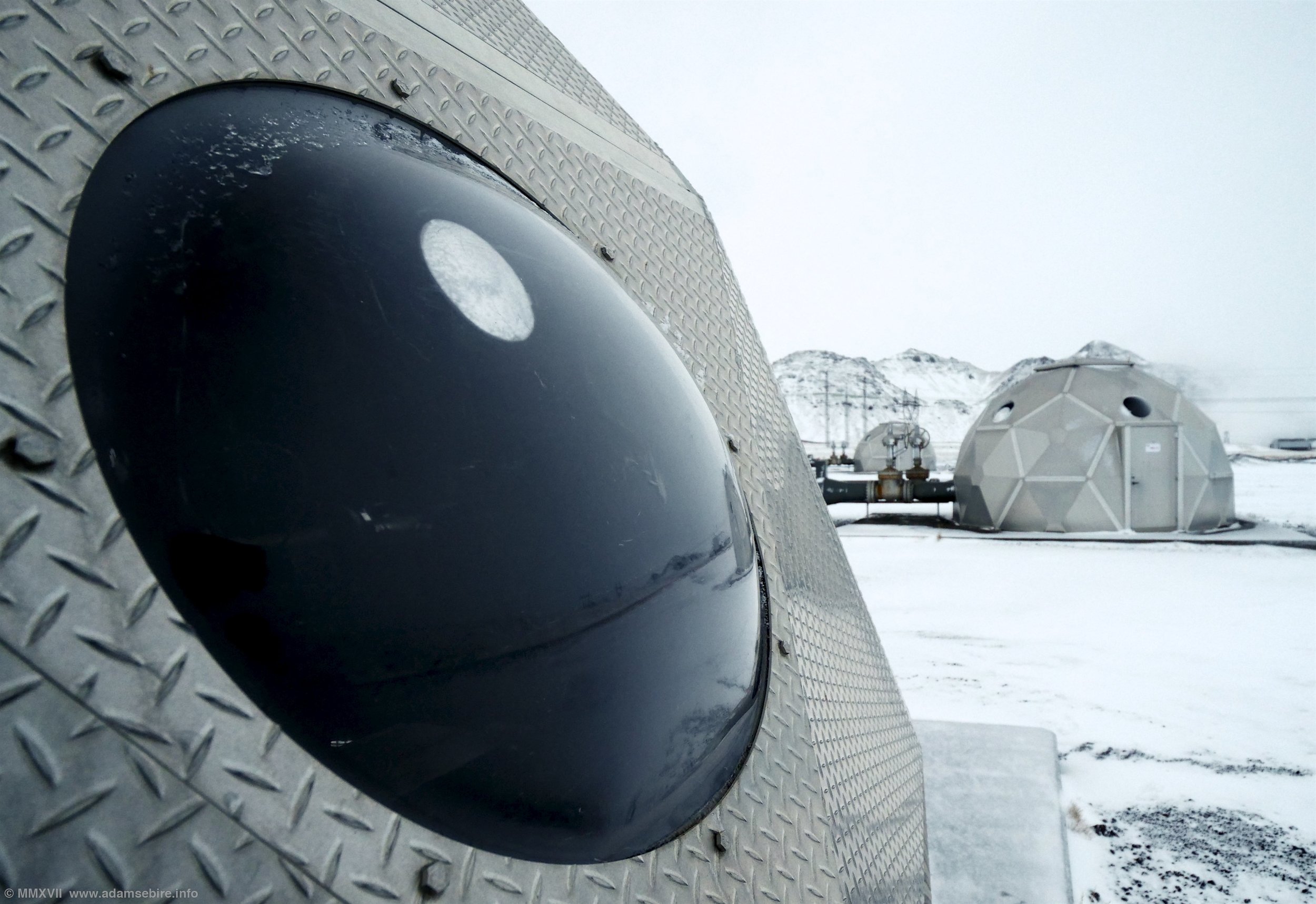
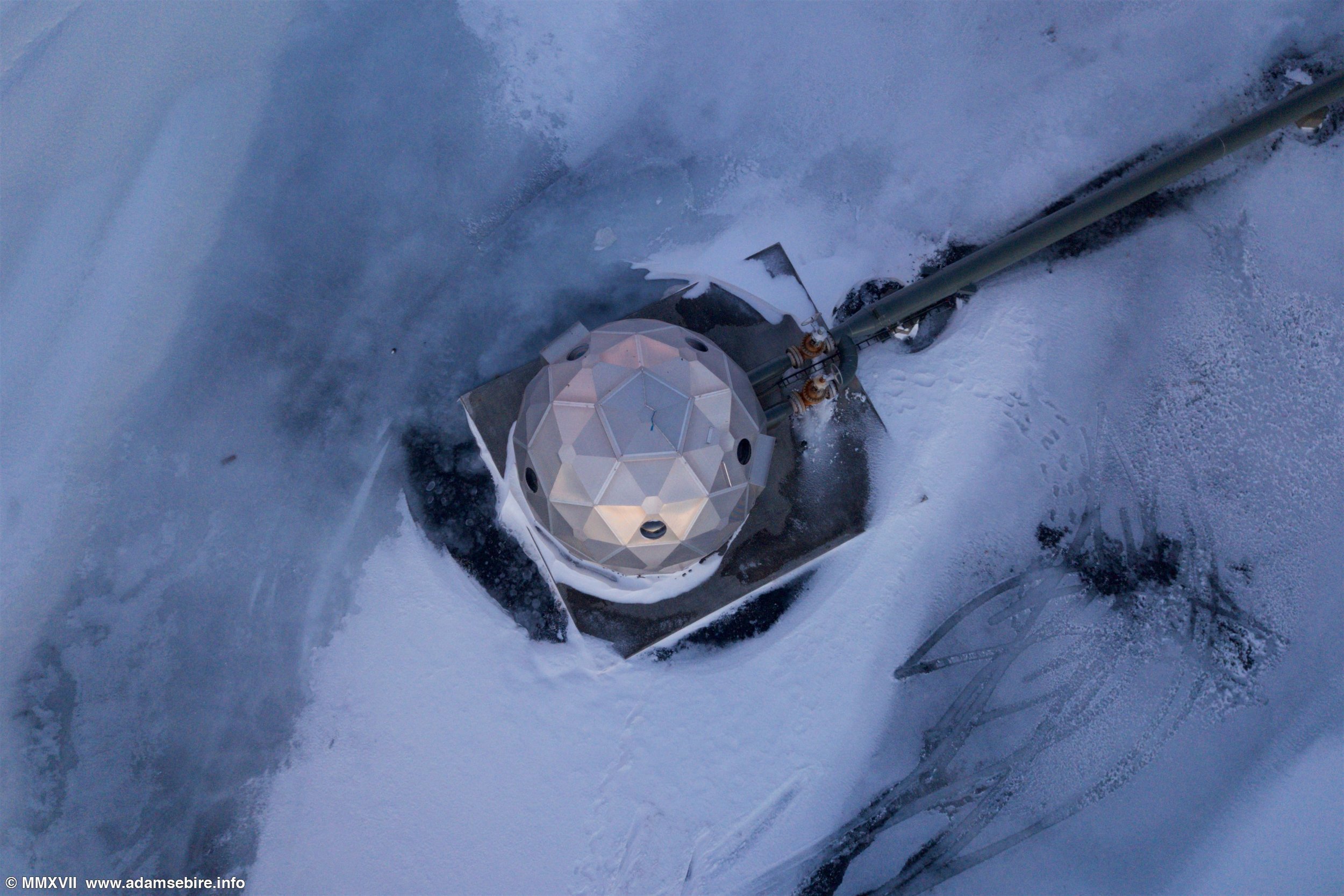
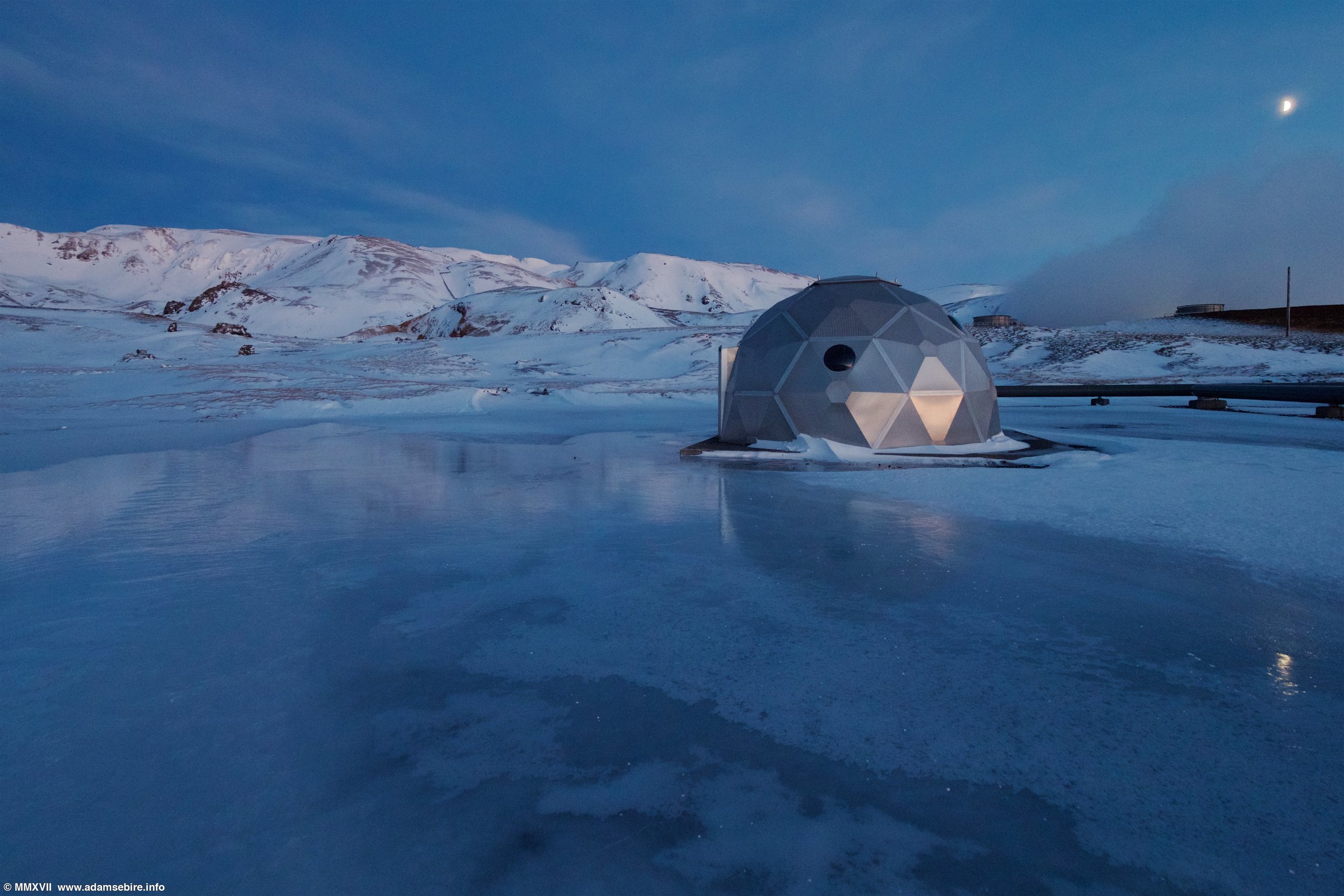
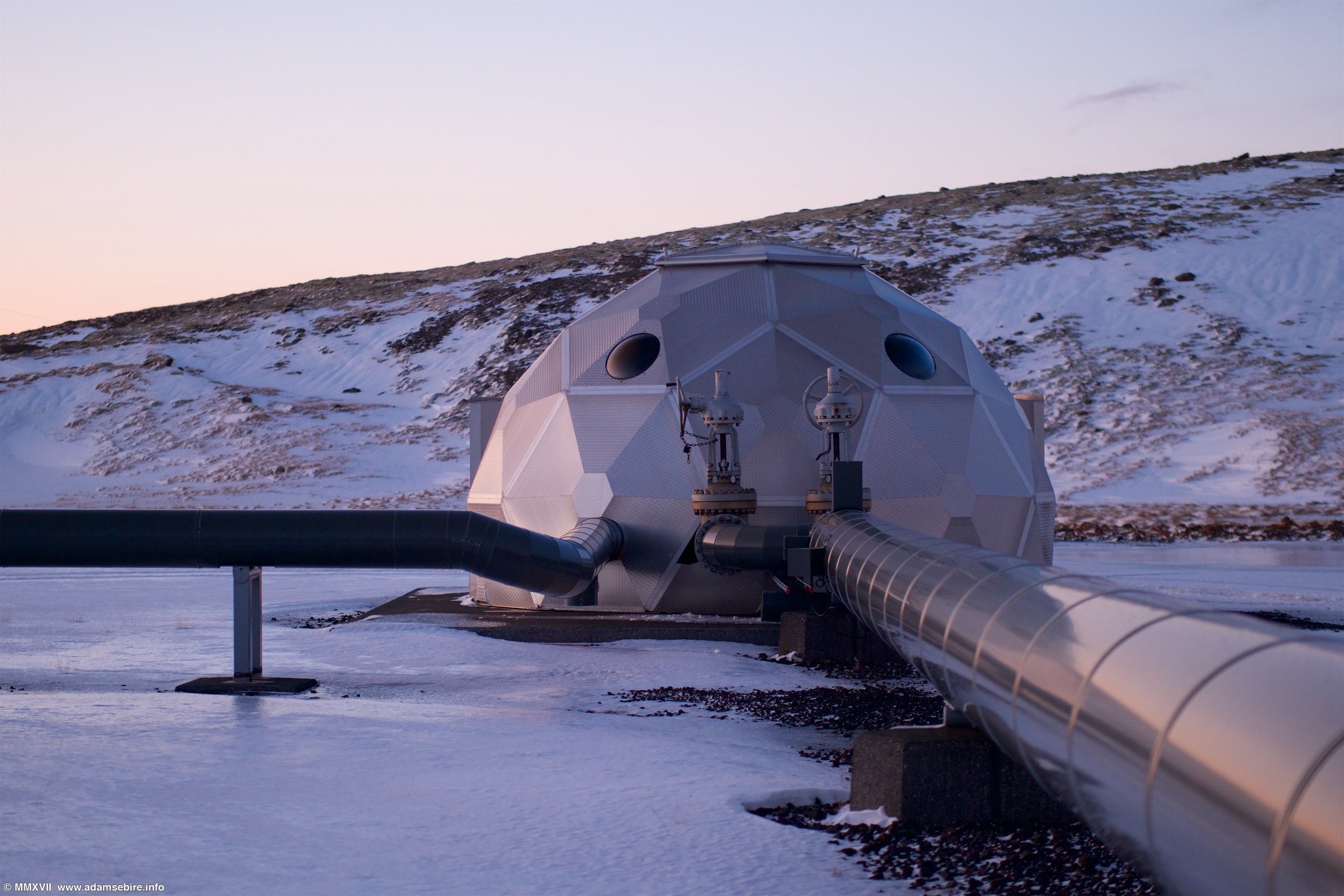
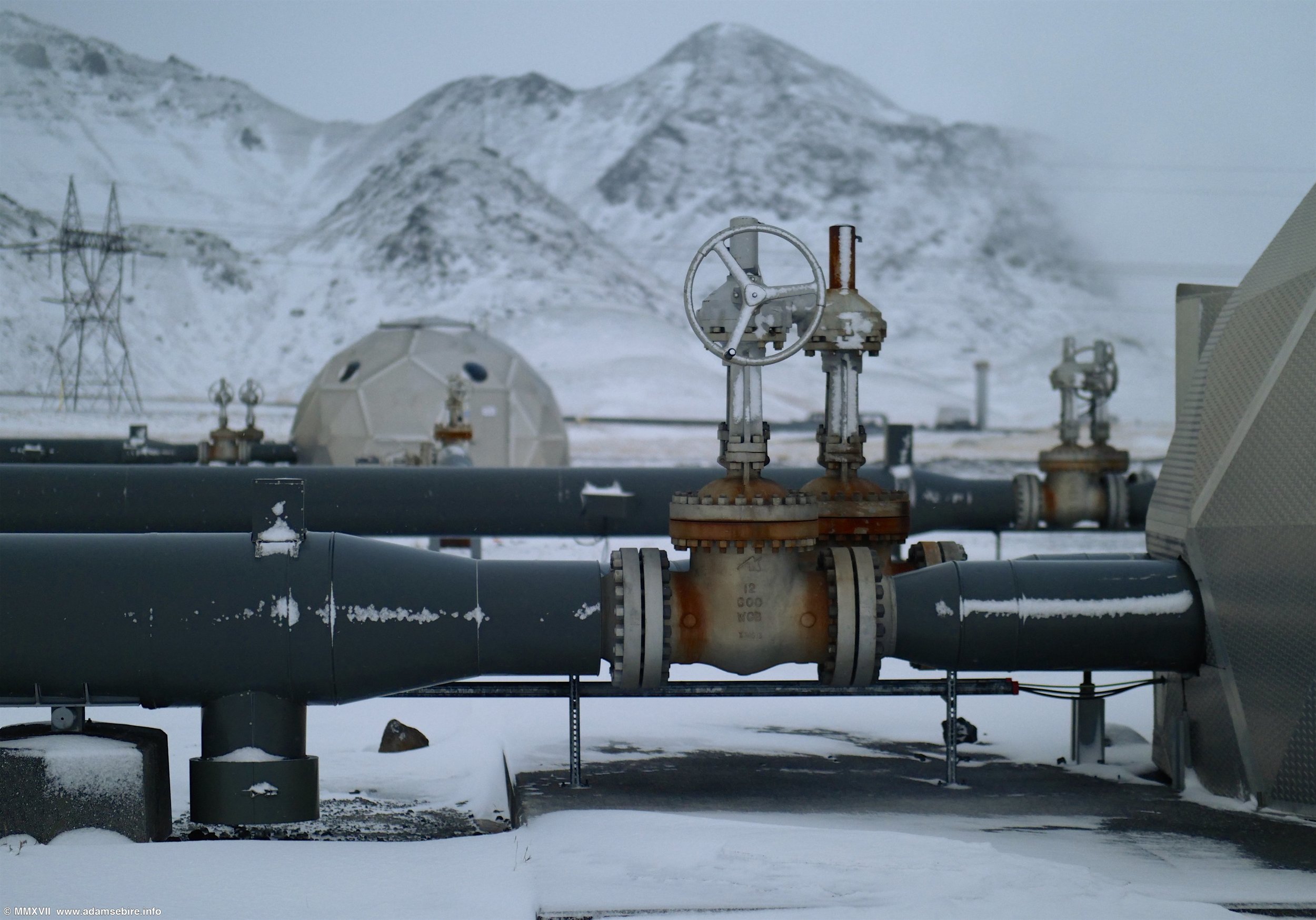
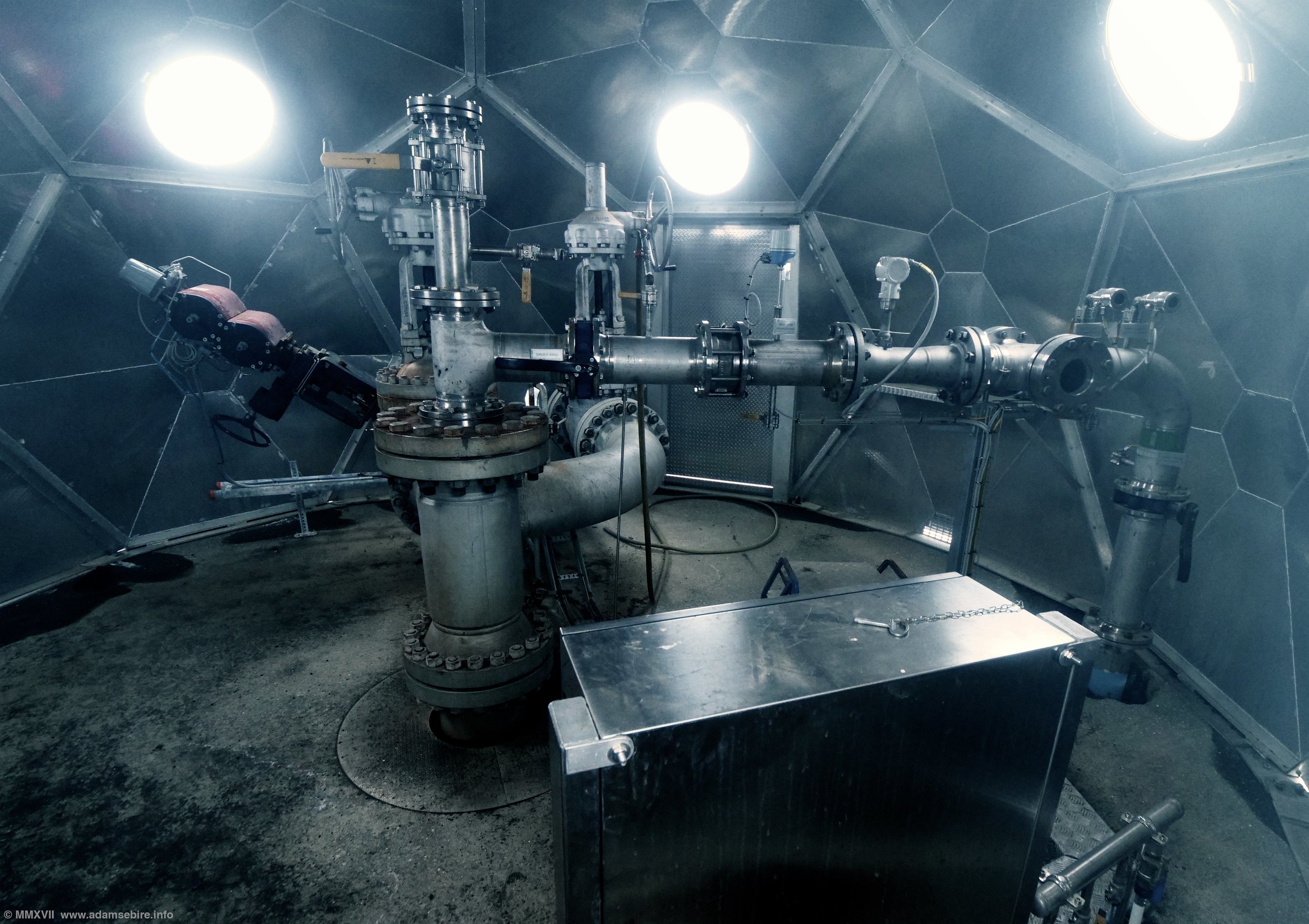

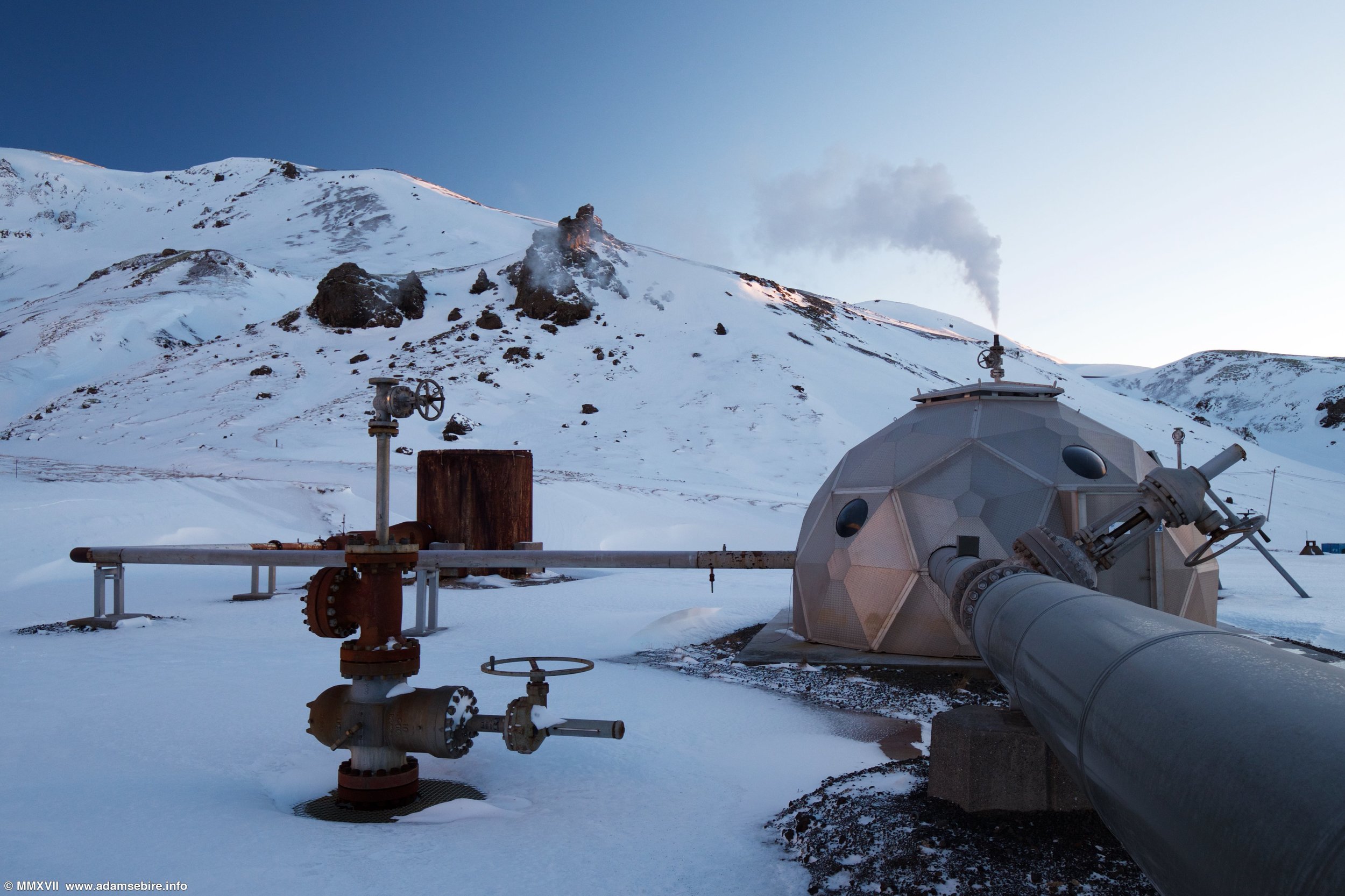
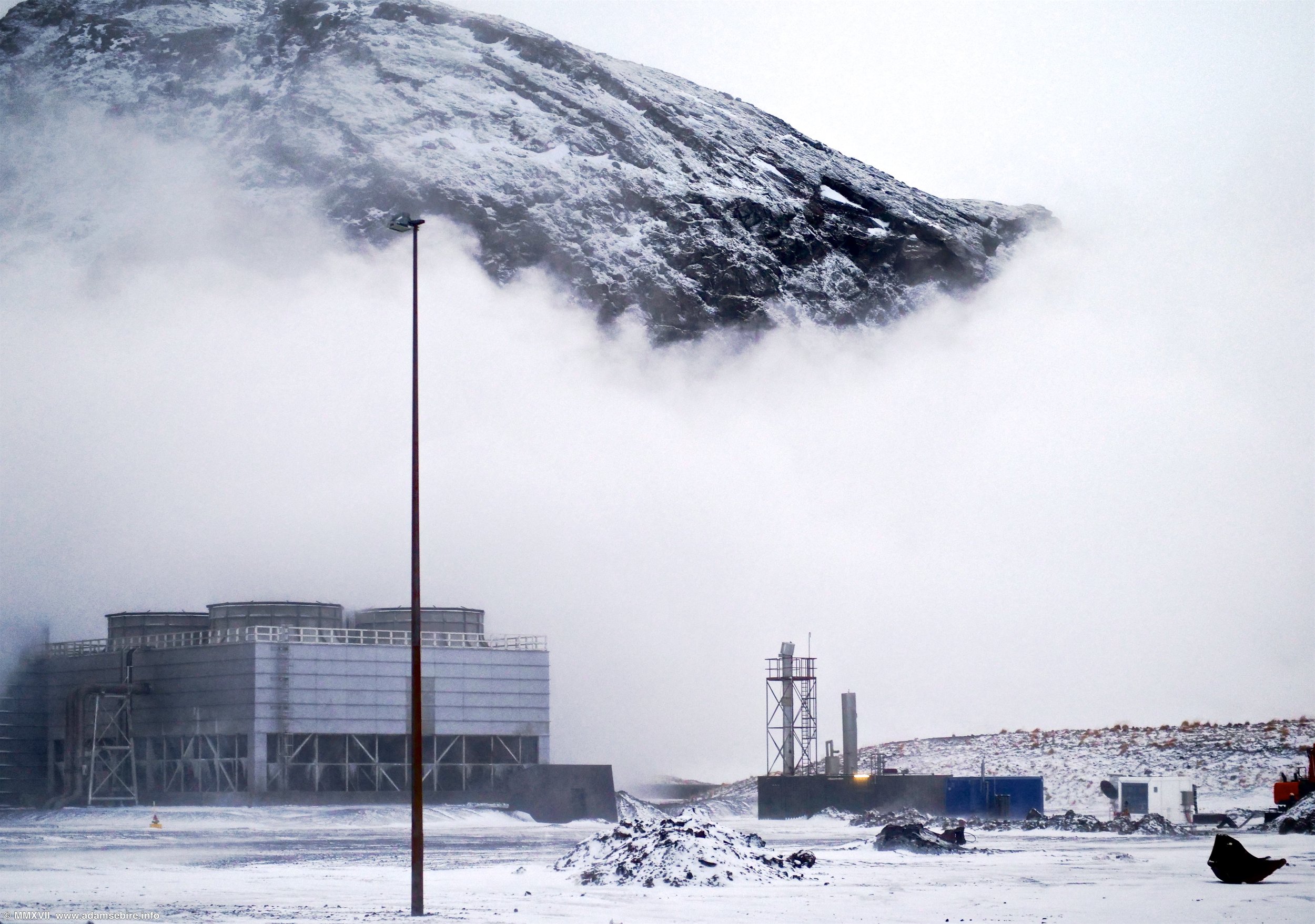

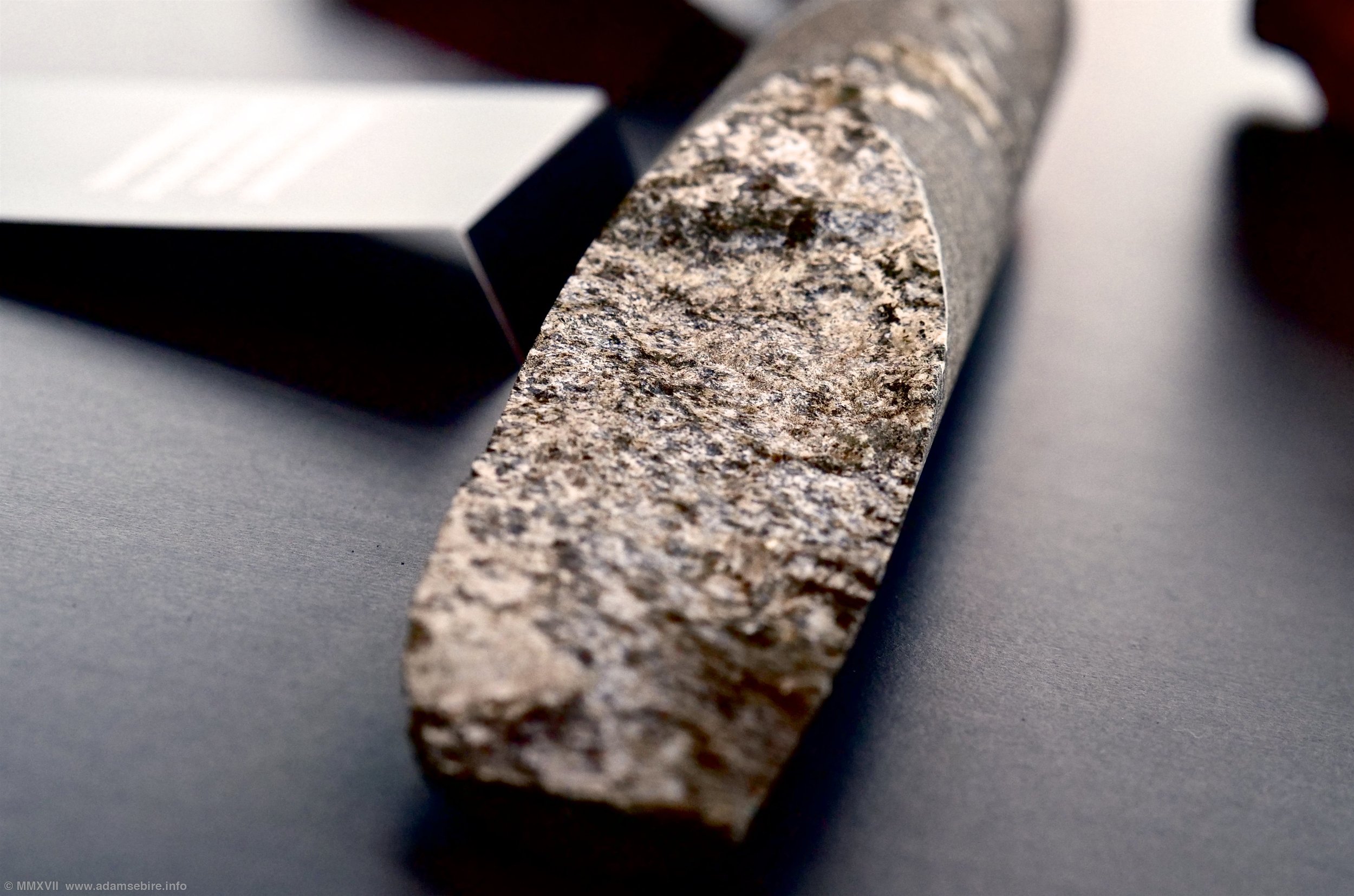
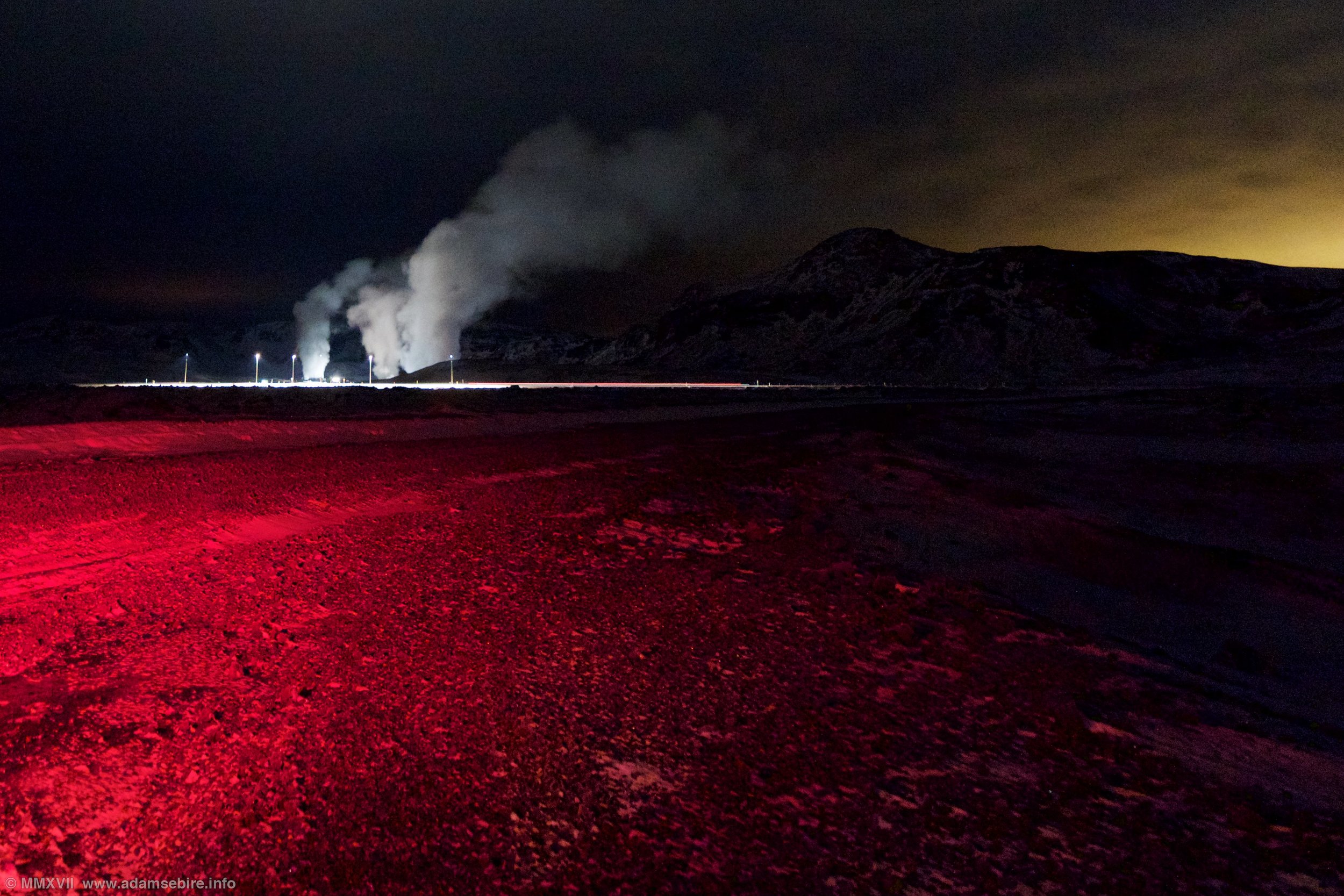
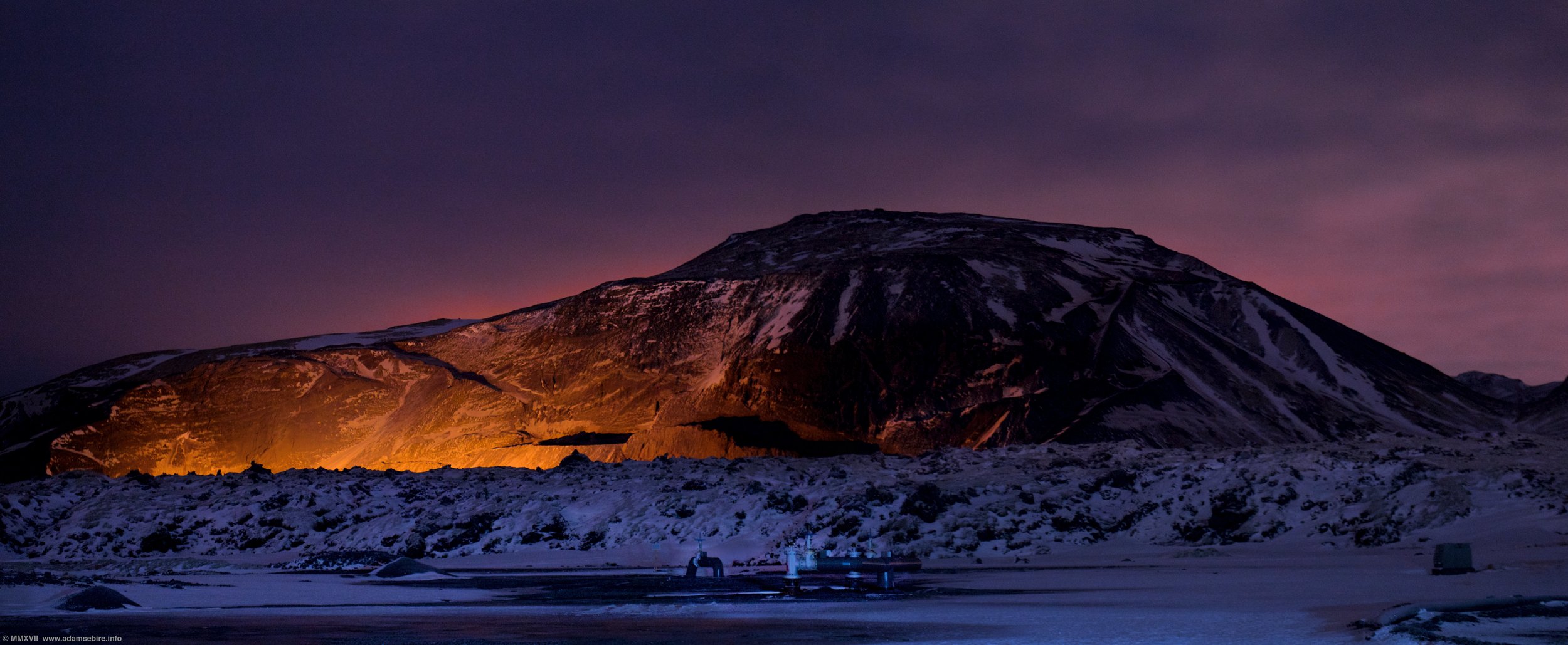
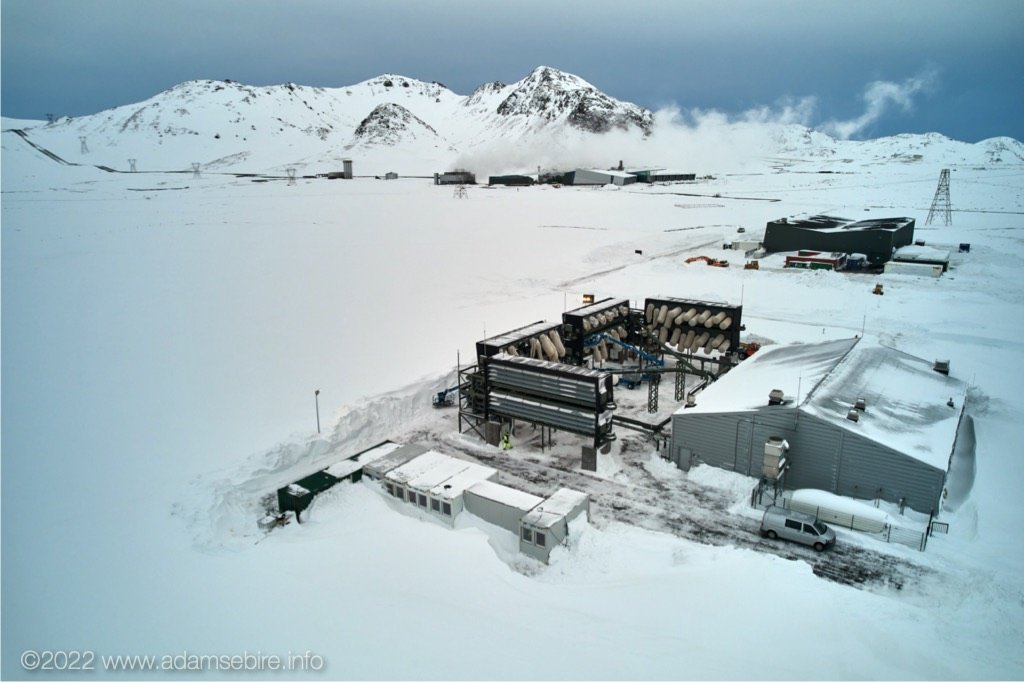
Left: Carbfix core sample showing captured CO₂ (the white material) now mineralised as calcite in the basalt rock. Above: Shots of the CarbFix2 / Climeworks project site in Iceland, 2017-19. To license any of these stills shots or video clips please go here or contact me directly. Images © 2023 Adam Sébire.
anthropoScene IV : Adrift (∆Asea-ice) (2019)
The calculus of one’s own contribution to a warming climate.
Citizens of developed countries are increasingly aware of correlations between our lifestyles and the climate crisis: witness the phenomenon of flygskam or “flying shame”. Borrowing a groundbreaking scientific formula* the filmmaker-artist calculates and saws off the exact amount of Arctic sea-ice (15.69m²) that will be destroyed by his carbon emissions flying economy return, from Sydney to Greenland, to film it (5.23 tonnes of CO₂e).
Adrift (∆Asea-ice) visualises and mythologises the consequences of a Western way of life. It touches upon disconnects — of cause from effect; of emissions here & now from melting there & then — that underly our psychological responses to global warming. Disconnects that have perhaps kept the problem comfortably abstract for us — until now…
ABOUT THE EQUATION:
Notz & Stroeve’s equation — ΔAseaice = dFnonSW,in / dECO₂ x ΔECO₂ — states that the total area of sea-ice lost equals a constant — derived from research into energy flux at the ice edge — of 3.0 ± 0.3 square metres per metric tonne of carbon dioxide emitted, multiplied by the sum of emissions. Inserting the artist’s own 5.23 tonnes of CO₂ equivalent into the equation, this works out at 15.69 ± 1.57 m² of sea-ice that will not regenerate naturally in northwest Greenland come winter. With less sea-ice to reflect sunlight back into space the ocean absorbs more heat, contributing to even faster warming in the Arctic.
Adrift (∆Asea-ice) is a video vignette from an Arctic tipping point, bearing witness to our own contribution to climate change. Its multiple screens explore cognitive dissonance; cause & effect; human & cryological time. The soundtrack comprises æolian sounds from an empty water tank at the artist's residence at Upernavik Museum northwest Greenland that 'sings' when it is windy.
REFERENCES & INFORMATION:
* Notz, D., & Stroeve, J. (2016): Observed Arctic sea-ice loss directly follows anthropogenic CO₂ emission. Science, 354, 747–750.
** An article exploring the ideas underlying the artwork was published in Flugschriften volume IV (April 2019):
Sébire, A. (2019). Adrift: Attribution & Responsibility in a Changing Climate. Flugschriften, 4 (Dispatches from The Institute of Incoherent Geography Vol.1), 27–38. (Download the complete publication from Flugschriften else a PDF of just this article here).
The artist floats off into Baffin Bay, Greenland atop the 15.79m² of sea ice condemned by the carbon emissions from his flight to get there. Photo © 2019 Adam Sebire.
Filming location: 72° 55' 53.84” N 56° 3' 34.19" W (map)
With grateful thanks to Knud Kristiansen / Upernavik Commune Museum.
Exhibitions
•The triptych (triple-screen) installation premièred at the Max Planck Institute Munich for Long Night of the Museums, 19 October 2019; then the solo show by Adam Sébire for Galleri Svalbard’s 25th anniversary, Longyearbyen, March-August 2020.
• It was Highly Commended by judges in the Open category of the prestigious Waterhouse Prize at the Museum of South Australia, 11 Dec 2020-8 Mar 2021 and Australian National Archives, Canberra, 26 March - 6 June 2021.
• Special screenings in Glasgow Science Centre’s ‘Greenhouse’ for Curious About: Our Planet, to coincide with COP26 in the UK (a live discussion with Adam Sébire & Prof. Dr. Dirk Notz on 30 Sept 2021 is available on YouTube here).
• Other screenings include the Gerald Moore Gallery (London) and touring with the Goethe Institute (2021-2023).
• Exhibiting at Taigh Chearsabhagh Gallery (Scotland) 30 Oct 21-8 Jan 2022.
• Exhibiting at the Australian National University S.O.A.D. Gallery 8 Feb-18 Mar 2022.
• Part of the Glacial Narratives exhibition at Custom House Leith for Edinburgh Science Festival, April 2023.
• Part of the Points of Return exhibition online and physical exhibition at Umbrella Arts Centre, Concord, Massachusetts, USA, May-June 2023.
• Exhibited during the European Climate Change Adaptation Conference, Dublin, June 2023.
• Part of the Climate Art Collection’s shop window projection series, Berlin, in a series called conFRONTations, autumn 2023.
• Exhibited at National Natural History Museum, Beijing, for China Climate Action Week (CCAW) (WWF / Ministry of Ecology & Environment) Oct 2023.
Versions (multi-channel versions are 8’05”, single channel is 7’55”)
➤ Video triptych (3 channel video) (preferred) version: 1x 4K screen; 2x ½-size HD screens, 3x Lūpa media players, stereo audio. Split-screen preview above.
➤ Video diptych (2 channel) version: 2x 4K screens, 2x media players, stereo audio. Split-screen preview below.
➤ Single Screen (1 channel) version: UHD 4K screen, stereo audio. Preview below.
▲▼ Split-screen previews (note these videos are embargoed & hidden from view on Vimeo; please do not link to them). High-res stills available on request.

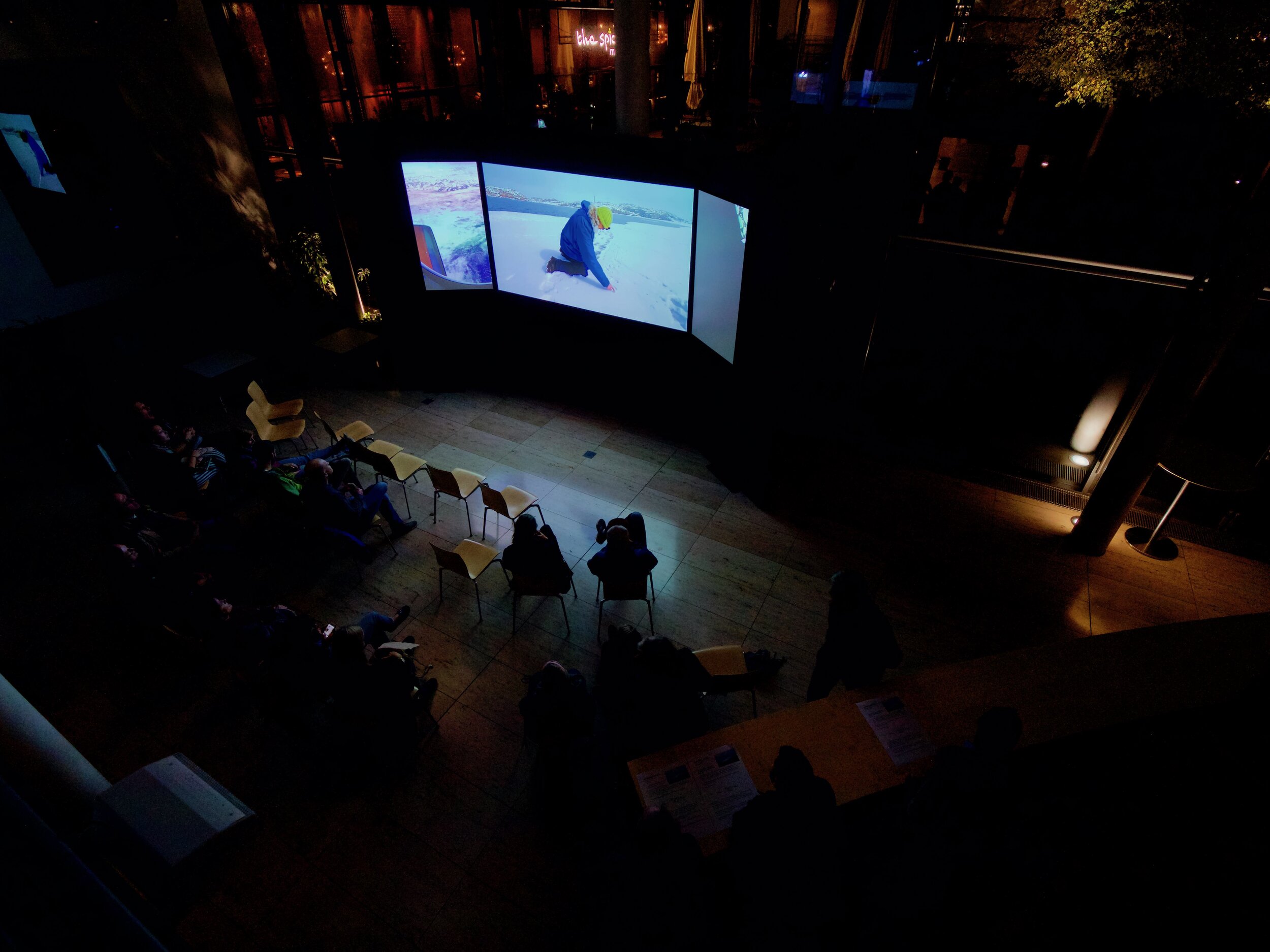

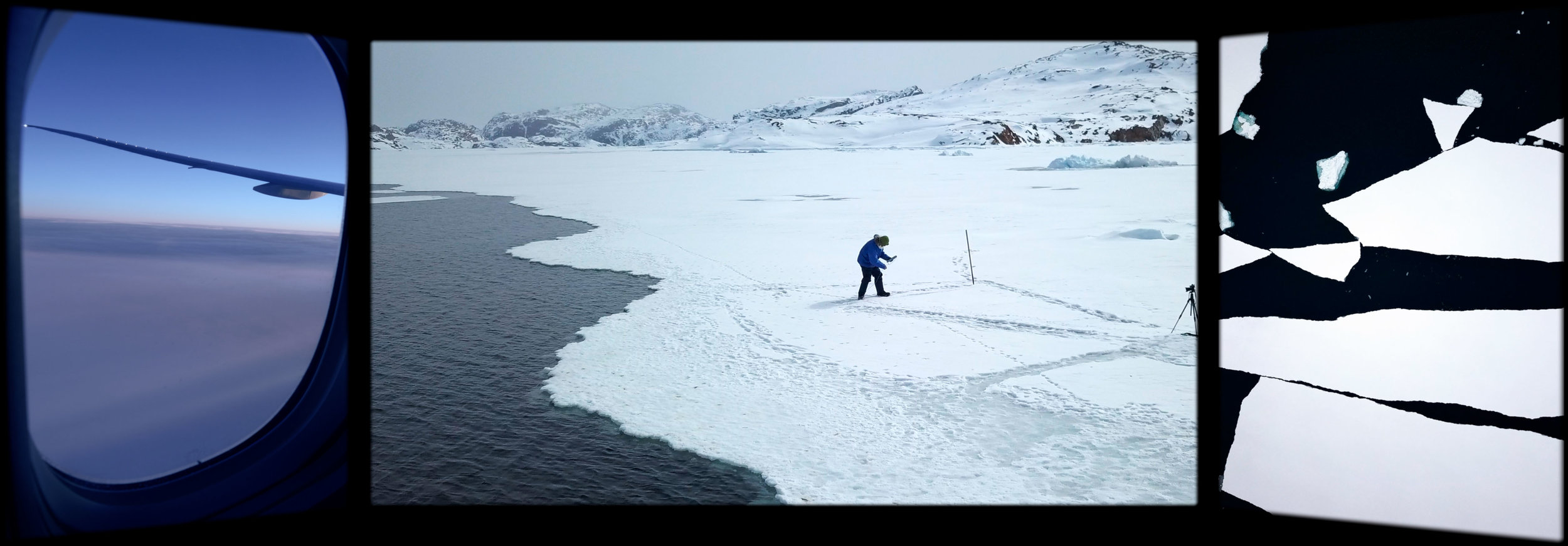
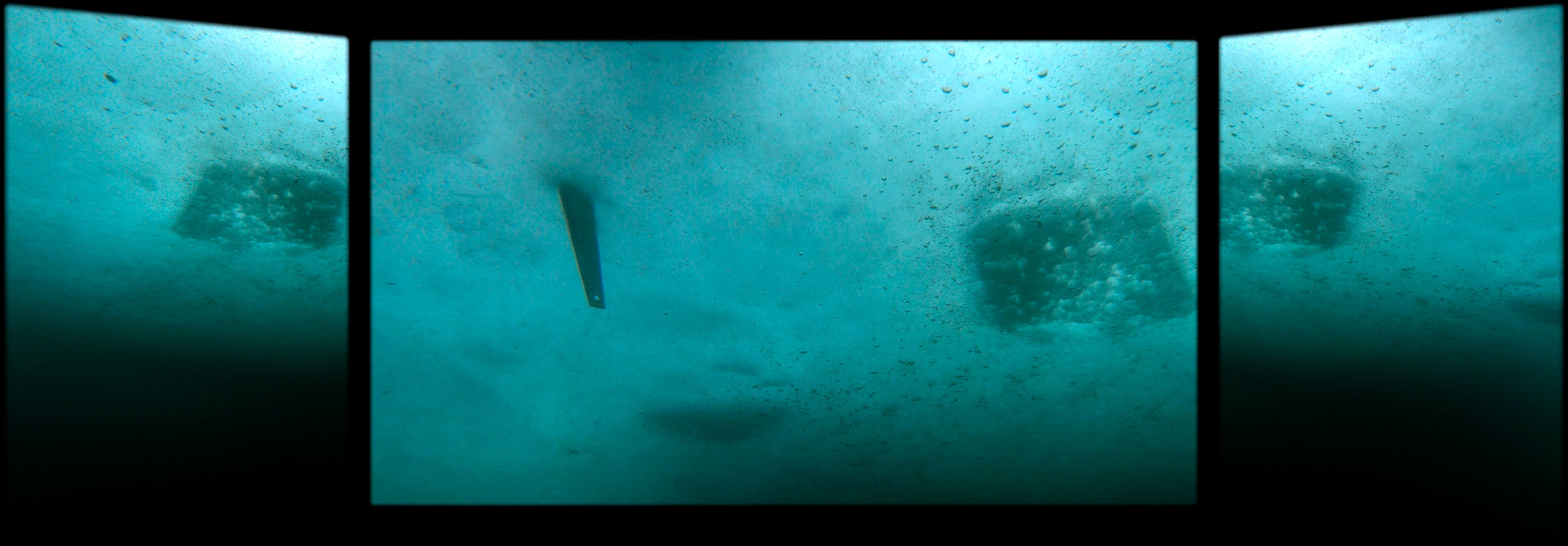
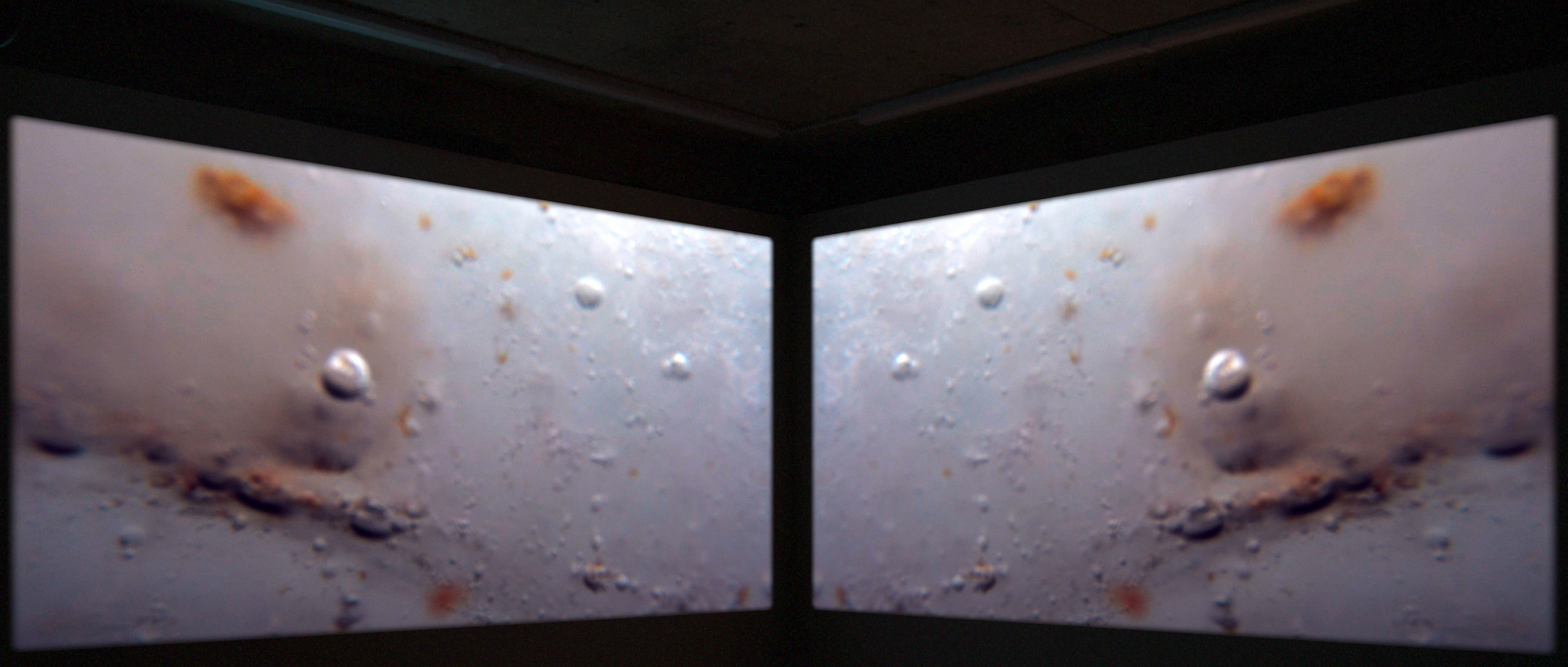
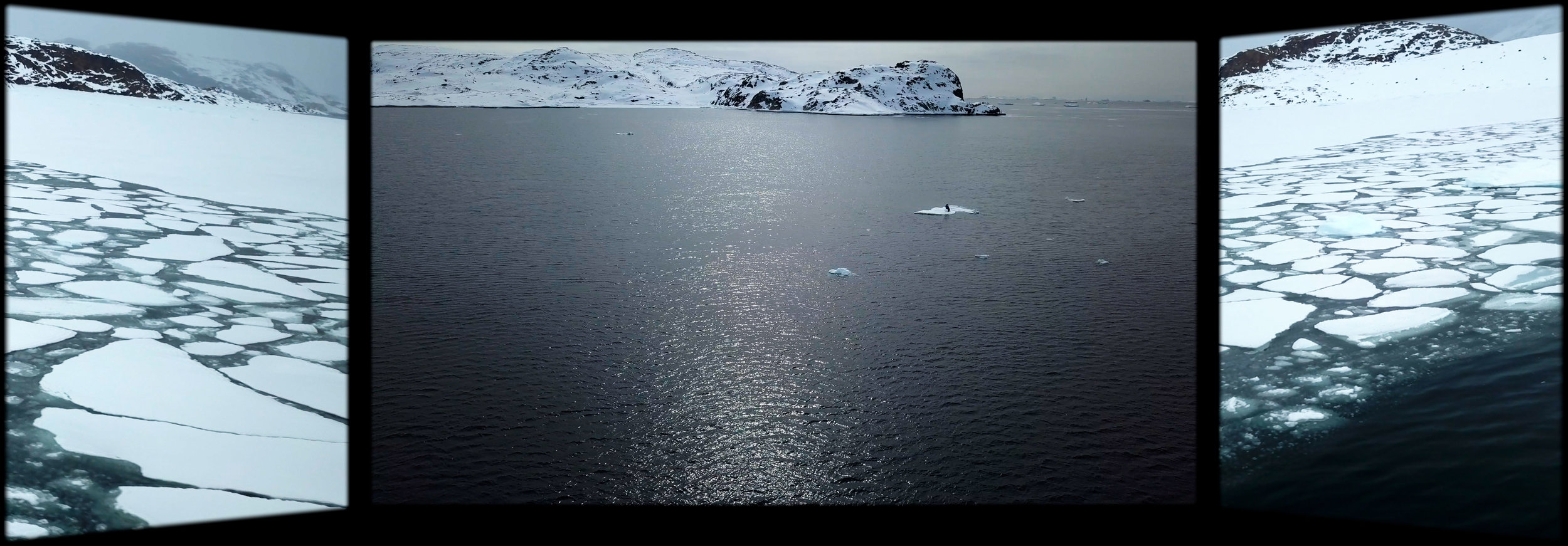

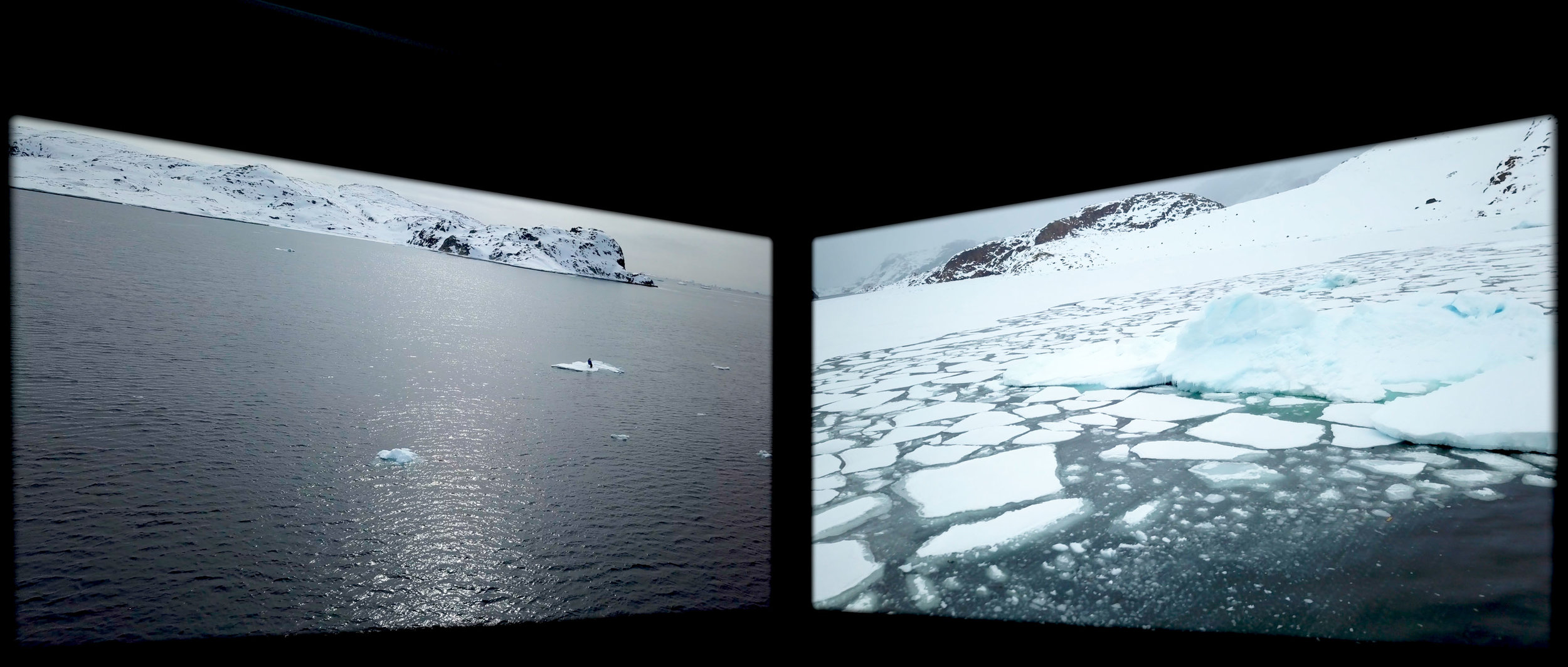
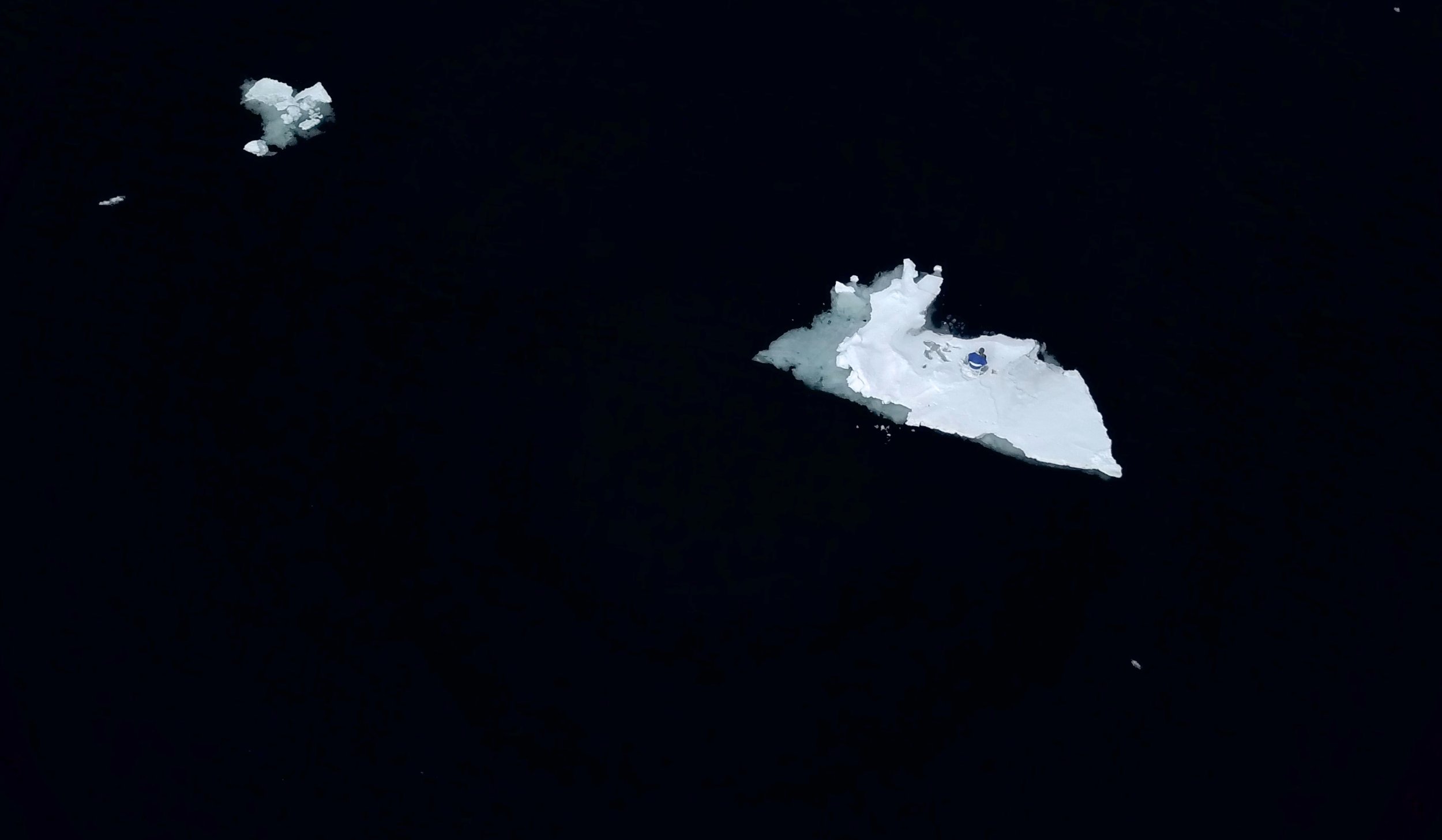
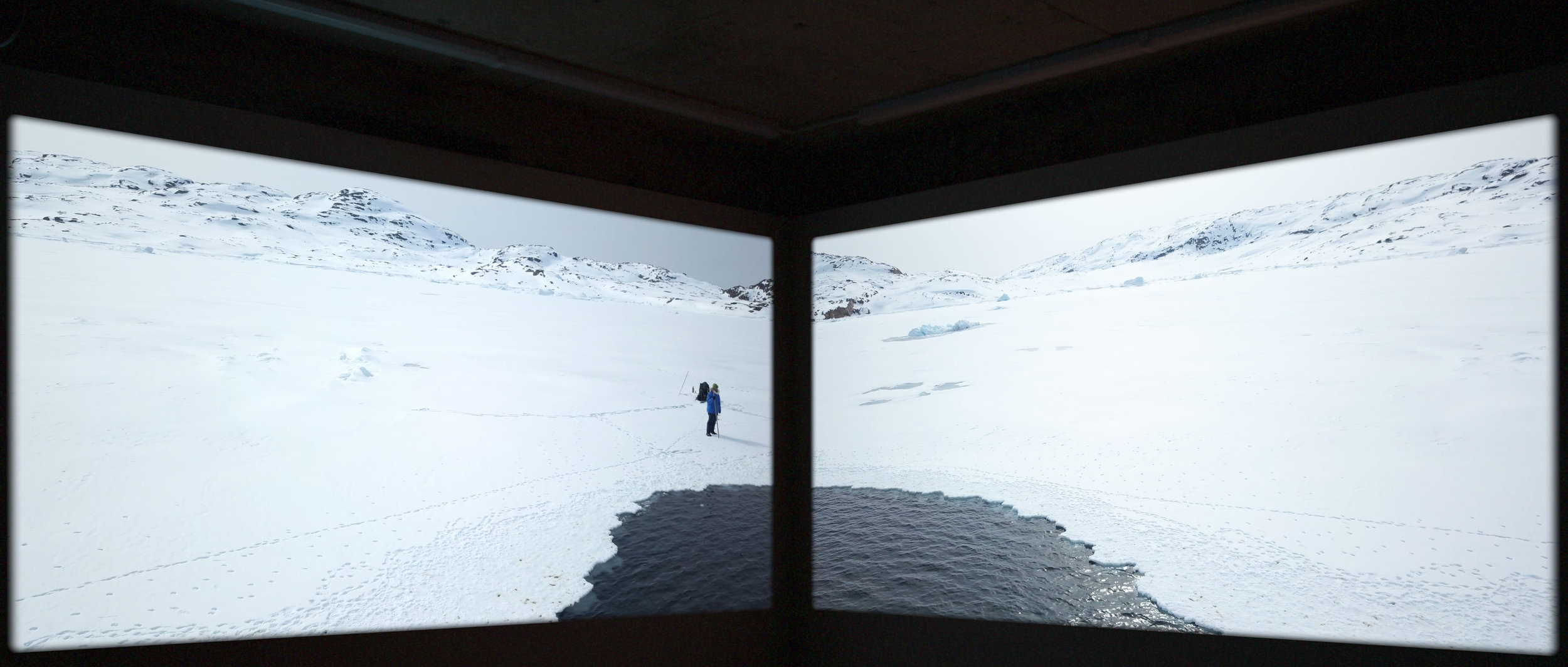
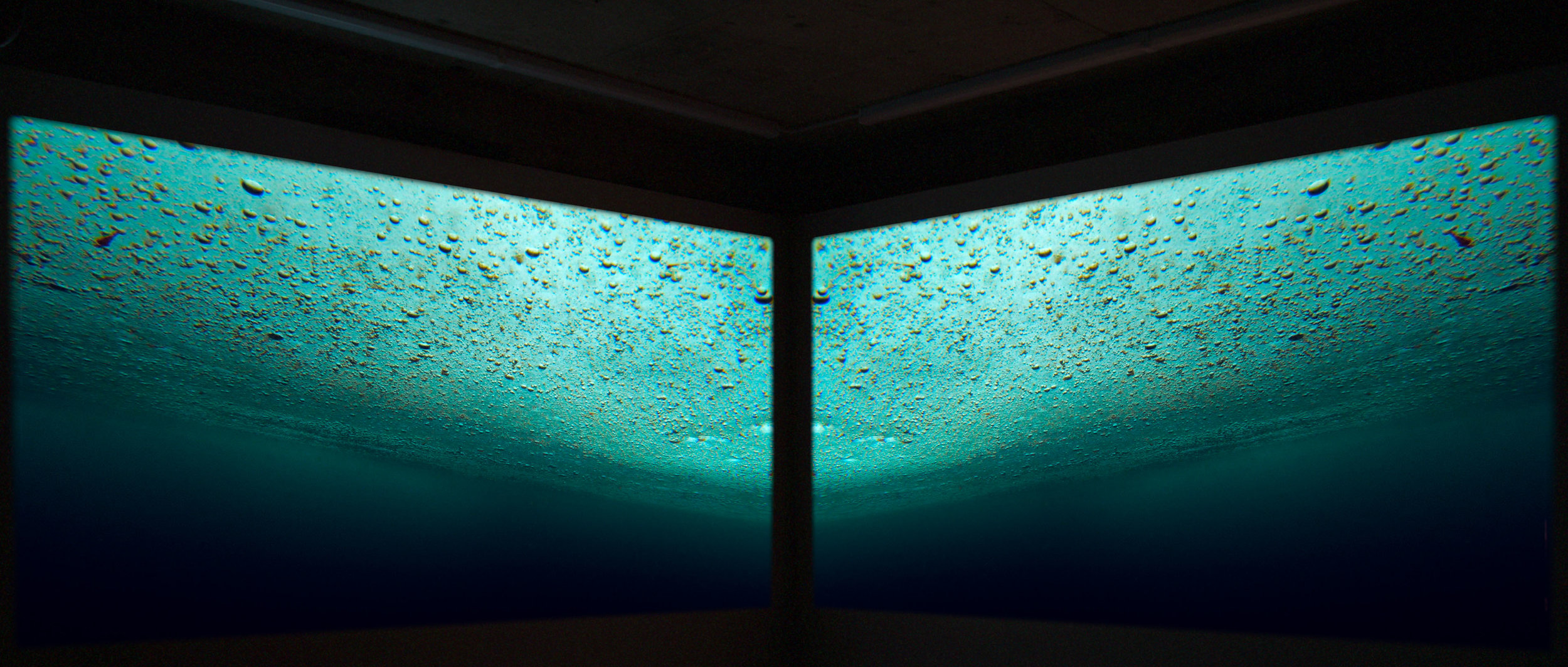
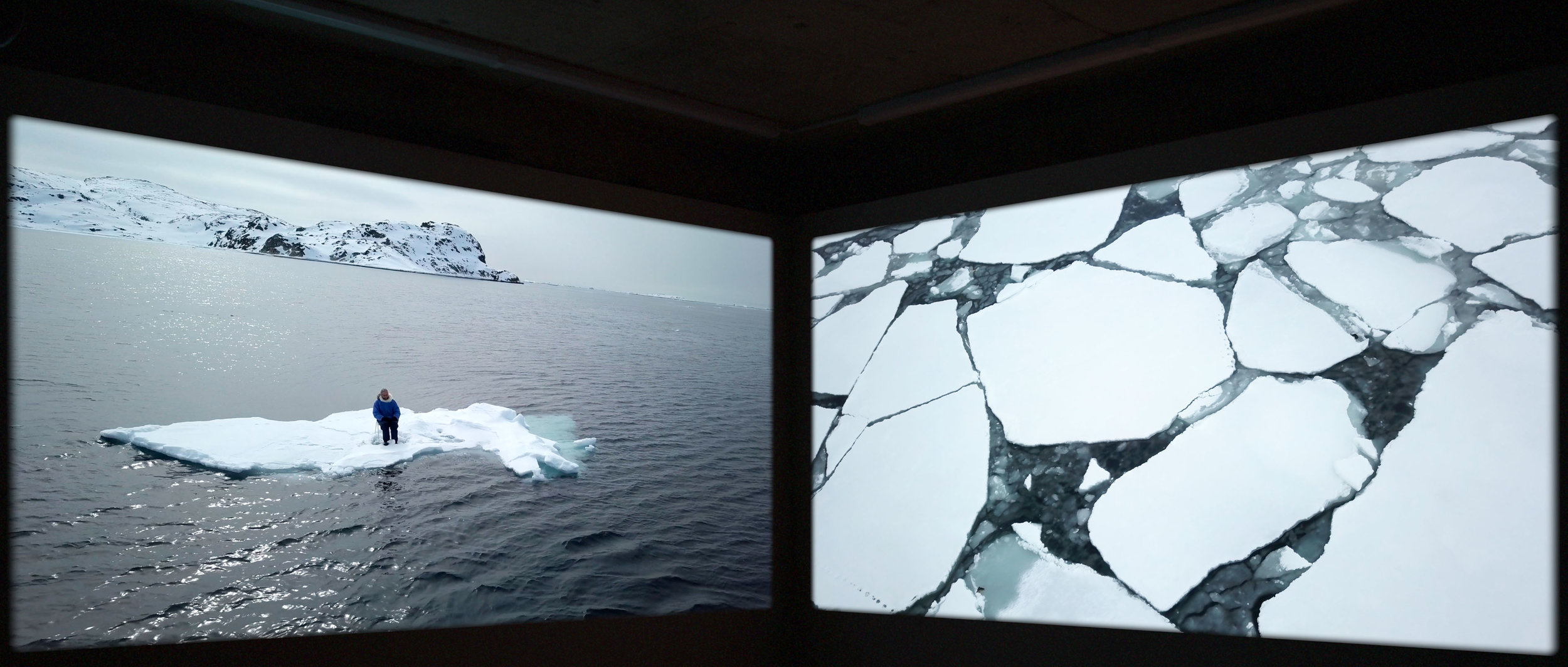
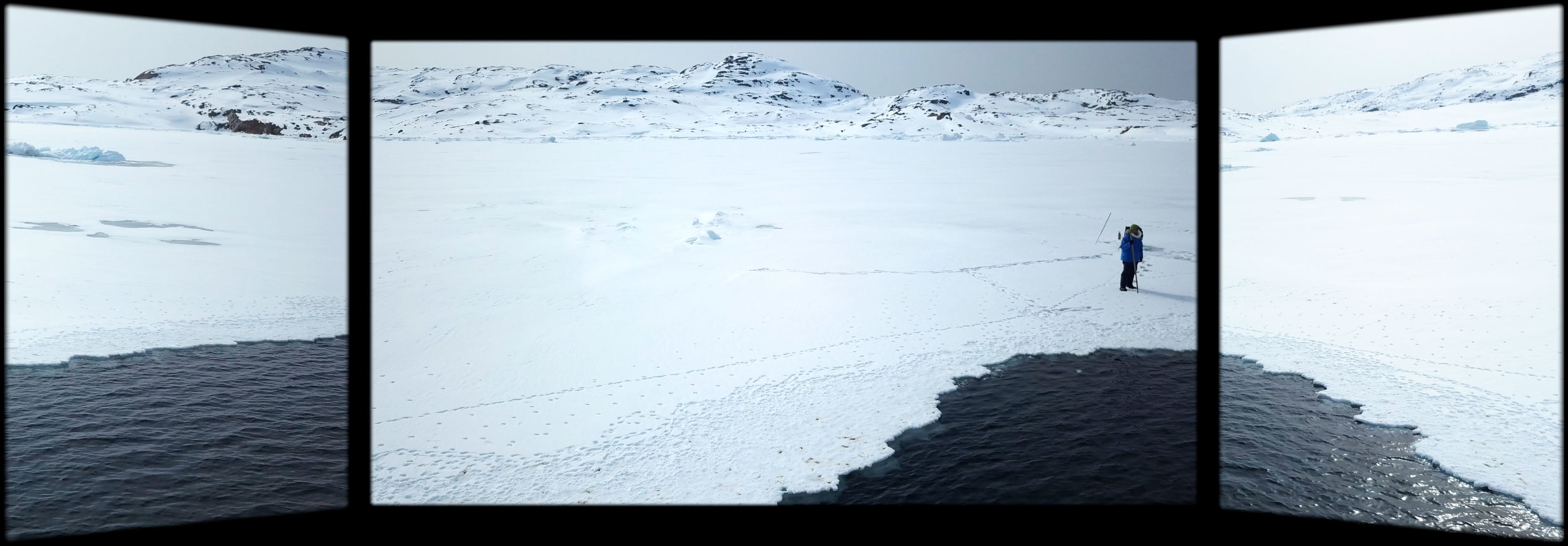
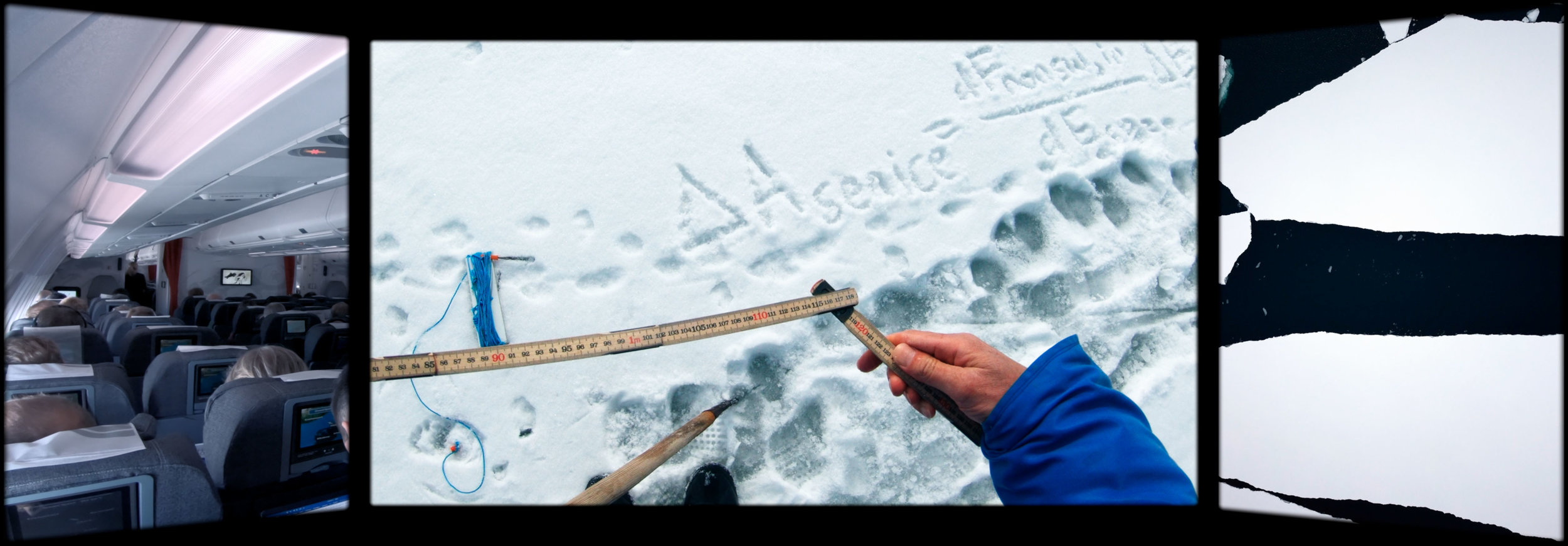
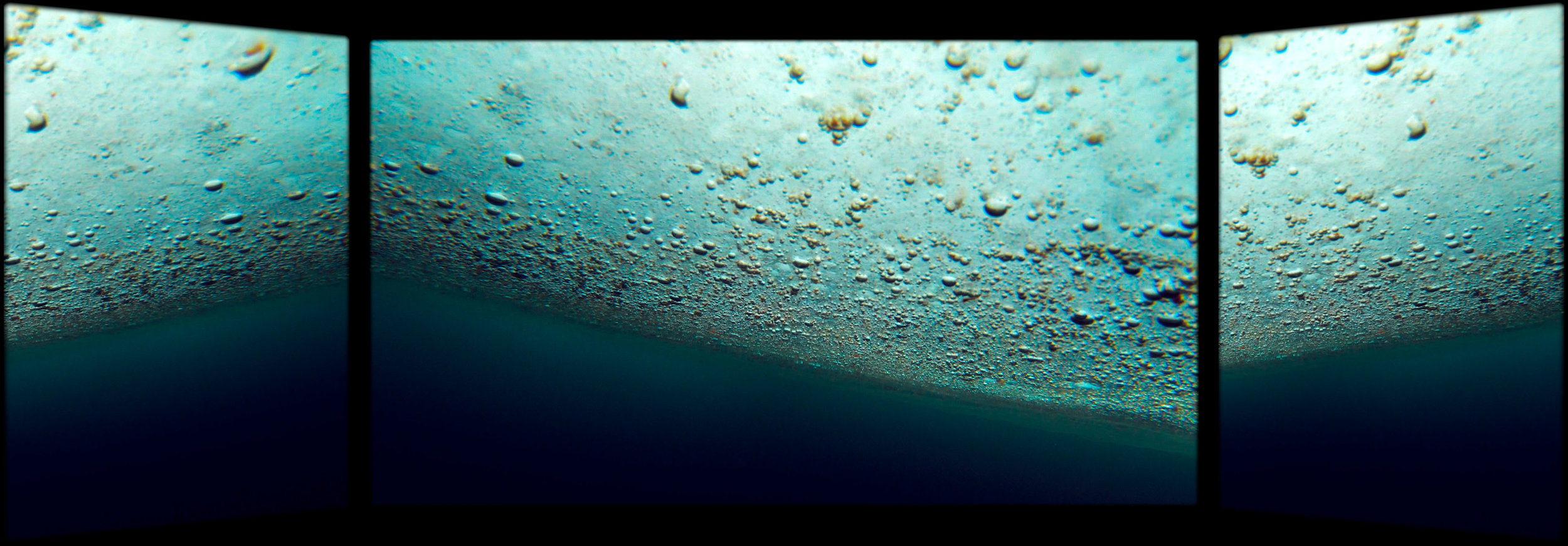
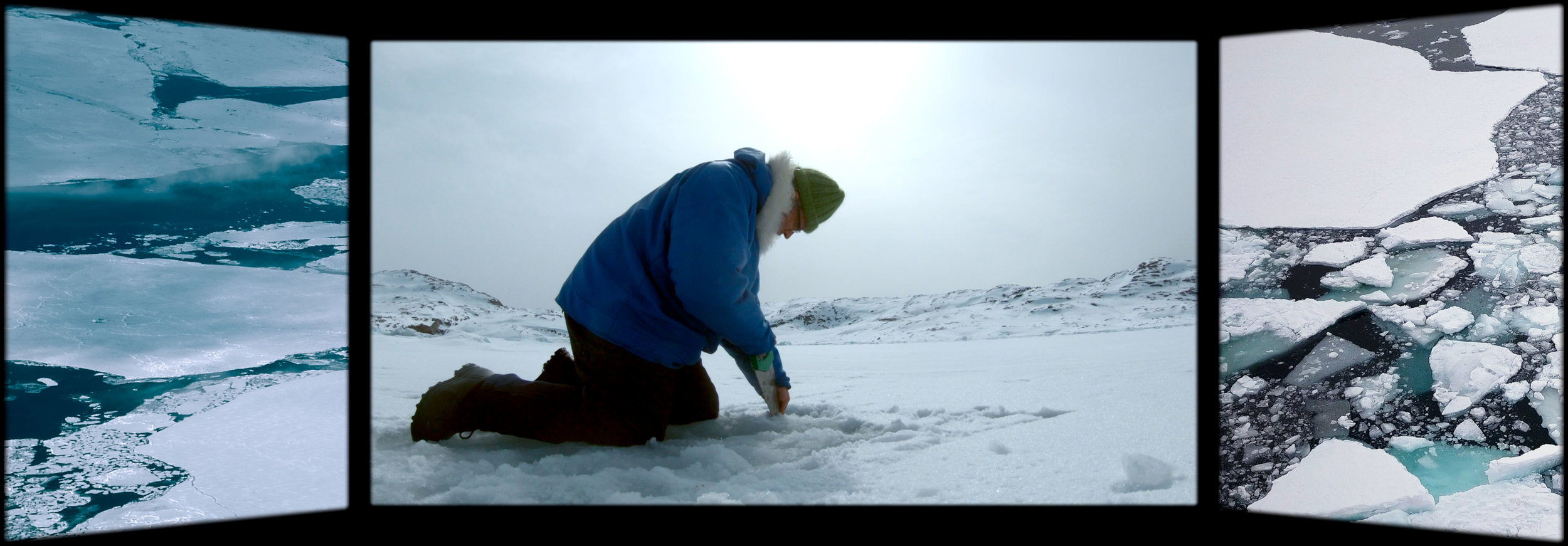

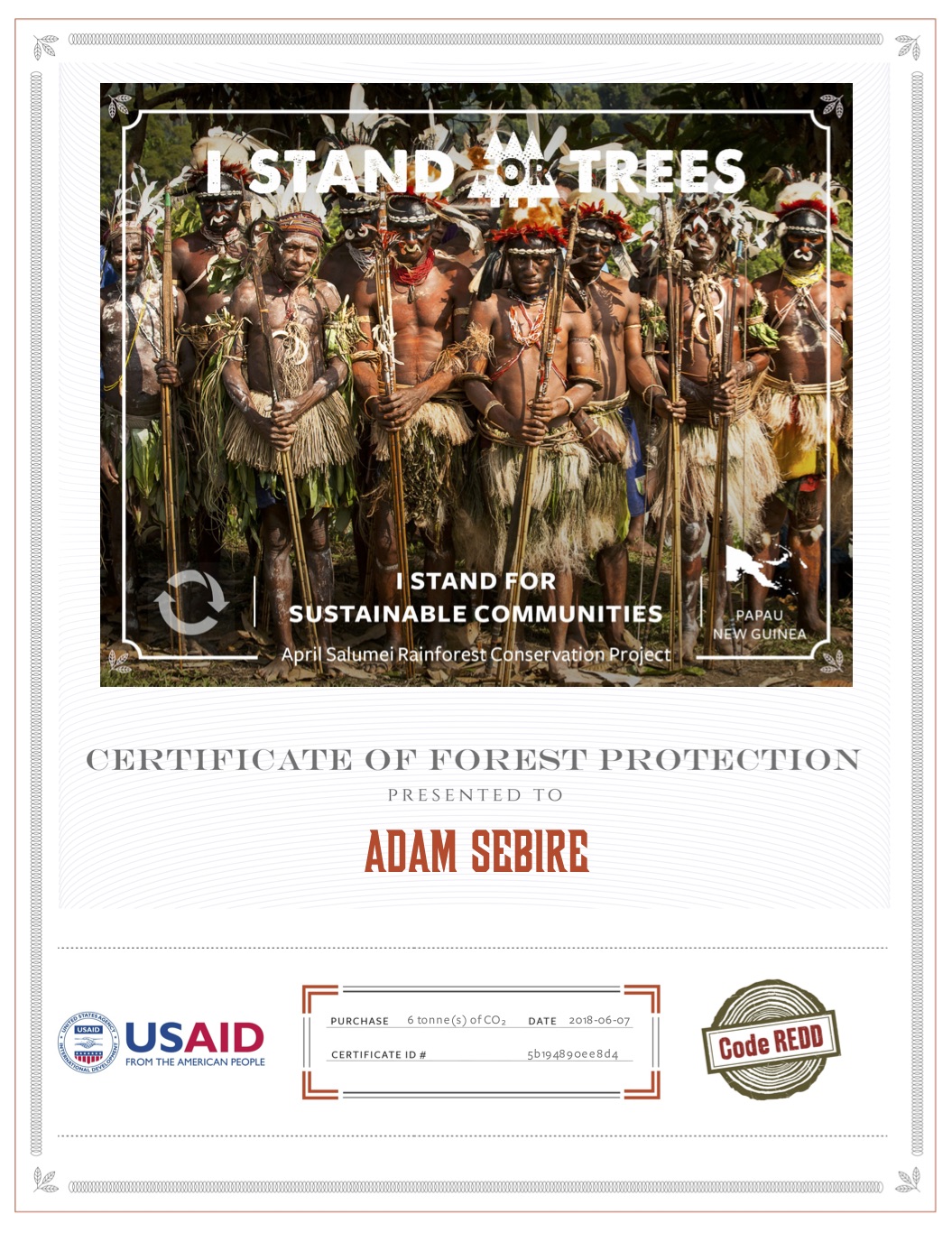
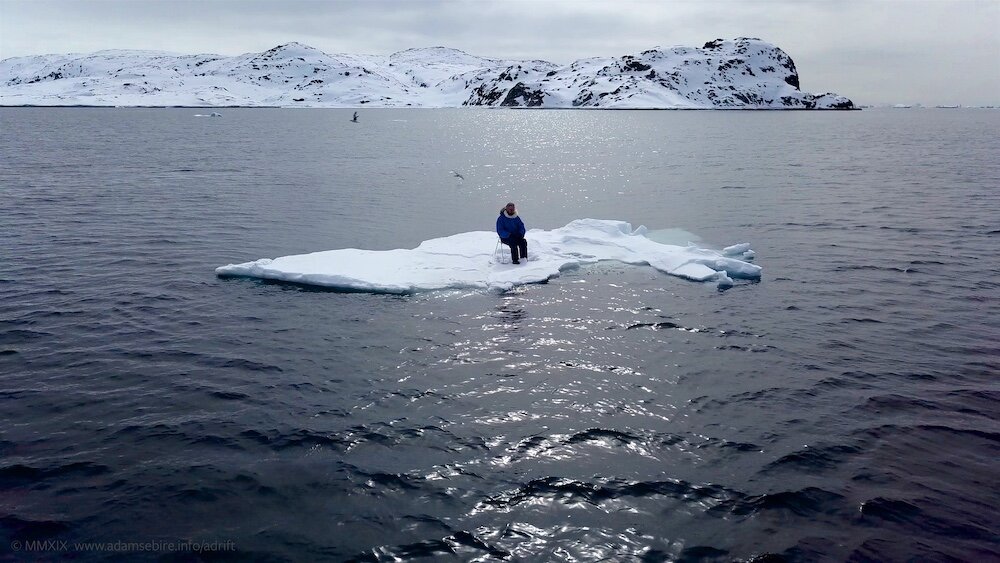

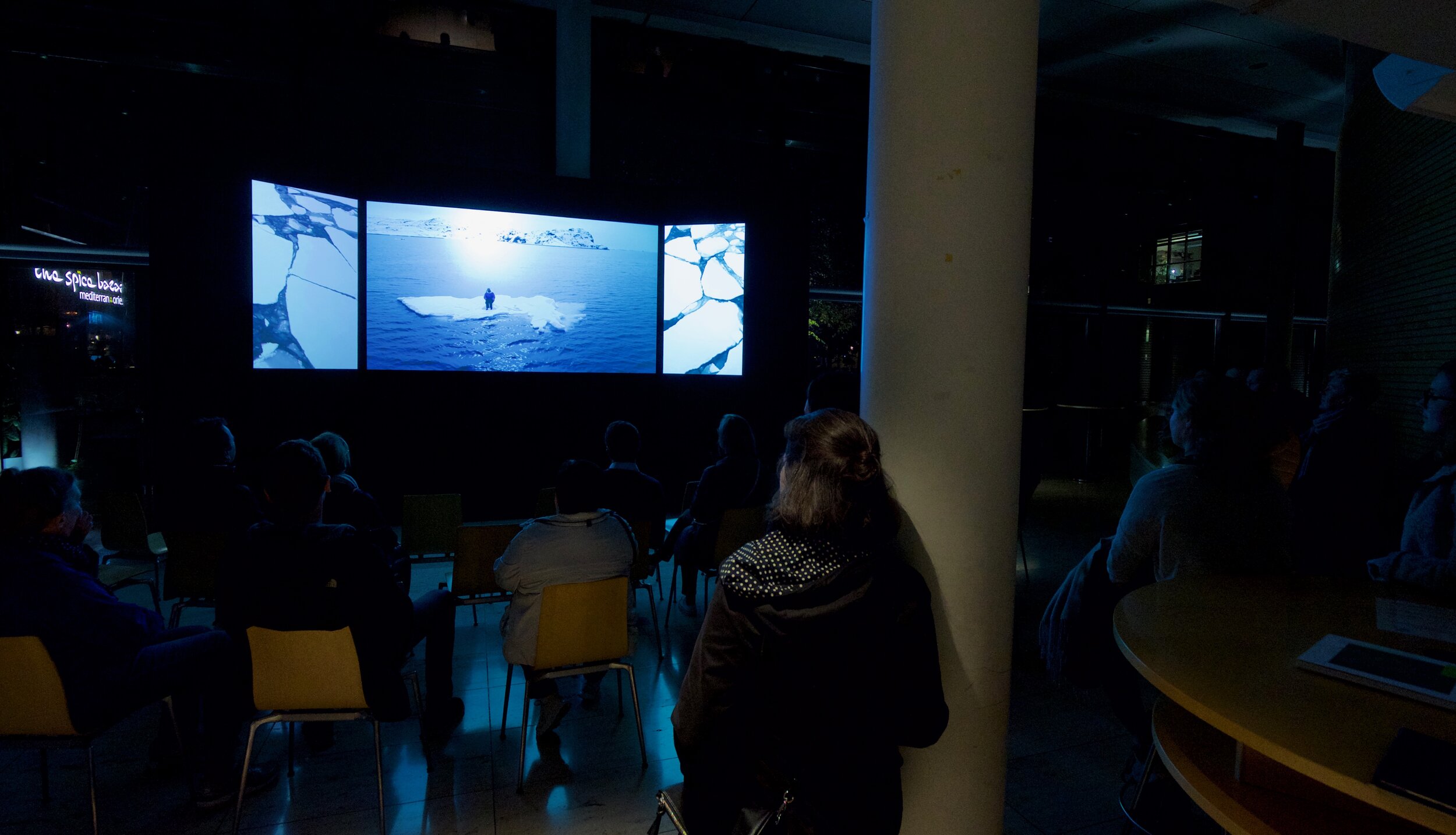
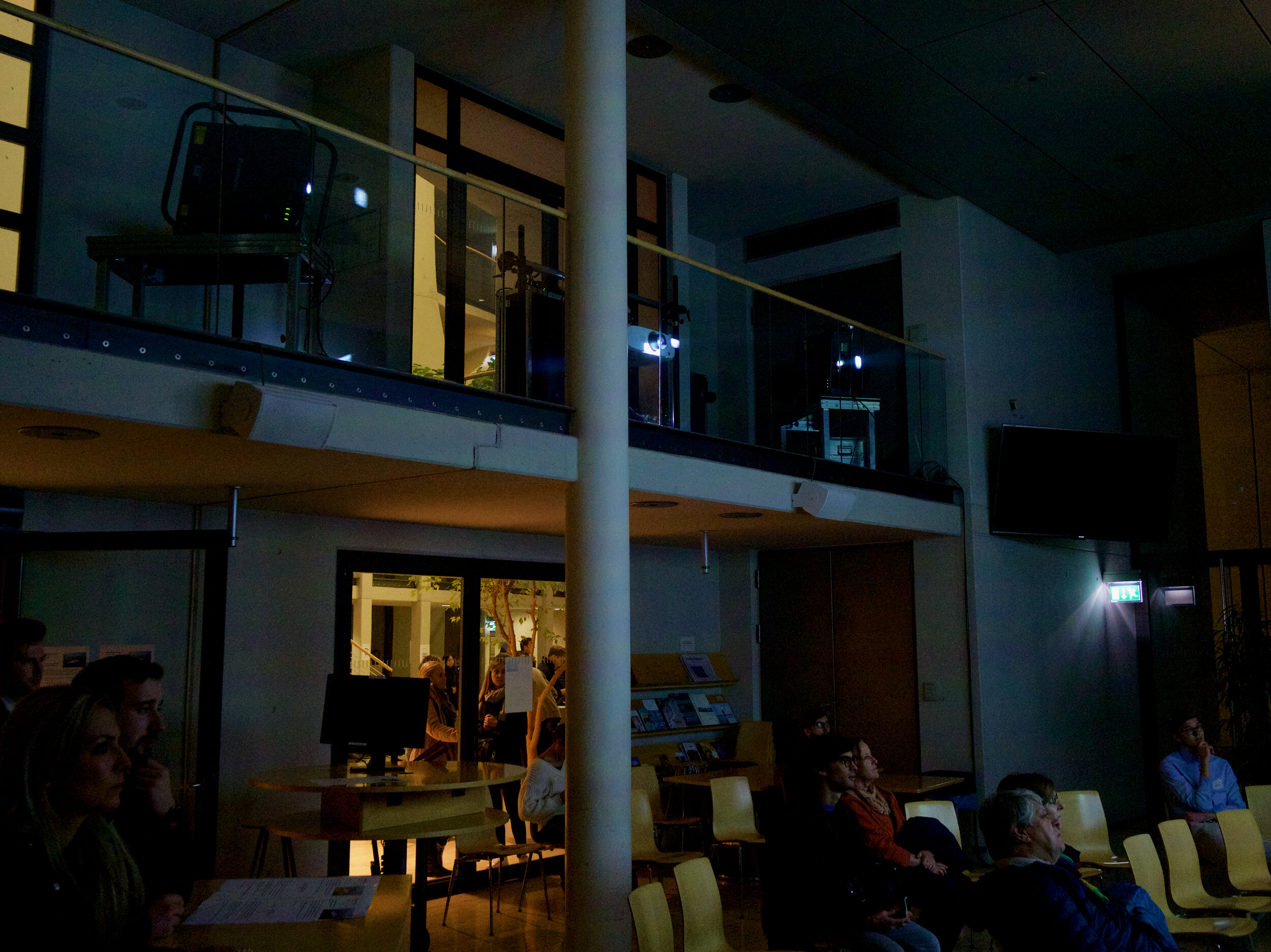
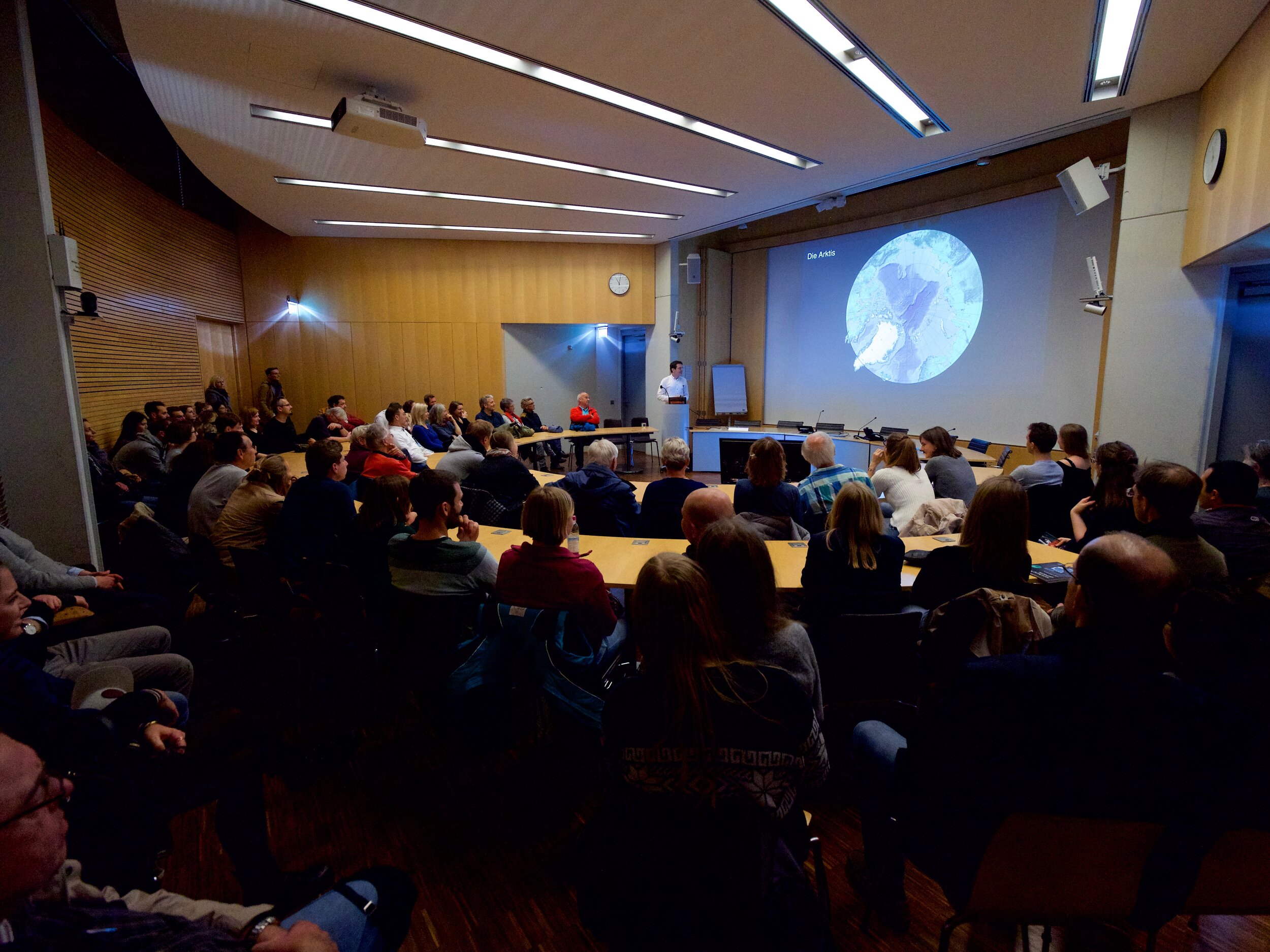
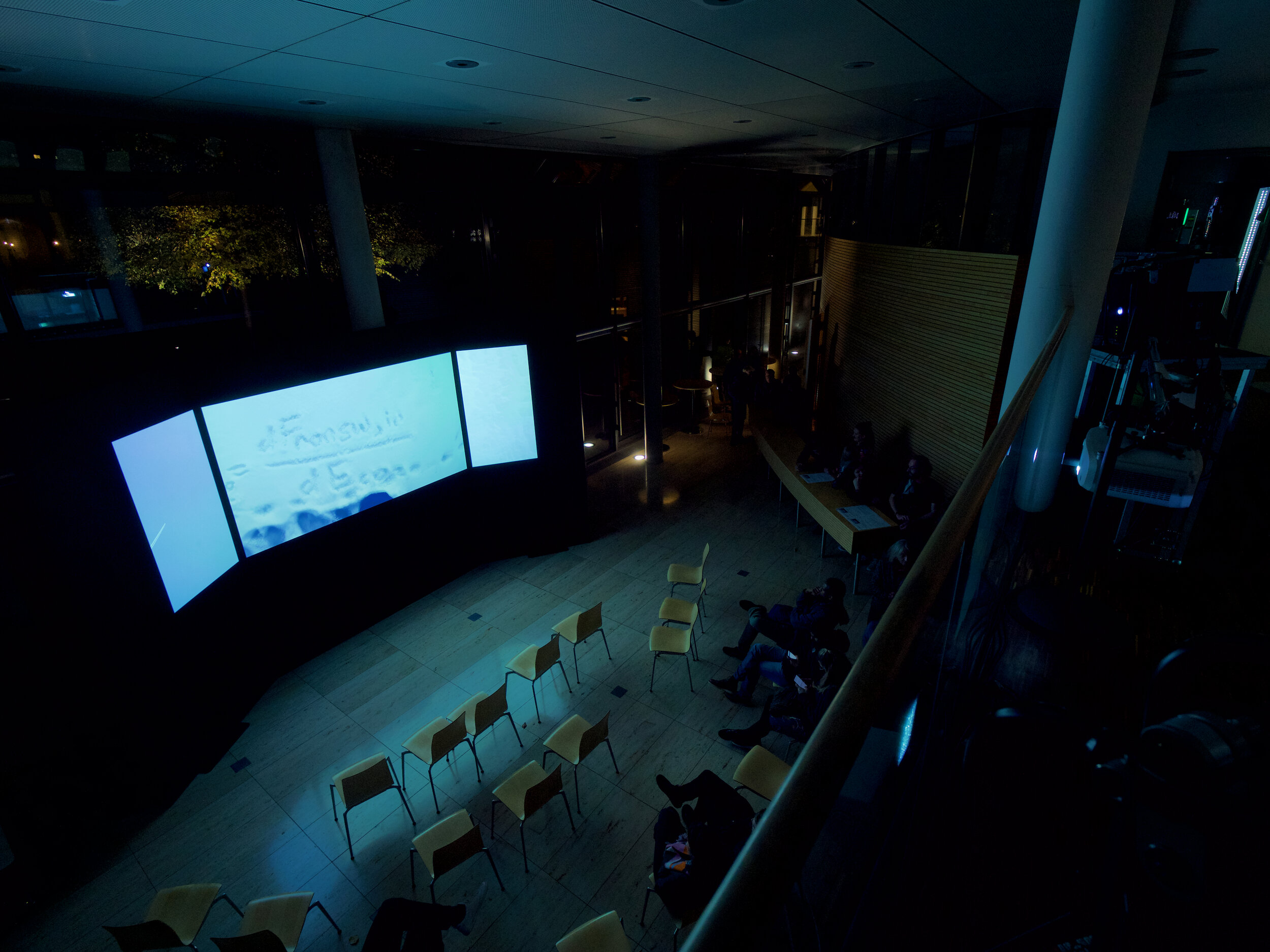
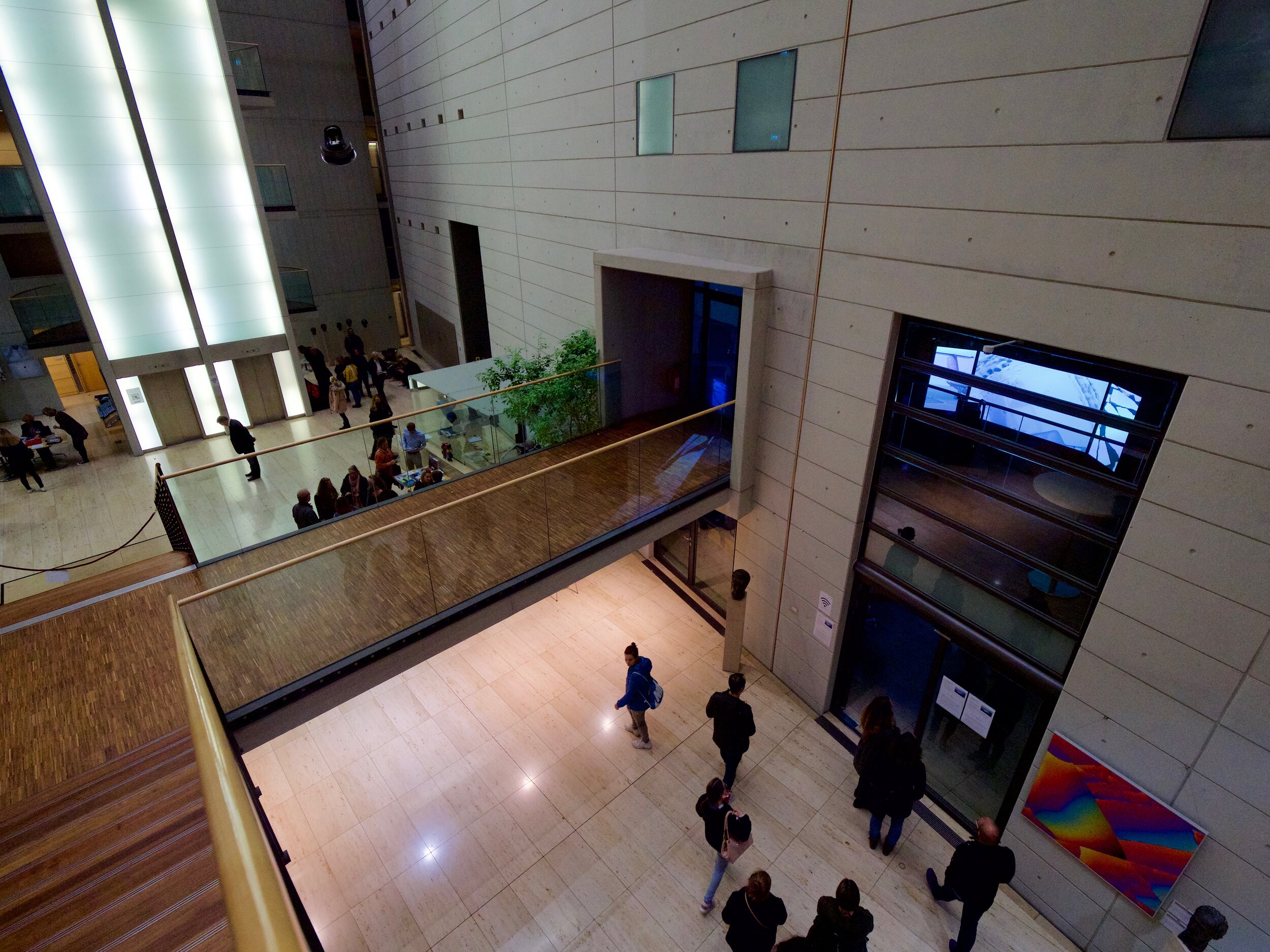
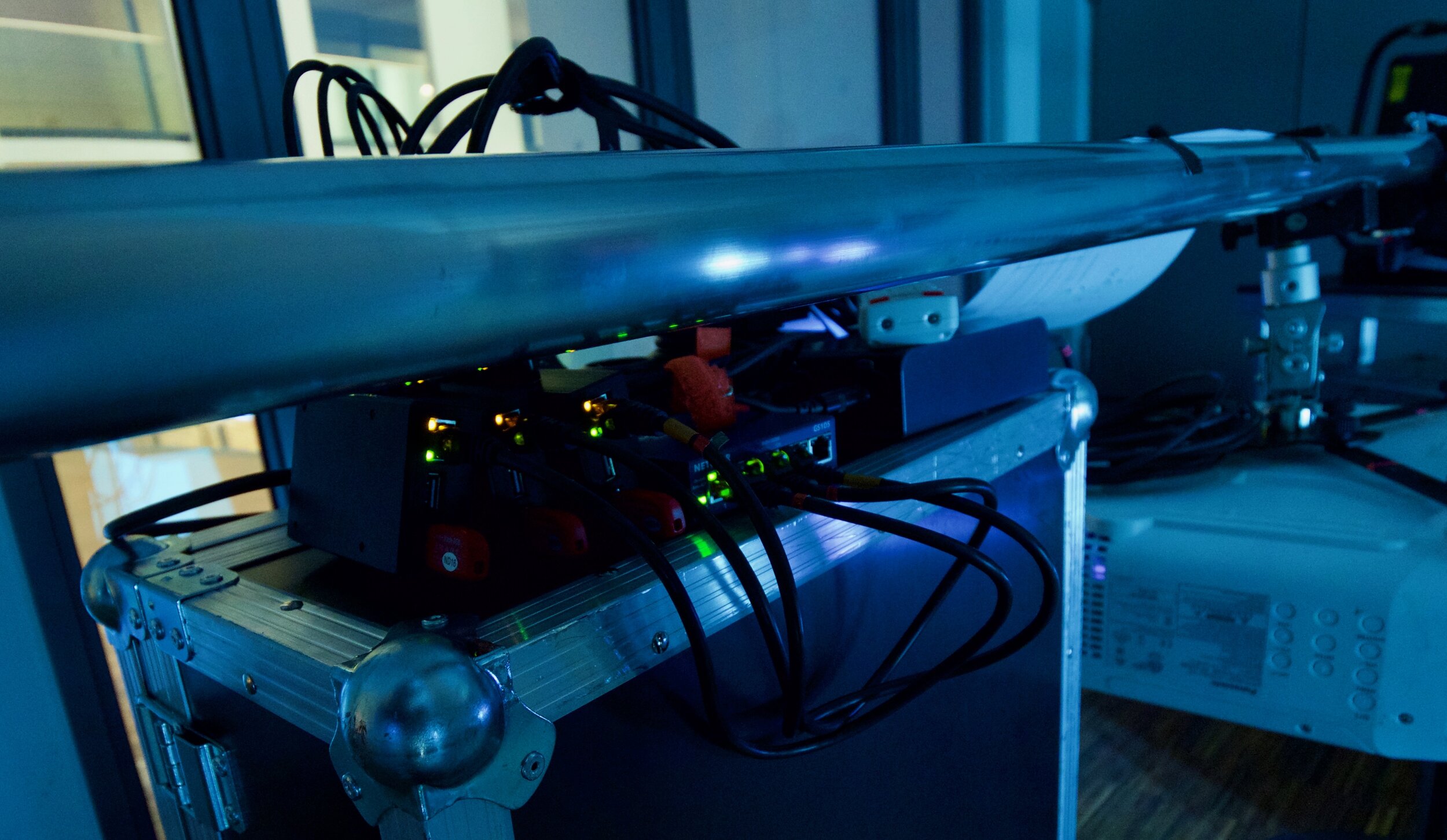

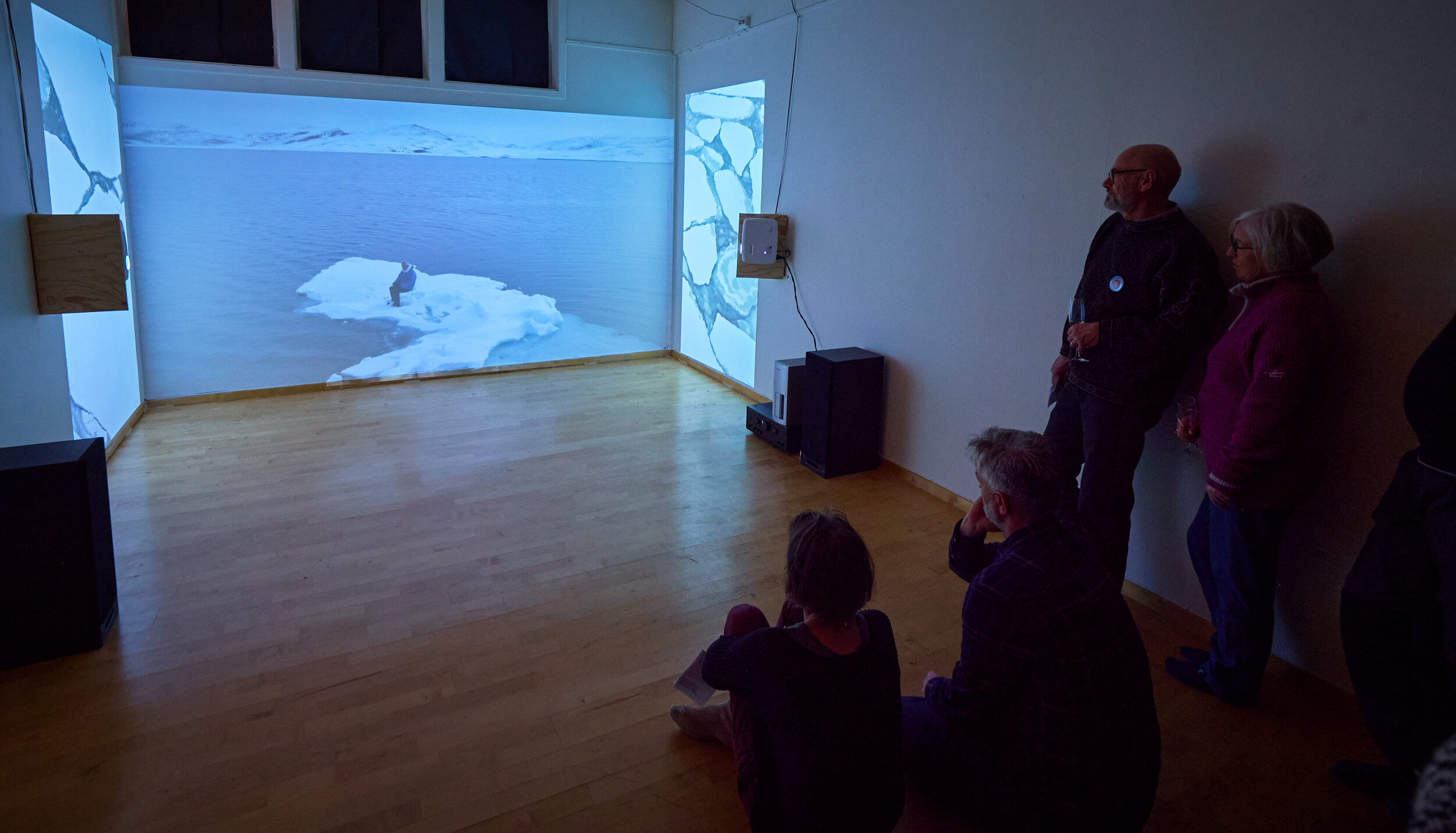
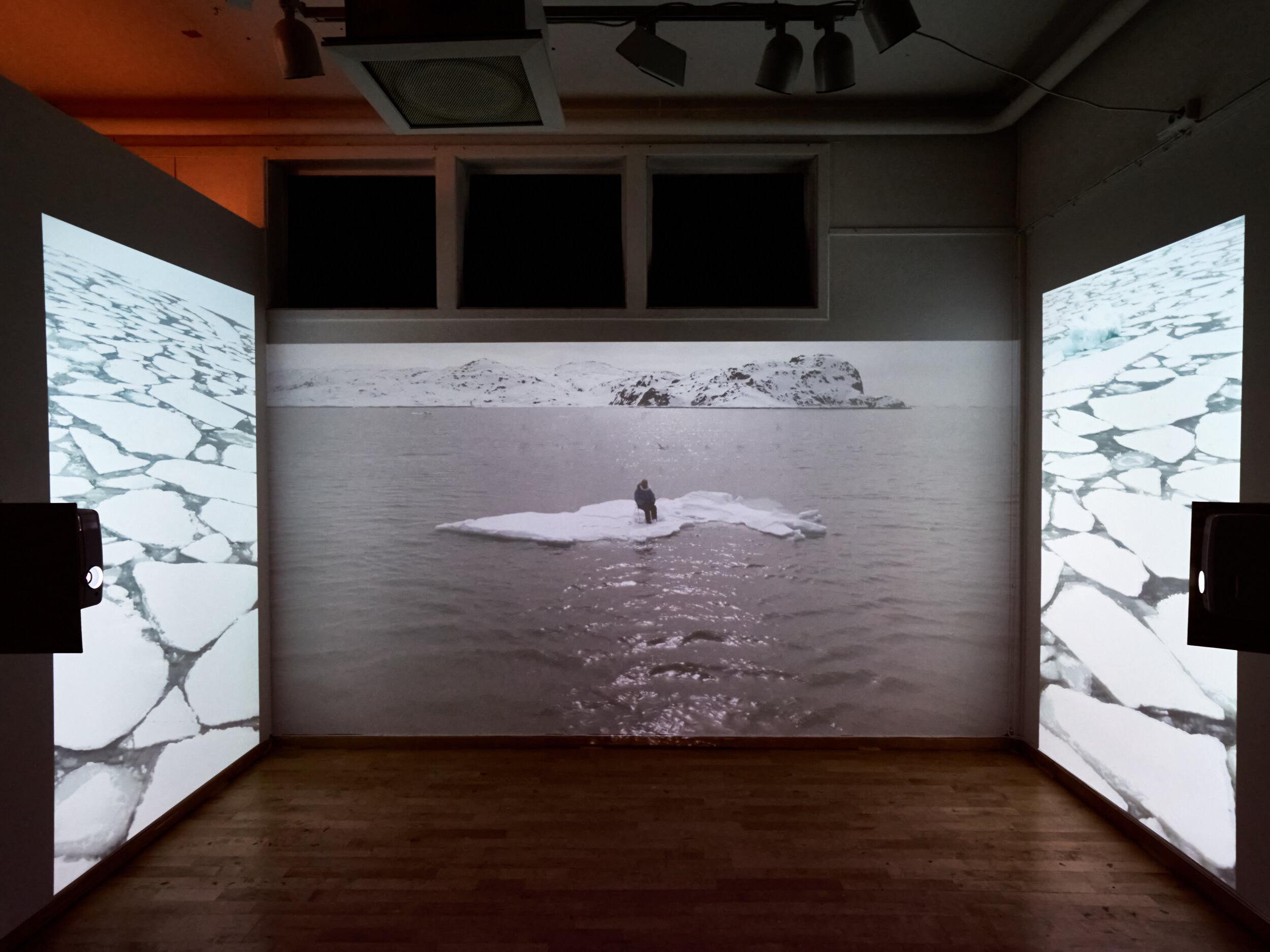

▲ Preview only (video is hidden from Vimeo).
Still photograph from the work, 107cm x 60cm, Edition of 8, are sold by 80:20 Artist Agency in Sydney, Australia (Director: Bill Seeto) AUD$2300.
anthropoScene V : 78ºN +4ºC (2020)
Installation view, Chengdu Biennale 16July-22Nov 2023.
Like an abstract painting in motion, thawing permafrost mixes with soil sediments, mining spill and pieces of coal to change the colours of glacial meltwater along a river in the High Arctic.
Longyearbyen, Svalbard, only 1300km from the North Pole, is warming 5-7 times the global average: 5ºC in the last 20 years. The work was filmed with a drone in early spring, 20 April 2019, as unseasonable temperatures soared well above freezing.
In 1612 the European demand for whale oil marked the beginning of Arctic energy extraction on industrial scale in Svalbard; 300 years later American industrialist John Munro Longyear began extracting coal from the mountains surrounding the main settlement, Longyearbyen.
Now the effects on Earth's climate from burning all of these fossil fuels is rapidly transforming the surrounding Arctic ecosystems, as the circuit between cause & effect collapses.
Dur: 3'12" 4K single-channel, audio optional.
Premièred at the anthropoScenes solo exhibition by Adam Sébire for the 25th anniversary show of the world’s northernmost public art museum:
Gallery Svalbard, 8 March to 24 August 2020. © Adam Sébire
anthropoScene VI : Mозаика (Mosaic) (2021)
4-channel video, 8’42”. Completion: Oct 2021.
1200km from the North Pole, the Nordenskiöld Glacier's ice crumbles. 12km further on, a canteen for Soviet workers in the abandoned coal mining town of Pyramiden houses a disintegrating mosaic (мозаика) depicting a mythical, pristine Arctic landscape.
The four-channel video (which may be presented as single-channel split-screen as in the preview, right) draws on gestaltist 'visual field force theory' to establish a dialogue between these sites of decay & impermanence.
Finalist in the International Competition for Intermedia Artwork, Krakow, Poland, November 2022; part of the Glacial Narratives exhibition Taigh Chearsabhagh Gallery (Hebrides, UK) Oct ‘21-Jan’22.
Above: Three Svalbard Mines (still photographs, triptych, 2018-21). Bookending Svalbard’s coal-mining history, Gruve 2B (right, 1913-1964) and Gruve 7 (left, 1976-2025); in between, the abandoned Soviet mining town of Pyramiden (1910-1998). Each leaches its mineral spoil down melting glacial valleys of this High Arctic archipelago.
anthropoScene VII : Sikujumaataarpoq (2022-23)
Multi-screen 4 ch video projection; 2.1 ch audio.
Long version: 53’58” (5’40” split-screen teaser, left)
An immersive audiovisual installation from a remote part of Earth's melting polar regions, where water is found in its solid form. Video vignettes linked by West Greenlandic words for this icy environment focus on the humans & non-humans whose existence there is undergoing rapid transformation. Its audio samples ice sounds collected by cryosphere scientists working around the globe.
Sikujumaataarpoq is the Kalaallisut word meaning "sea ice formation is delayed”.
BACKGROUND
Uummannaq Island is a small indigenous Inuit settlement placed well above the Arctic Circle in Kalaallit Nunaat (Greenland) at 70.7º North. This four-channel work was filmed during the 3-month polar night when the sun remains resolutely below the horizon till February. It's a season when outsiders vanish and locals get down to business on sea frozen solid. At least that’s what used to happen; under the influence of climate change the Earth’s poles are warming 2-4 times more rapidly than the rest of our planet.
Many of Uummannaq's 1,400 residents recall being able to travel by dog sledge across thickly-frozen sea ice to settlements dotting the fjord from the Christmas holidays until May, most years. But ice coverage and stability have decreased dramatically over the last decade. In 2022, the fjord would provide barely two months of reliably solid sea ice for on-ice activities such as hunting, ice-fishing, dog sledging and community events.
The changes to everyday life and traditions are as profound as they are to the fragile environment. Unable to use sledge dogs or boats easily, the months-long interregnum between open water and solid sea ice poses great difficulties for these First Nations inhabitants living remote, semi-subsistence existences.
For the filmmaker, waiting for the sea ice to form in the dark and cold was relieved by pilgrimages to sublime inland ice, polished slippery and snowless by unusually strong, warm winds. Beneath its cracked surface were trapped bubbles of methane, a potent greenhouse gas and, along with sea ice loss, a potential Arctic "tipping point” capable of triggering further rapid climatic transformation across our planet.
Kalaallisut words for this icy environment dot the video vignettes like waypoints emerging from beneath melting snows.
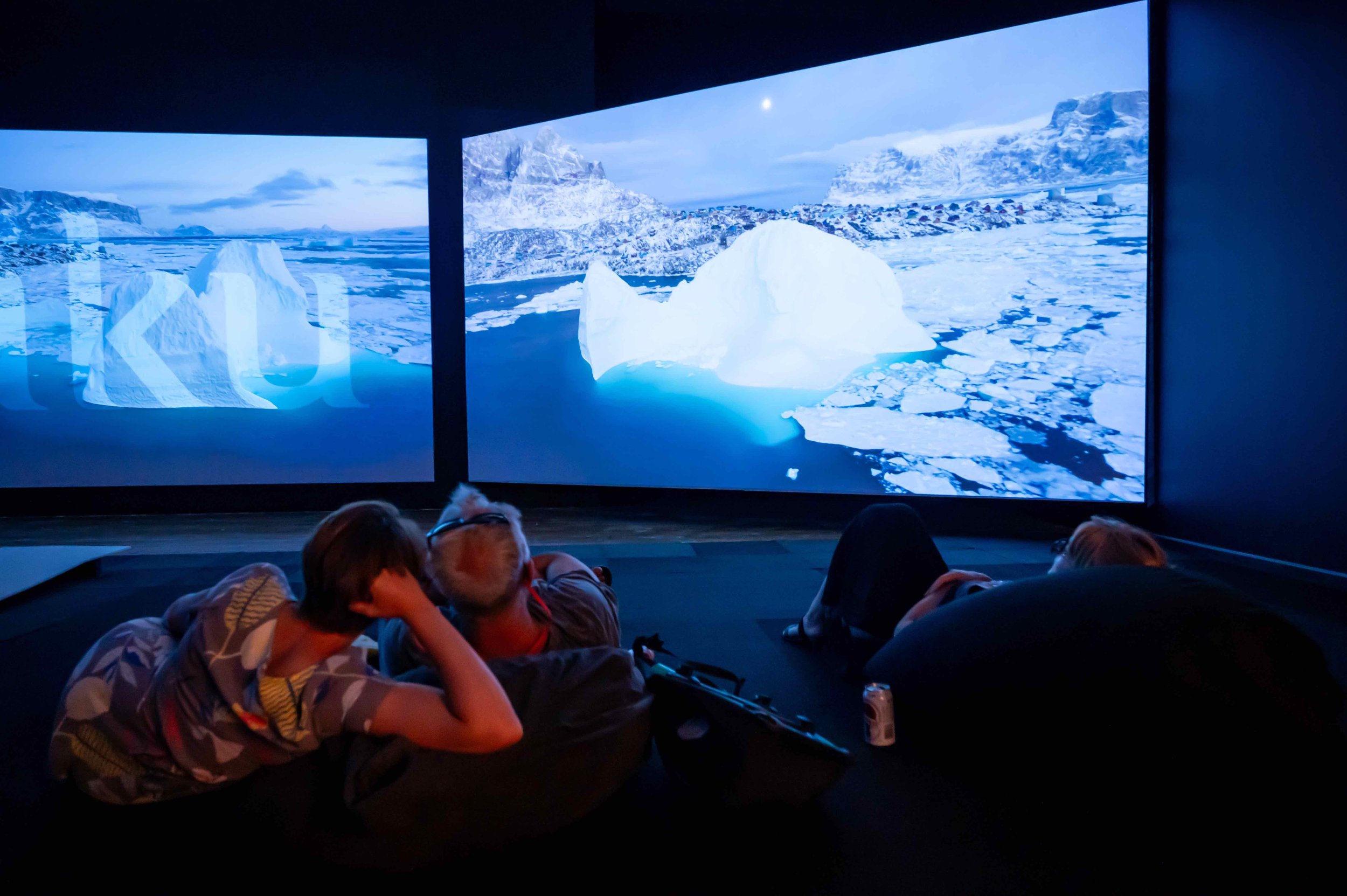
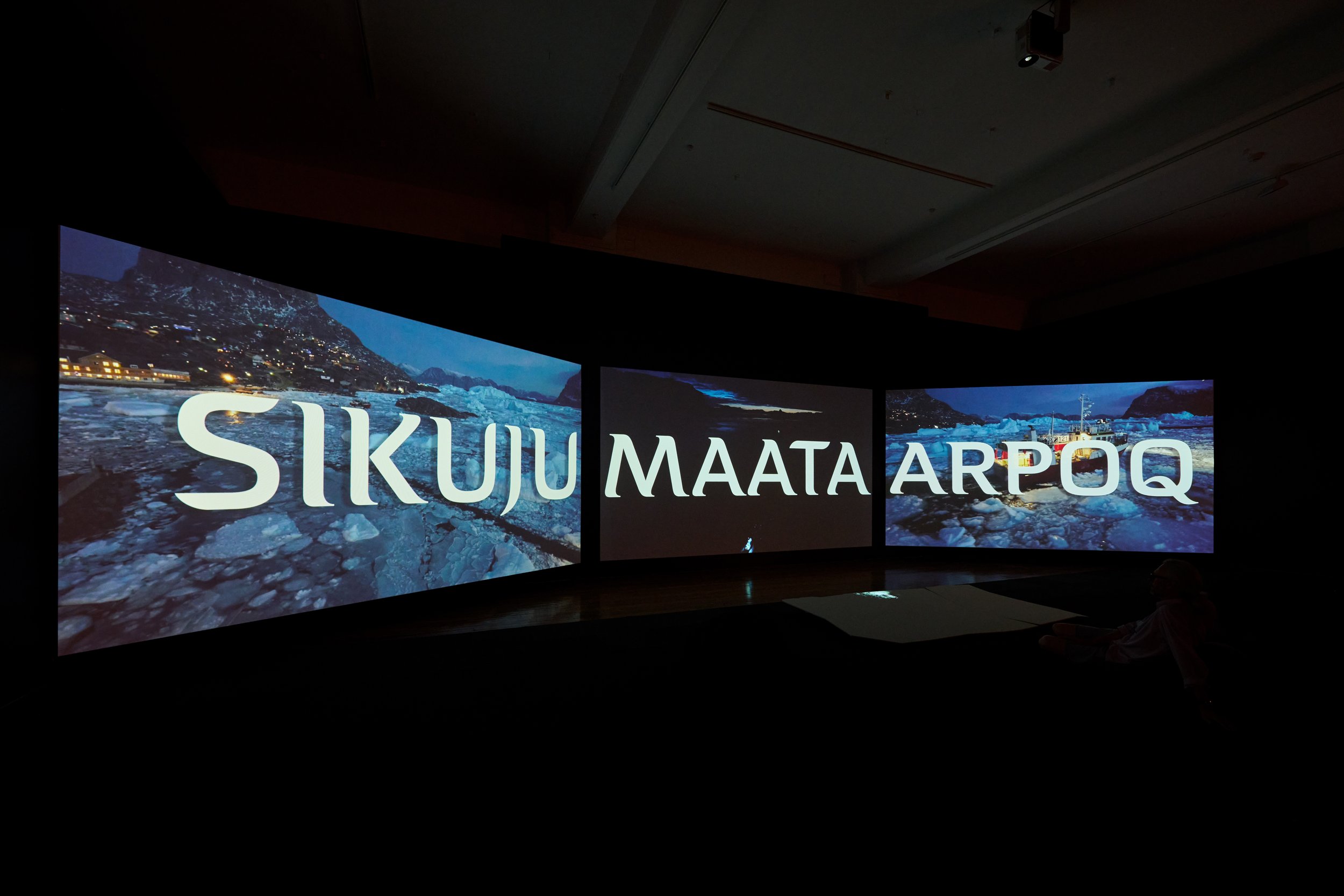
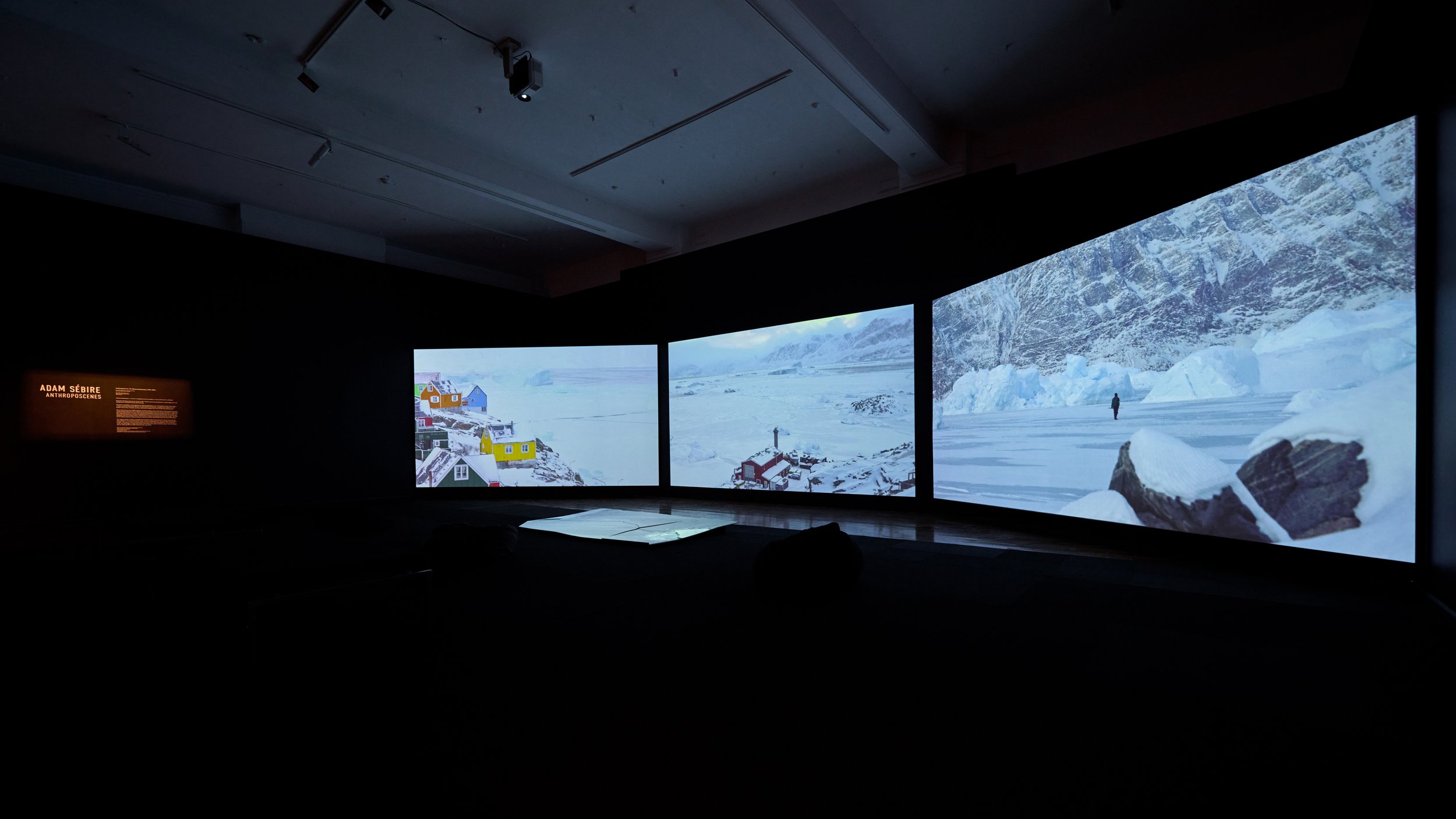
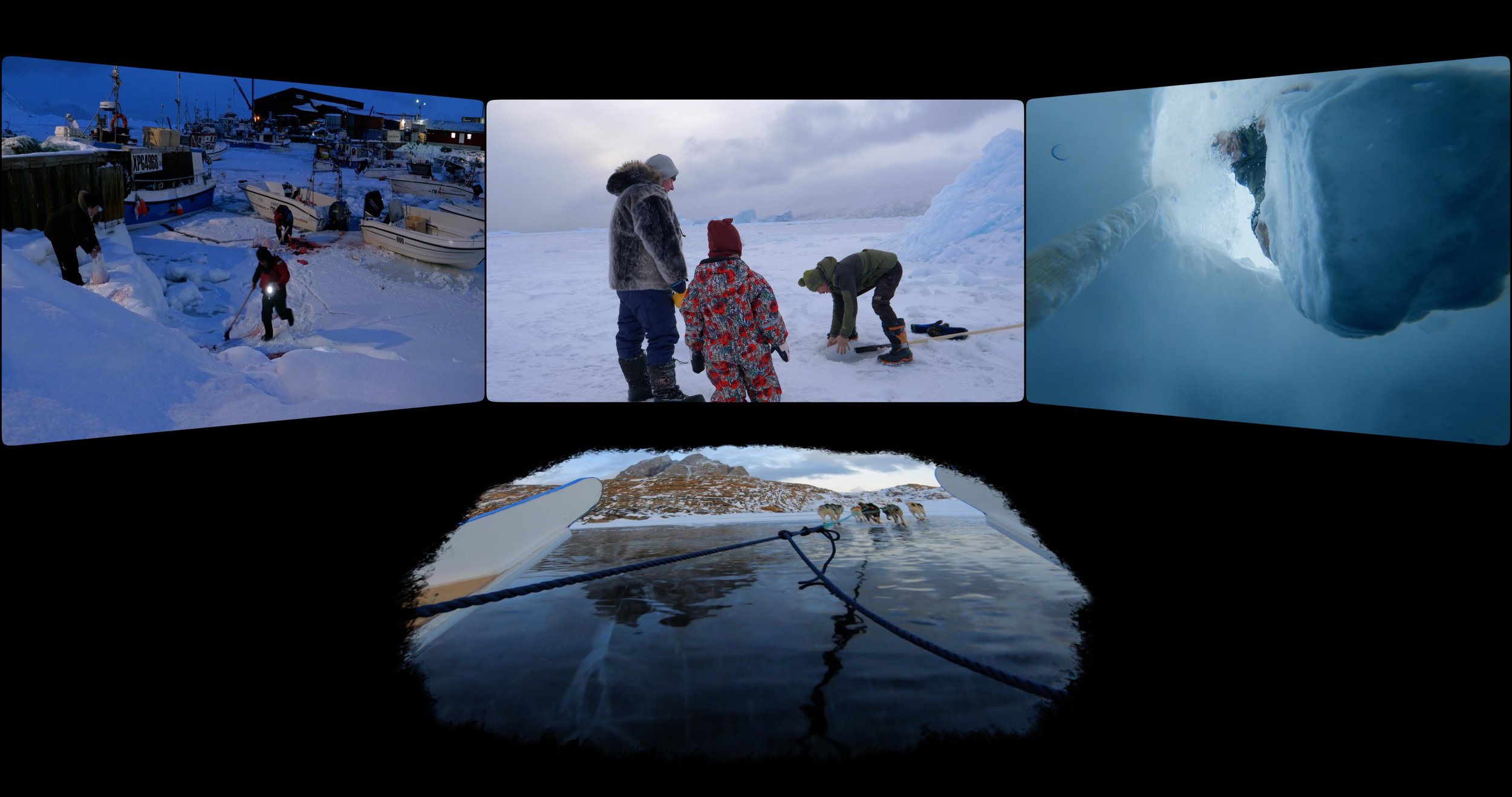


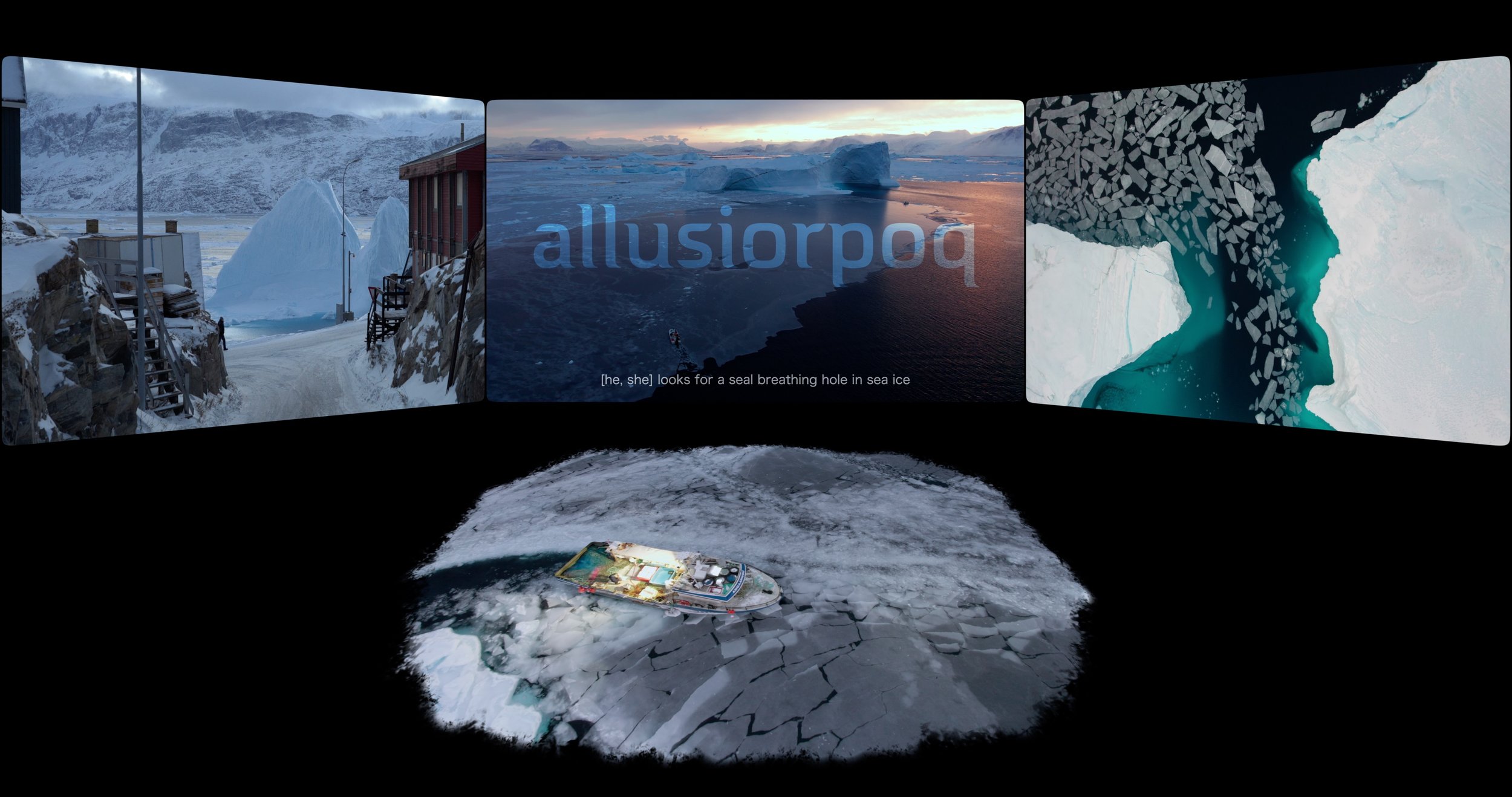
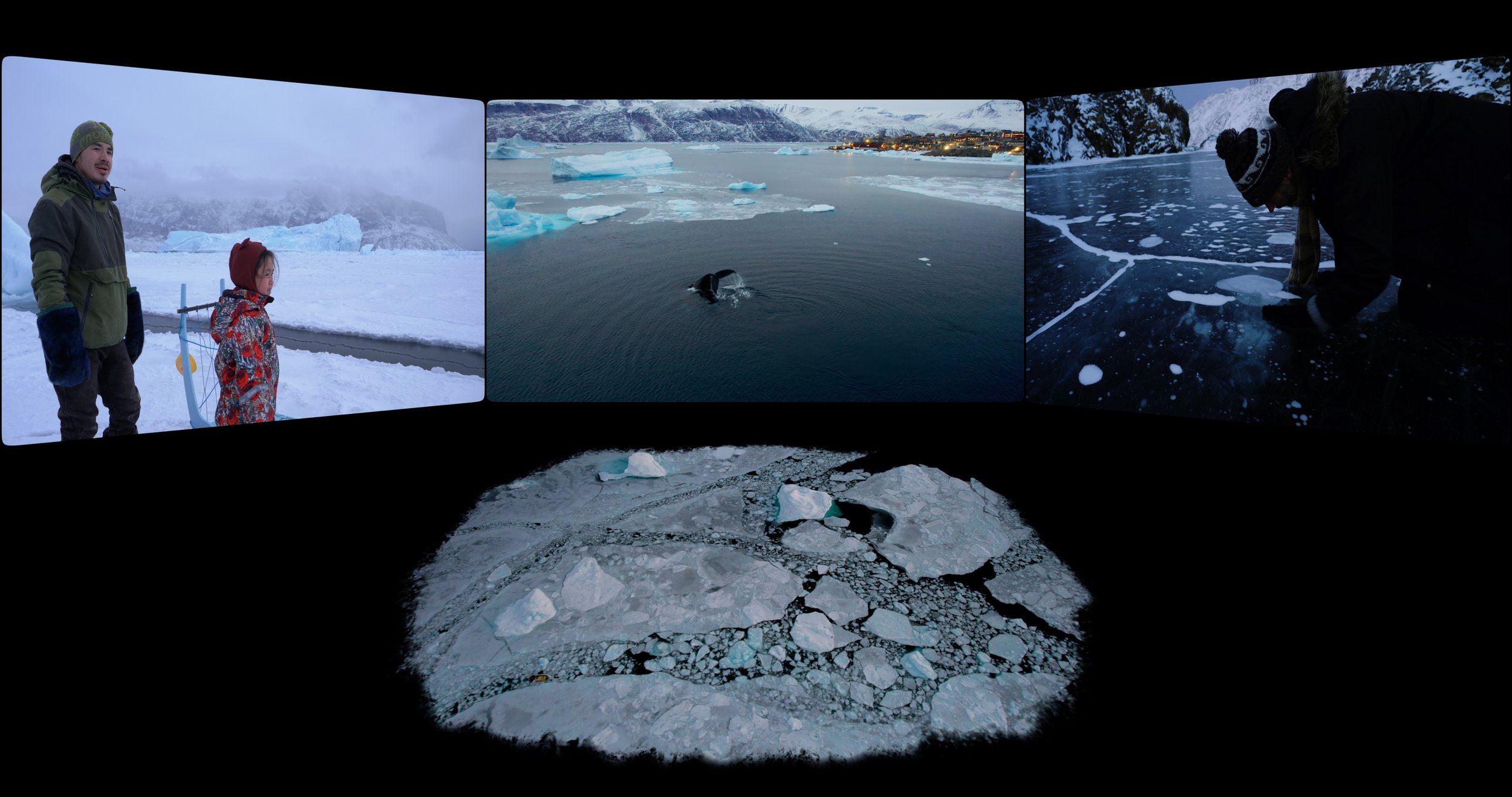
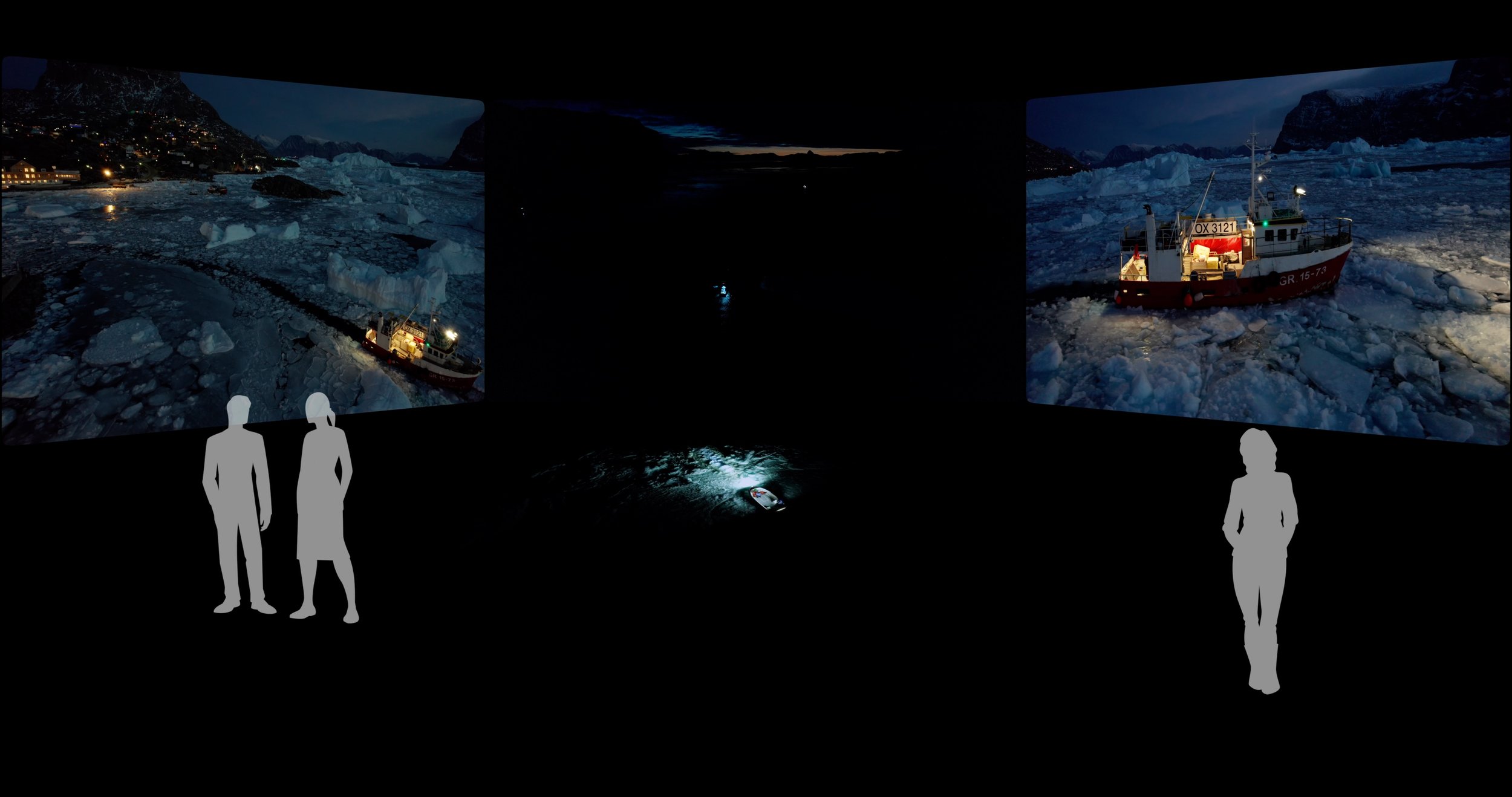
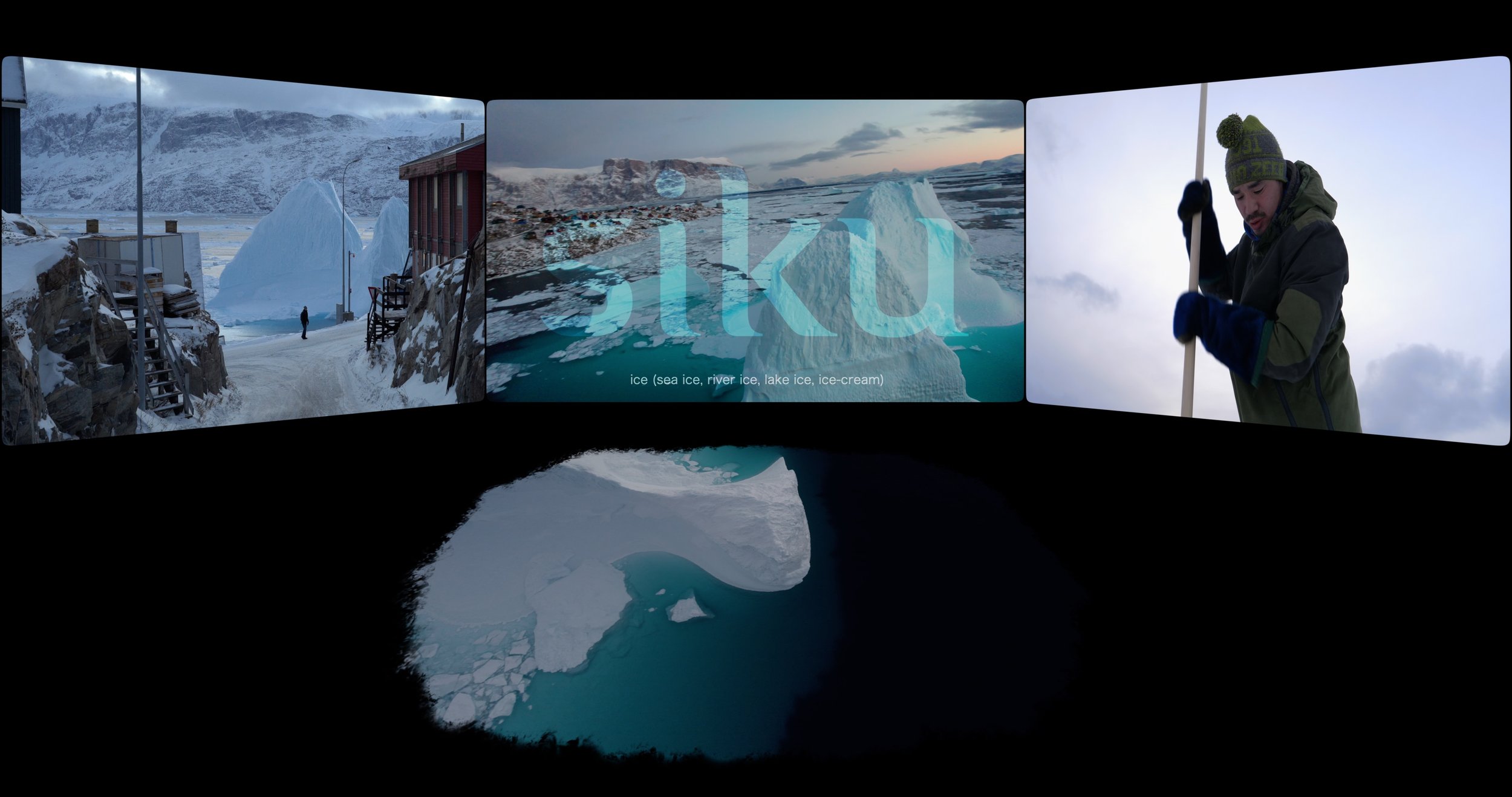
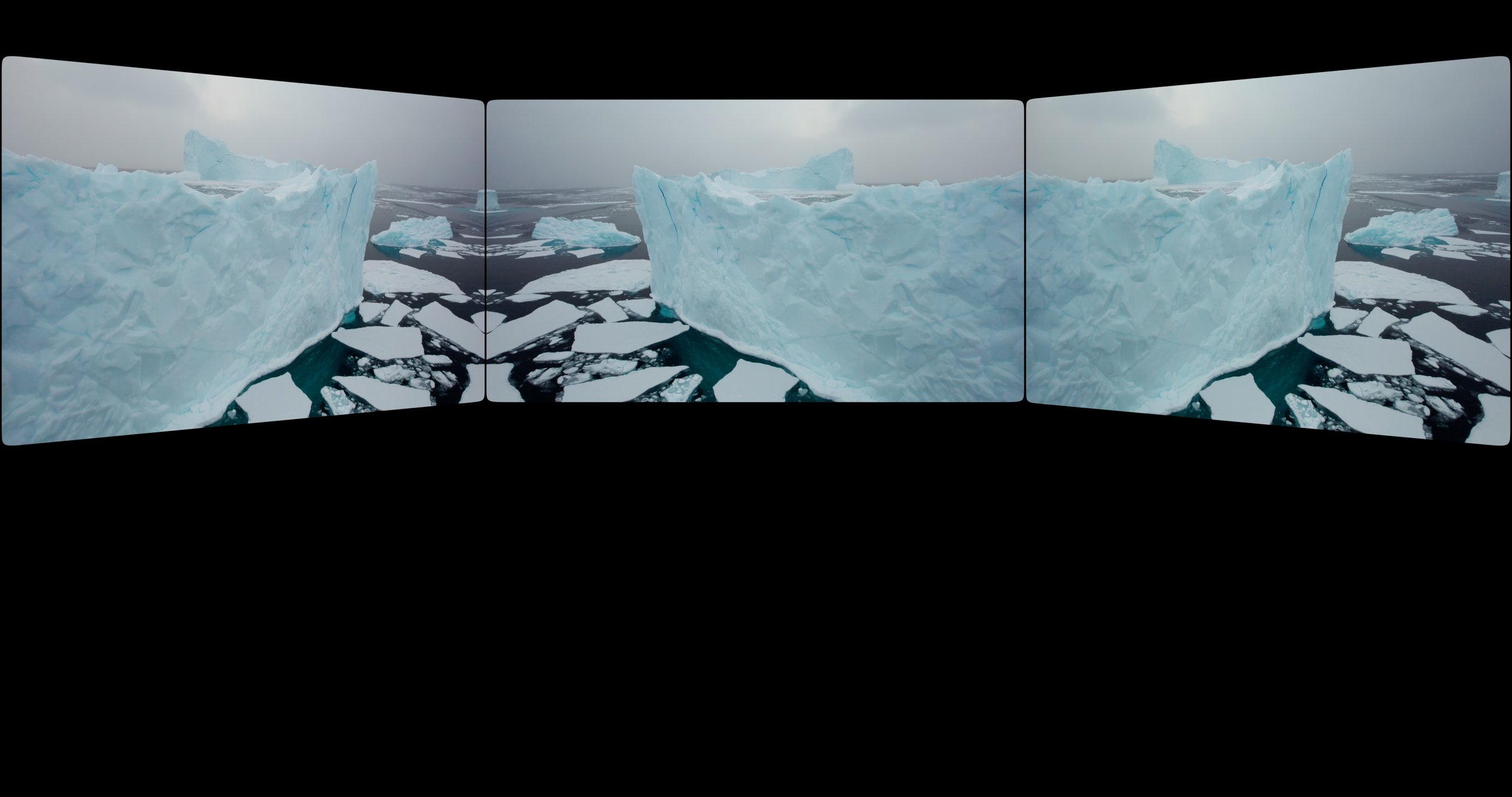
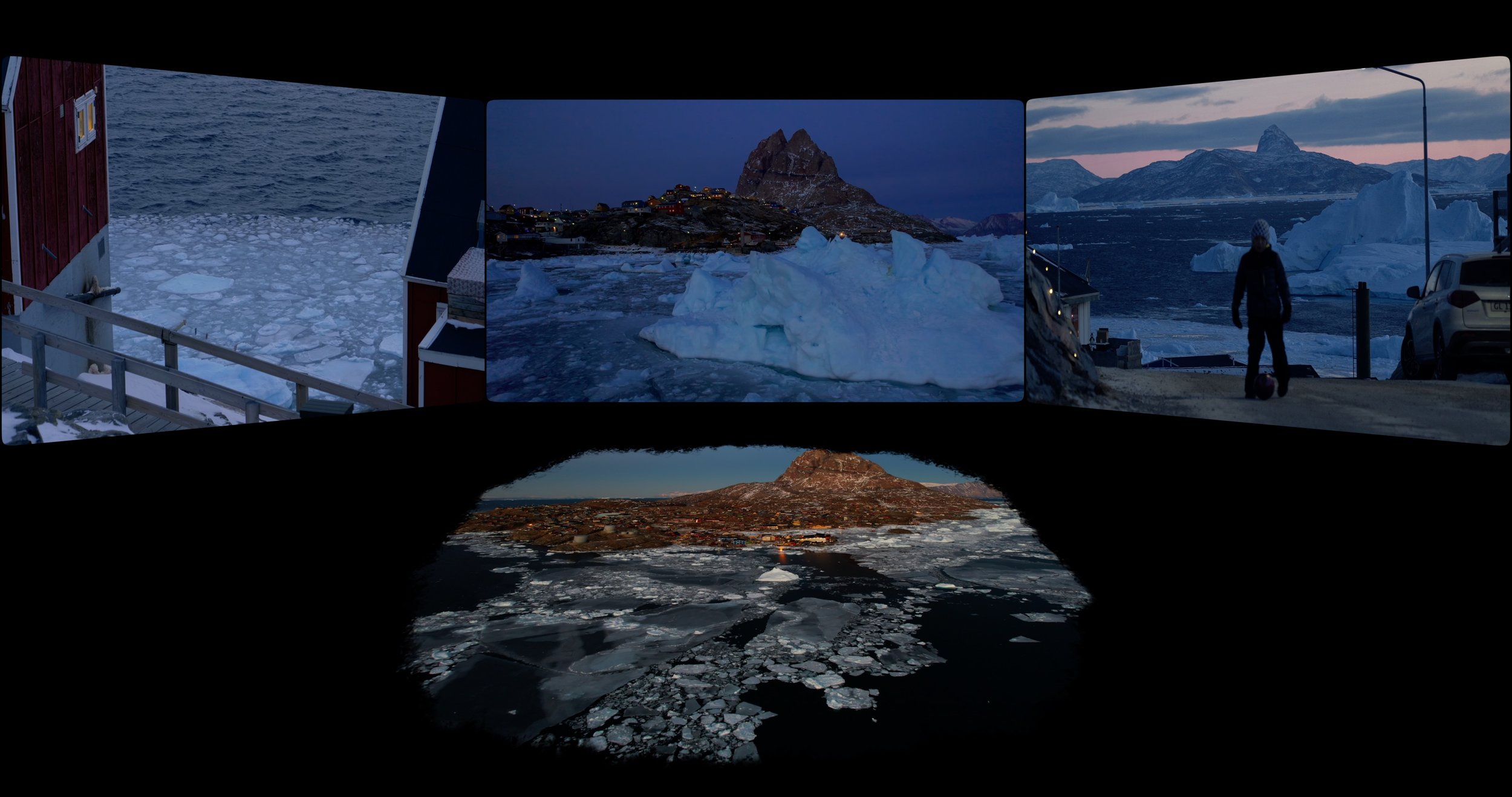
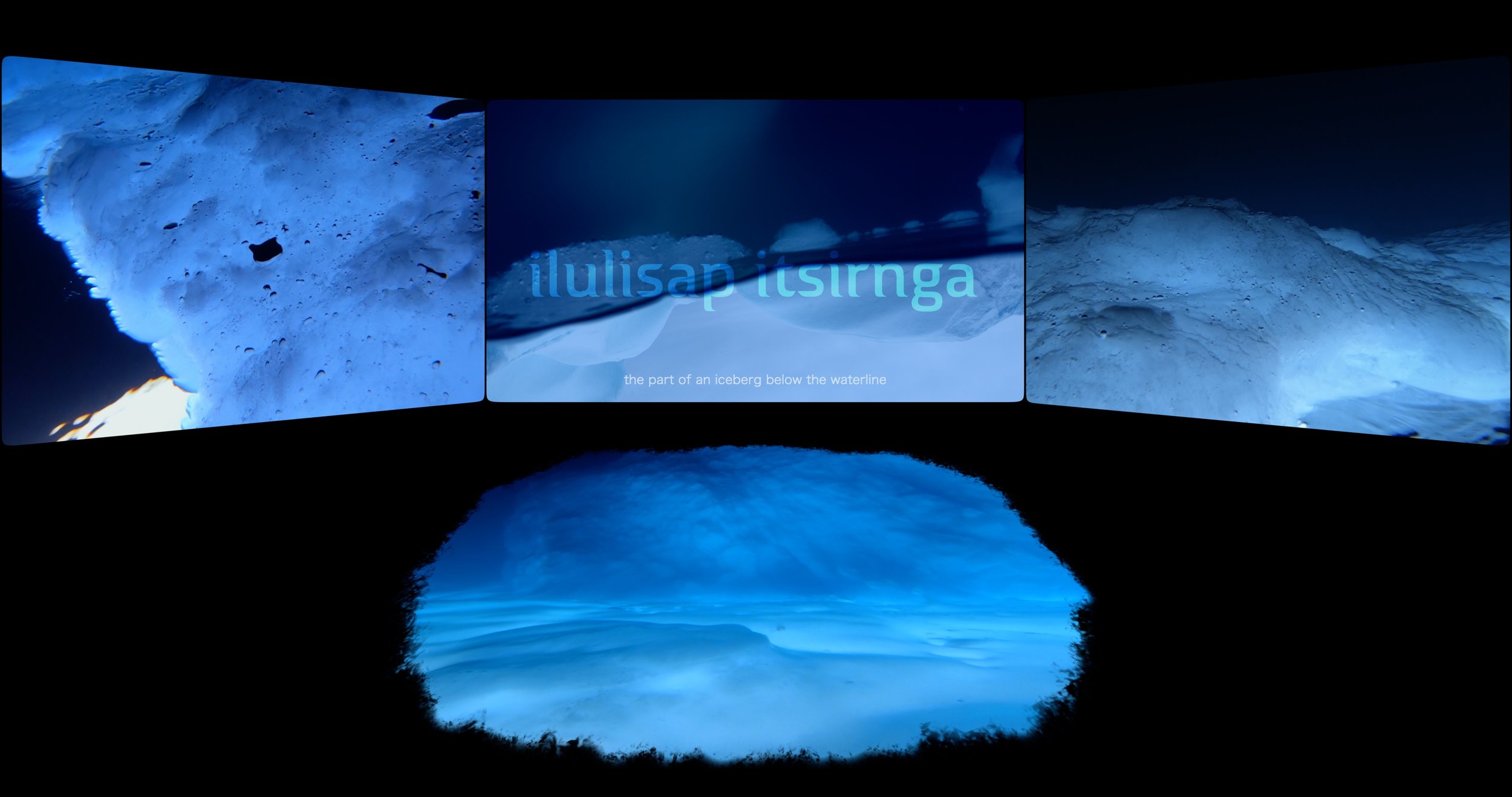
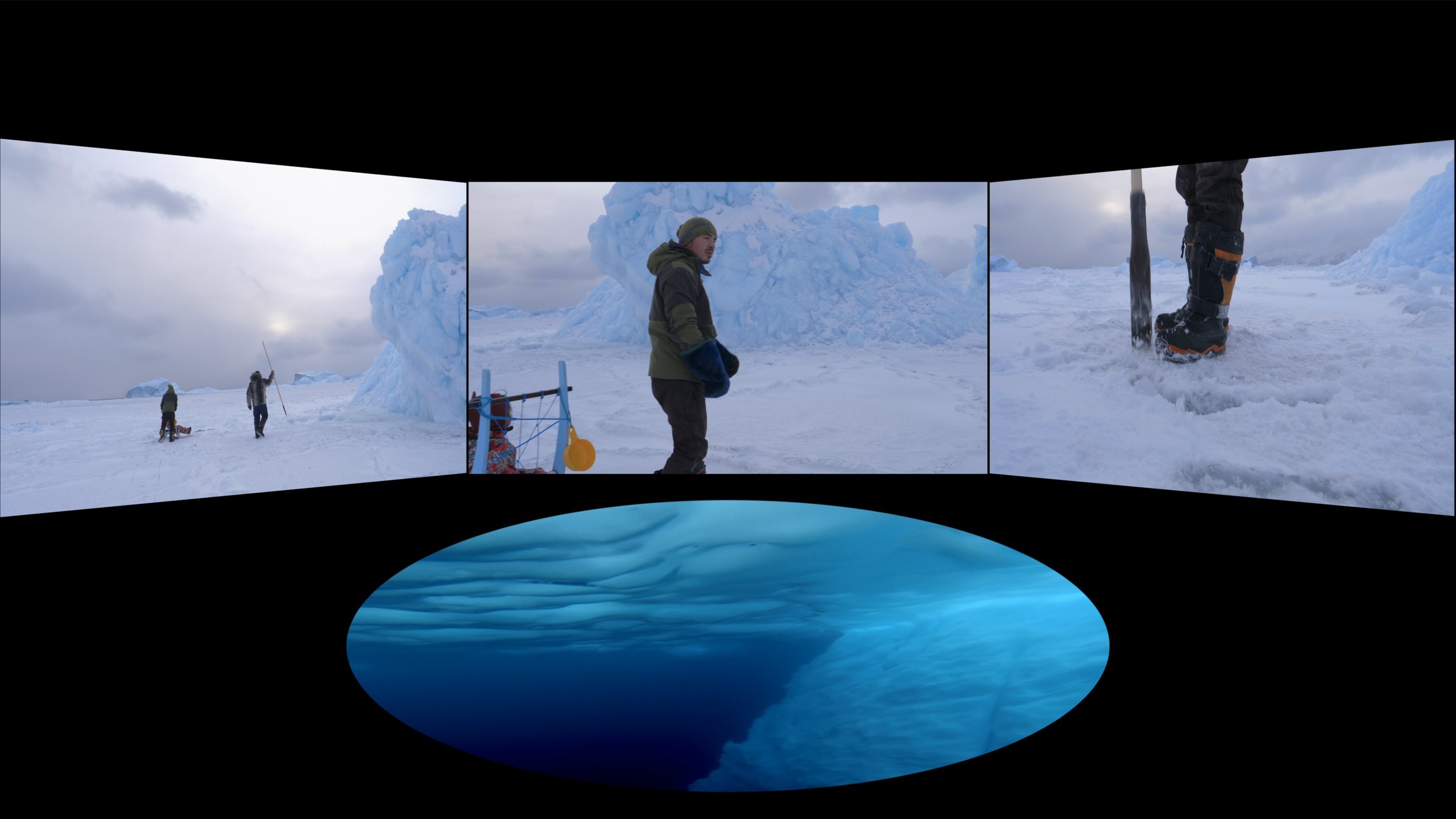
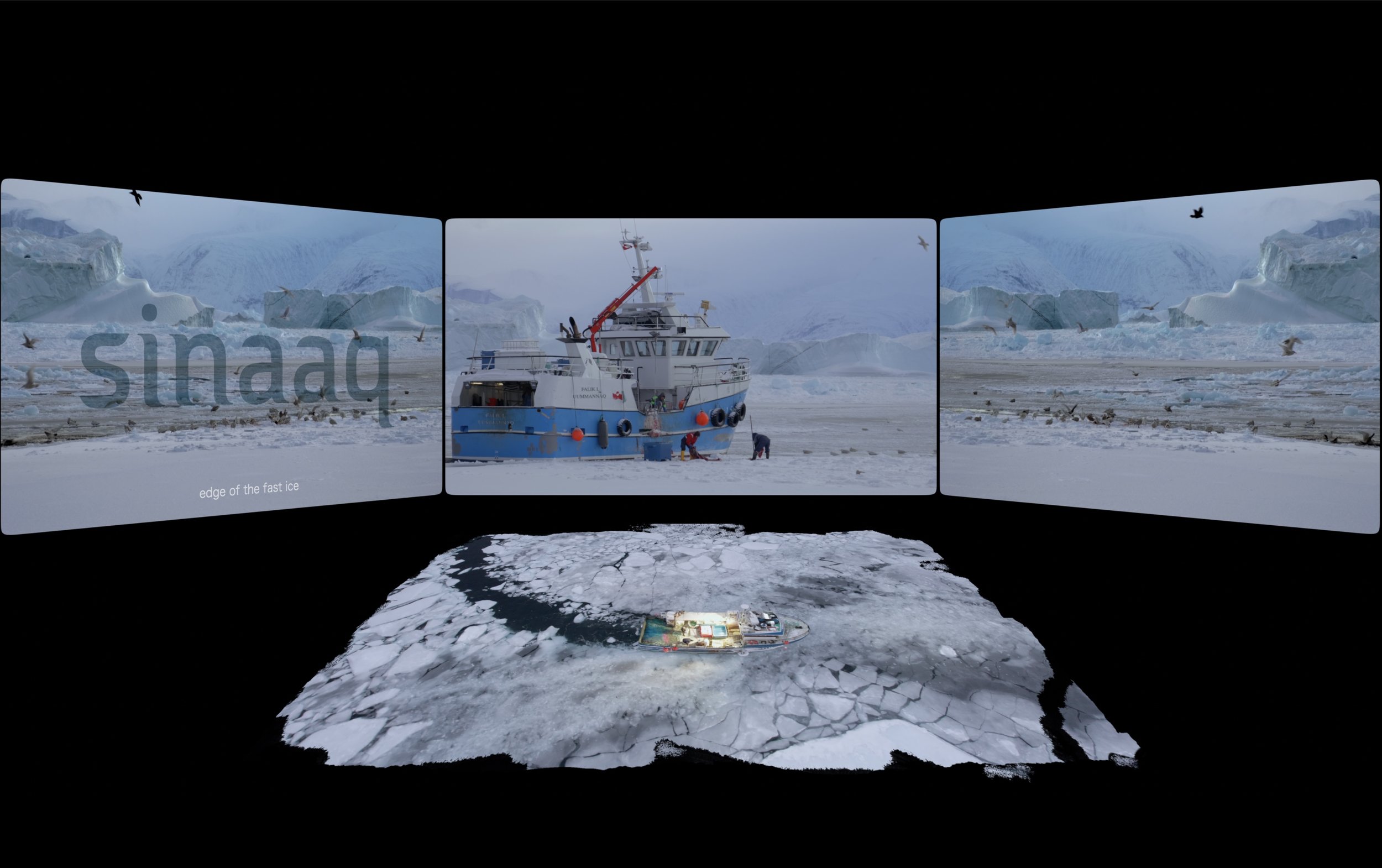
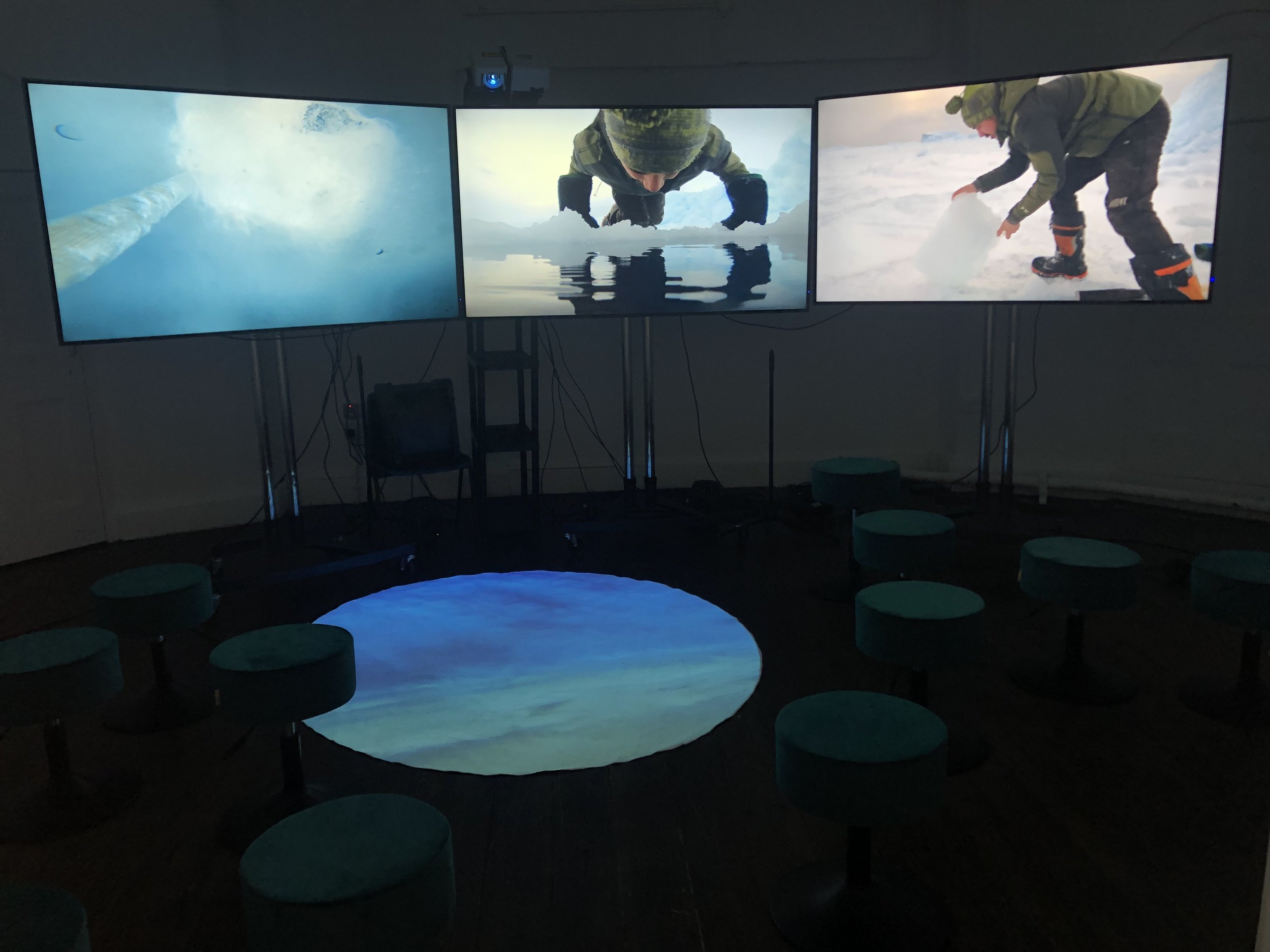
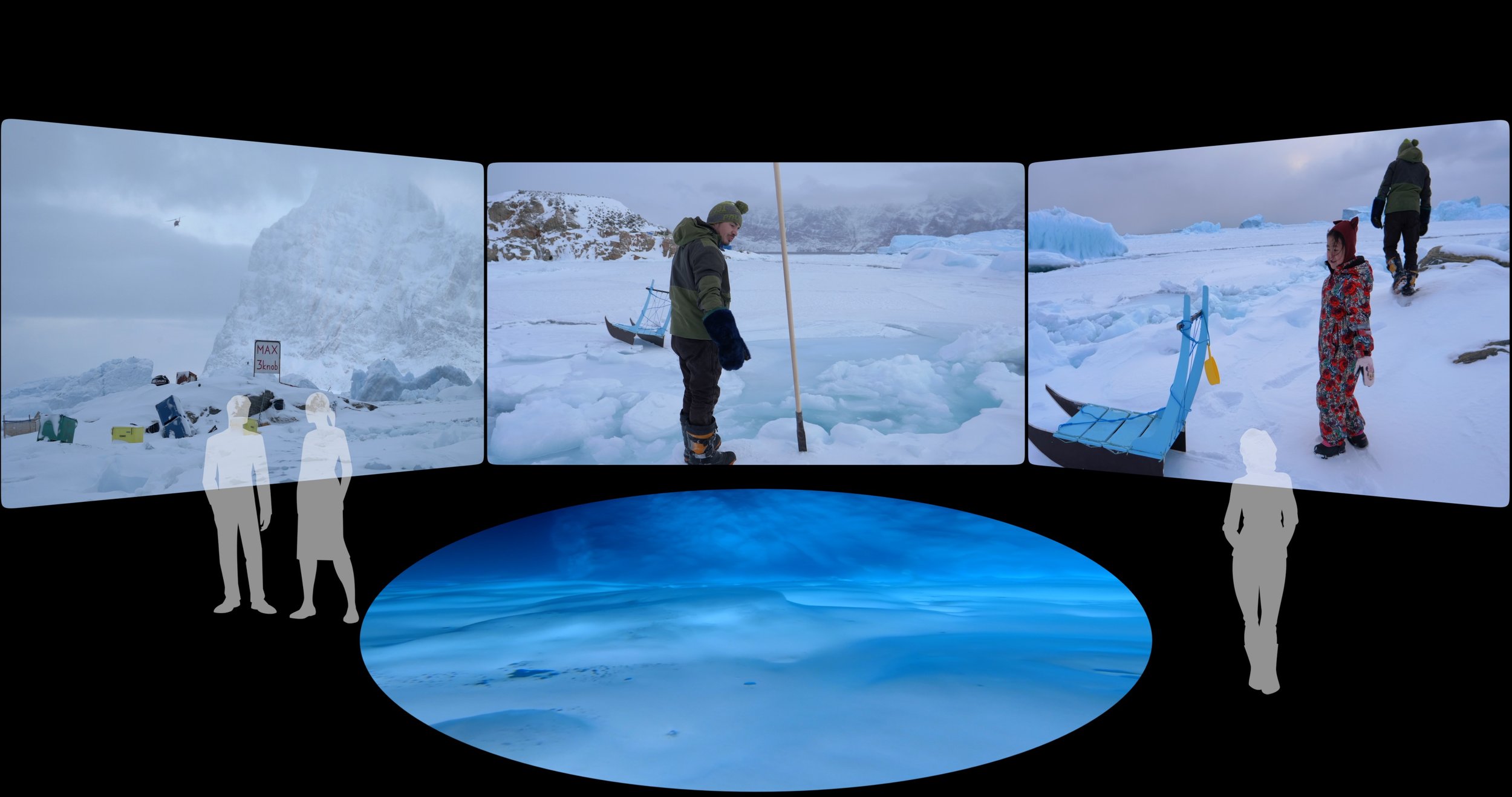

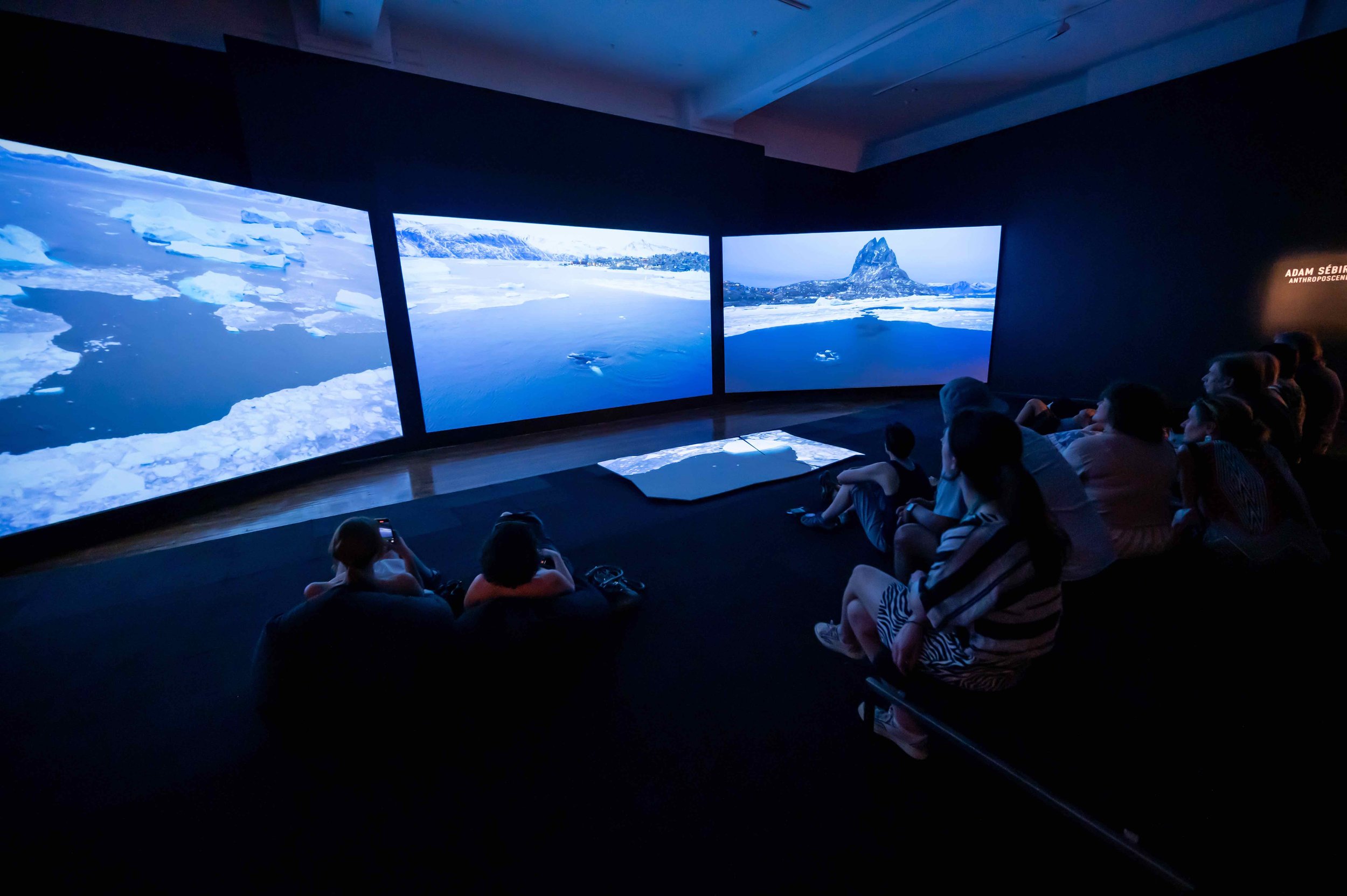
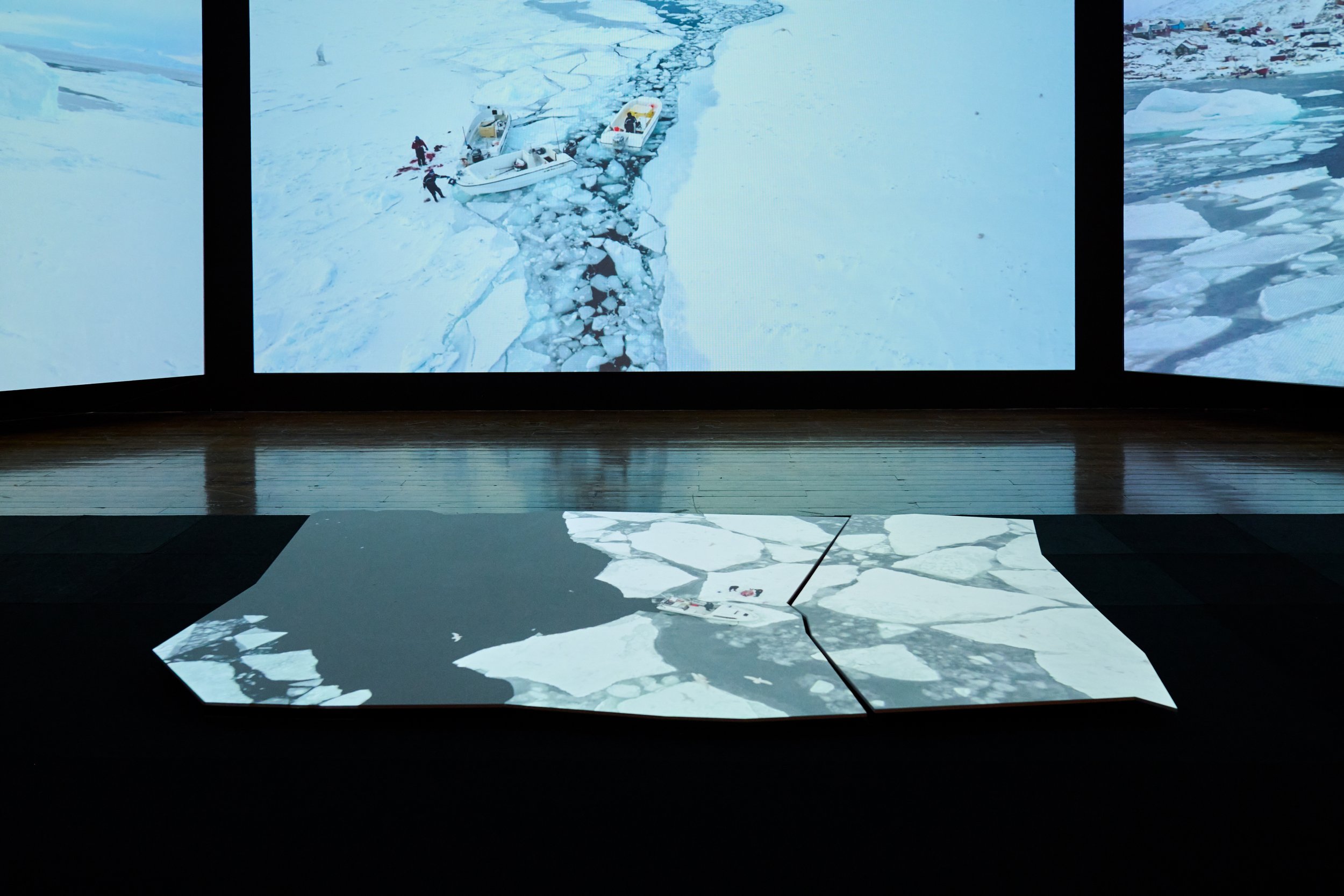

PRODUCTION CREDITS
Made with grateful thanks to the people of Uummannaq, especially Ann, Anton, Erik, Martin, Nellie, Pavia and Poul.
Martin Disley (sound design) martindisley.co.uk
Martin Fondse (composer/piano/iciclophone) martinfondse.com
Adam Sébire (film, location audio & editing) adamsebire.info
Scientists’ ice audio samples collated by Peter Nienow, Professor of Glaciology at the University of Edinburgh.
Lexicographic sources: Michael Fortescue’s West Greenlandic, 1984; and
Nicole Tersis & Pierre Taverniers' Two Greenlandic Sea Ice Lists and some considerations regarding Inuit sea ice terms, 2010. NB. there are many variations to these polysynthetic words — regional, personal, expressive (and now even climate-driven);so the film’s visual lexicon should not be considered definitive.
Adam’s research & filming trip for this work was part of an Art Arcadia Remote Residency. You can find those weekly blog posts on the Art Arcadia site.
VERSIONS / SCREENINGS / SCREEN SHAPES
Australian première at Fremantle Arts Centre, part of the Perth Festival exhibition curated by Glenn Iseger-Pilkington, “Polarity: Fire & Ice”, 10 Feb–28 Apr 2024. Premiered at Edinburgh Science Festival, Scotland, 1-16 April 2023 in Glacial Narratives (Curator: Mary Walters) at Custom House, Leith.
NB. The fourth (floor) projection can easily be made to any custom screen shape (masked from a 16:9 original) but angular / ice-floe shapes are preferred. Sound requires a separate subwoofer. Shorter, HD, or translated versions can be negotiated (email for a Vimeo preview link to the entire film).
JUST COMPLETED!
In January 2025, Sikoqqinngisaannassooq, a documentary that explores what sea ice means to the indigenous residents has just been completed and can accompany the exhibition as an educational resource once the film festival exclusivity period is over. A teaser (the first minute of the opening sequence) is here:
anthropoScene VIII : Escape Velocity (2023)
Vertical Video (9:16, 4K25p, stereo, 3mins30sec) and (optional) digital print.
Music composed by Martin Fondse. Preview below. Première: Jan 2023.
A frozen Arctic lake.
Methane bubbles loiter beneath its scarred surface.
A man tries to cross, but falls hard on the ice.
A short meditation on our relationship with our planet
(and the desire by some to take flight from it altogether).
The work was provoked by hubristic arguments from certain self-proclaimed "technovisionaries" that our species' regenerative future does not lie on Earth. Theorist Douglas Rushkoff calls this 'The Mindset' — "a belief that with enough money and technology, wealthy men can live as gods and transcend the calamities that befall everyone else. It’s a way of applying the 'exit strategy' of a Silicon Valley startup to civilization itself."
In August 2024*, stratigraphic scientists are expected to declare that we, once passengers, now crew of spaceship Earth, have departed the benign Holocene epoch and crossed the frontiers of the Anthropocene.
But we can never achieve 'escape velocity' from nature; it is us and we are of it. Our regeneration — and perhaps our redemption — may come not through taking flight from our injured planet, but from being brought back to Earth … with a thud.
Exhibitions: Selected for Den Nordnorske Kunstutstilling art prize tour throughout 2023 (opening Bodø 14 Jan and closing in Harstad, Jan 2024).
Screening in Burrinja Climate Change Biennale (BCCB), Melbourne, Australia, Feb 2023; Fremantle Arts Centre 10 Feb - 28 Apr 2024. Winner of the Royal Geographic Society’s Earth Photo Prize (1st prize in the video section), on display in London EC1, 15 June - 23 August 2023.
▼ Still (120cm x 80cm, Edition of 9 - 80:20 Artist Agency) A$2500 | Link to 44” teaser is here | 3’30” film (private preview) ▶︎
"We will use technology to tame nature," he promised.
(And to insulate ourselves from the events we ourselves caused — though this was left unspoken.)
"If all else fails," he continued, “then we will colonise Mars instead."
But our technovisionary never achieved escape velocity.
He had left the Holocene — and was now striding confidently towards the Anthropocene —
yet he could not escape from nature: he was of it, and it was he.
anthropoScene IX : Solastalgia (2023)
Video 3mins30sec (16:9, 4K25p, HDR/HLG). 2ch audio (+ optional digital stills).
Music: Luz by Martin Fondse.
Art Award winner at "Climate Change - The Grand Challenge”, Venice (IT) 1 Dec 2023; finalist in the 2024 Henki Art Prize, USA*; streaming for the UN International Year of Glaciers’ Preservation (IYGP) 2025 Plenary at the WMO Geneva, 13:00 21 Jan 2025; screening at Agir pour les Glaciers in French Alps 20-22 Mar 2025 for the 1st UN World Day for Glaciers.
“Solastalgia” is Australian philosopher Glenn Albrecht’s term that describes feeling alienation or distress in familiar or beloved surroundings due to environmental desolation – such as that caused by climate change.
—
A dying mountain glacier; its body shrouded to stem the loss of ice. Yet the melt continues.
The humans have tried to insulate it, but might the treatment be worse than the illness?
On the opposite side of the valley a steam train, icon of the fossil-fuelled Industrial Revolution, passes through a landscape that was filled with this glacier’s ice a mere century ago.
Filmed Summer 2022, when Swiss glaciers lost 6% of their mass; the largest melt on record.
*Jury comments: “Adam Sébire’s film poignantly captures humanity’s impact on a fragile Swiss glacier, its shrouded ice evoking a haunting sense of nature in distress. Depicting water in its various forms, ice, liquid, and steam, the work reflects the urgency of climate change. Its ethereal beauty and profound message leave a lasting impression.”
anthropoScene X : in the Eye of the Anthropocene (work in progress, 2021-25)
Video polyptych, approx. 15 mins.
Only 1,300km from the North Pole, Svalbard’s abandoned 'Santa Claus' Mine (Gruve 2B) spills mineral spoil down former glacial valleys. As snow and ice retreat, traces of coal fallen from the collapsed aerial cableway reveal an eyelid: a slumbering creature on the verge of awakening.
Combining digital effects and documentary footage this video uses multiscreen forms to explore Svalbard’s extractivist past, rapidly melting present and more-than-human future. In imaging the ‘landscape' as alive the work eschews both anthropomorphism and the ‘apocalyptic sublime' to instead consider our environment as an active agent: one that humans have stirred with unpredictable consequences.
As some theorists urge us to embrace ‘dark ecology’ and the ‘monster’ we have created — to 'stay with the trouble’ — the work seeks a mythological, expanded cinema approach. It draws on aesthetics of Hieronymus Bosch’s triptychs to think beyond human agency to the nonhuman world and the active forces that we have set in motion but now struggle to comprehend, in the planet’s most rapidly-changing environment.
Norway has promised to cease coal mining in the Arctic within seven years, but already Svalbard is warming 1.7°C per decade: seven times the global average. In 2024, stratigraphic scientists declined to formally ratify our epoch as "the Anthropocene”, in part because the proposed start date, a “golden spike” of radioactive sediment from the 1950s, was considered too specific to represent the changes of era, in which a specific group of humans have profoundly altered the equilibrium of the Earth System over several centuries.
Filmed over the course of four seasons whilst resident at Galleri Svalbard.
Expected completion: 2025.
anthropoScene XI : Mammoth (2023)
Film: Adam Sébire / Music: Martin Franke
Duration: 5’59” 4K25p, English captions, stereo audio
Completion: October 2023. Preview below. Exhibitions: Simultan Festival XVIII (Timisoara, RO – European Capital of Culture in 2023).
Mammoth is a video art work superimposing two climate engineering (geoengineering) projects that are currently funded & underway.
One is Pleistocene Park and Colossal Inc.'s proposal to genetically engineer woolly mammoths back from extinction, reintroducing them to melting Arctic tundra to “re-wild" it as before Homo sapiens arrived. This dramatic intervention in nature, its proponents hope, would lock thawing methane deposits back into the permafrost, averting a disastrous climate tipping point.
The other is Climeworks’ carbon dioxide removal plant under construction in Iceland, capable of direct air capture of 4000 tonnes of CO₂ annually. It's a prototype for a larger version, codenamed Mammoth, which is due to be completed in 2024.
These two “mammoth” entrepreneurial geoengineering endeavours are set in counterpoint. The story is told over documentary footage showing construction of the carbon capture machines in Iceland; while in voiceover from some future vantage point an A.I. recounts a speculative history of the de-extinction project, resulting in humanity's unforeseen demise from the gene-modified mammoths’ own methane emissions.
—
The music by Martin Franke samples percussive sounds made by “playing” the decommissioned F60 coal conveyor in eastern Germany, once the world’s largest moving machine.
anthropoScene XII : a work-in-progress (2024) (see top of this page)
Critical / Media Reception
St. Andrews University’s Centre for Energy Ethics released a podcast with Adam discussing his AnthropoScenes series, art, ice, geoengineering and global warming on 26 March 2021. You can find it as a podcast at https://allaboutenergy.podbean.com or listen/download below. Interview runs 12’36”-56'45":
“In … Sébire’s work this limit [of the human] is articulated as a topographical extreme which challenges the extent of human control, evoking the topos of [Samuel] Beckett’s Breath and Embers to articulate a position that ‘contests’ as Rosi Braidotti puts it, ‘the arrogance of anthropocentrism’ and leads us to consider ‘life in its nonhuman aspects’.
Derval Tubridy, “Terra Incognita: Beckett’s
Anthropo(s)cenes in Contemporary Art” in Beckett and
Ecologies, eds. Thobois, McTighe, Johnson (London:
Bloomsbury, 2024); conference paper, Samuel Beckett
& the Anthropocene, Trinity College, Dublin, 2020.
Artist Adam Sébire integrated an equation from a @sciencemagazine paper by Dirk Notz & @JulienneStroeve in his art work "Adrift (∆Asea-ice)", a video triptych installation. It premiered at @maxplanckpress in Munich. Video & info: https://t.co/hAz7L52Ajh #climatechange #videoart pic.twitter.com/Tbsynk2mUo
— Max-Planck-Institut für Meteorologie (@MPI_Meteo) November 1, 2019
“…time appears to be unsynchronised, dislocated, and the work provides an opportunity to reflect on a central conflict in the era of the climate crisis: Between humans' short lives and intensive consumption of resources, and nature's slow, inexorable and eternal process. The work is accompanied by a soundtrack from an instrument made of recycled materials, and although the tone is mournful, reuse and this circular economy point the way out of the climate crisis' most powerful and frightening consequences.” — Critics’ Prize rationale for Tideline (March 2021).
What does ΔAseaice = dFnonSW,in / dECO₂ x ΔECO₂ mean?
— What Art Can Do (@WhatArtCanDo) December 21, 2020
Adam Sébire explores his own contribution to the warming climate in anthropoScene IV: Adrift (ΔAsea-ice)https://t.co/z5V2BeGYwH
Glasgow Science Centre Q&A with Adam Sébire & sea-ice scientist Prof. Dr. Dirk Notz, recorded 30 Sep 2021 for their Greenhouse Festival. (Starts at 11:50)
Exhibition poster featuring Adrift still.
Adam’s photos on show for Climate Outreach at, Sydney Opera House 04.23
The #ArtOfEnergy Event is over but you can still check out the virtual galleries!https://t.co/LWJP5BdJHv
— Energy Ethics (@EthicsEnergy) March 1, 2021
Explore the wonderful works of our invited artists & competition shortlist, including the inaugural Art of Energy Prize-winning piece from Adam Sébire below!#EnergyEthics pic.twitter.com/0ehCHVyxsr
Interview with the Climate Art Collection, Berlin:
ABOUT THE ARTIST
Adam Sébire is an artist-filmmaker whose works focus on climate change. Having just opened his solo exhibition at the art gallery on Svalbard he found himself marooned in Norway by Australia’s Covid-19 border closures and has since become one of the Arctic’s 4 million human inhabitants.
Adam studied documentary at Australia’s AFTRS & Cuba’s EICTV, directing, editing & filming over two dozen documentaries from 1998-2012 for broadcasters including ABC, SBS & Al Jazeera. Since filming on the disappearing Pacific atoll nation of Tuvalu in 2003 he turned to exploring climate change, especially ice loss and sea level rise, via a Master of Fine Arts and then a PhD in moving image art in Sydney.
In 2014 he co-founded and directed the Vertical Film Festival in Katoomba, the first worldwide competition for tall-screen films and vertical videos.
His Roads to Nowhere solo exhibition was presented as part of Head On & Vivid Sydney; Galleri Svalbard hosted another solo show in 2020. AnthropoScene I: Breakdown was purchased by the UN’s climate change body (FCCC) in 2019. AnthropoScene II: Tideline won the 2021 Nordnorsken Critics’ Prize; AnthropoScene III: Hellishei∂i won 1st prize at St Andrews’ University Art of Energy prize while AnthropoScene IV : Adrift (∆Asea-ice) premiered in the Long Night of the Museums at Max Planck Institute Munich. Glasgow Science Museum programmed it and Feeling the Heat during COP26. And Oxford-based ClimateOutreach purchased rights to a number of Adam’s photographs to place them in Creative Commons.
His documentaries have been shown at film festivals including Hotdocs, Montréal World FF, Paris FF, Havana FF, Flickerfest, Tromsø and Sydney FF, while Echoes… premiered at the United Nations in New York. Australia’s Royal Flying Doctor Service & Sydney Opera House have commissioned numerous works from him.
Adam’s academic research explores the complex spatiotemporal dimensions of climate change via multi-channel ‘video polyptychs’.
SEE ALSO
Feeling the Heat (15 mins, 3-channel video, 2020)
Thermographic (heat sensing) video triptych exploring how climate scientists, working on the front line of a problem that's invisible to most of us, respond to it as human beings, as citizens of the planet? (Image from Wuhan Biennial) More →
Sikoqqinngisaannassooq (15mins, 4K HDR, filmed, edited & directed by Adam in 2025)
A remote Inuit community in Kalaallit Nunaat (Greenland) faces dramatic transformation of their sea ice by climate change. More →
All works ©2018-2023 Adam Sébire




